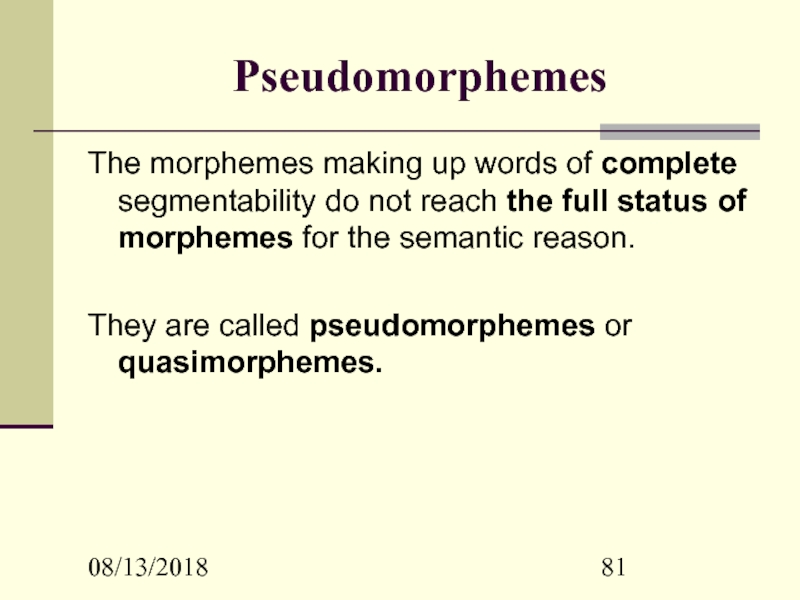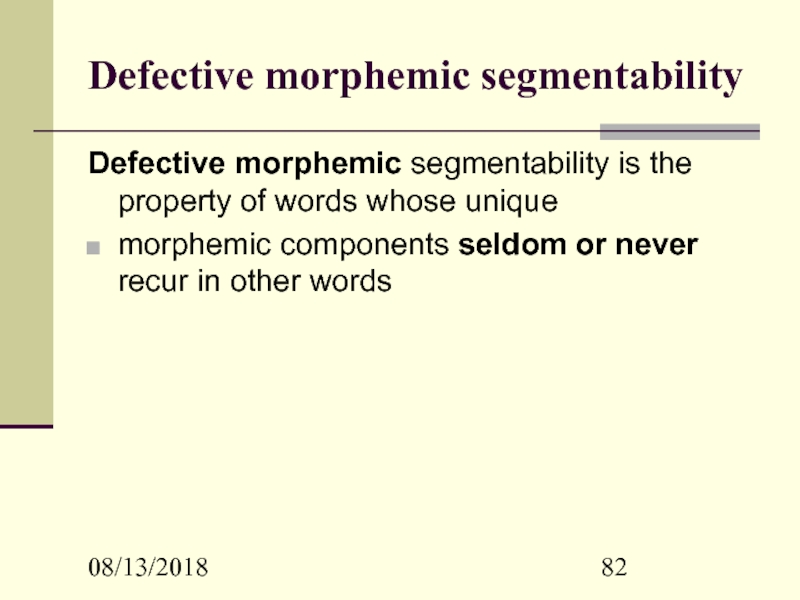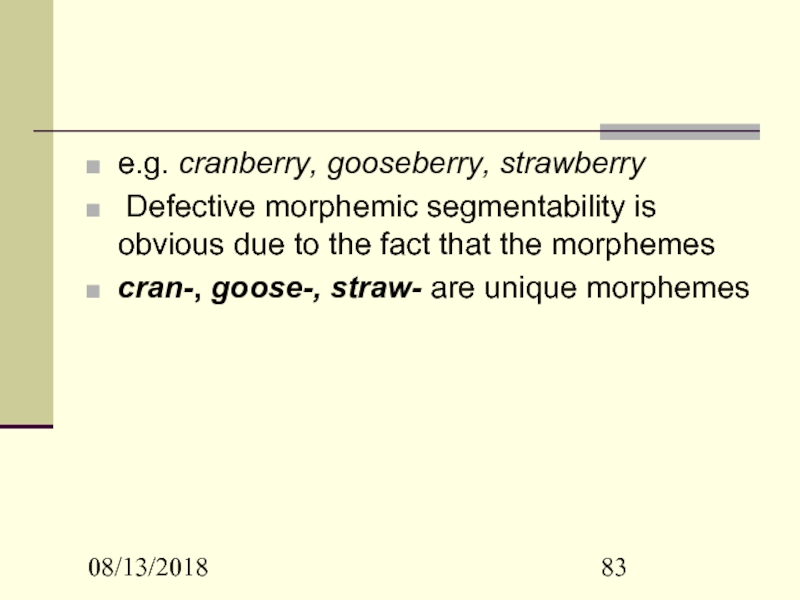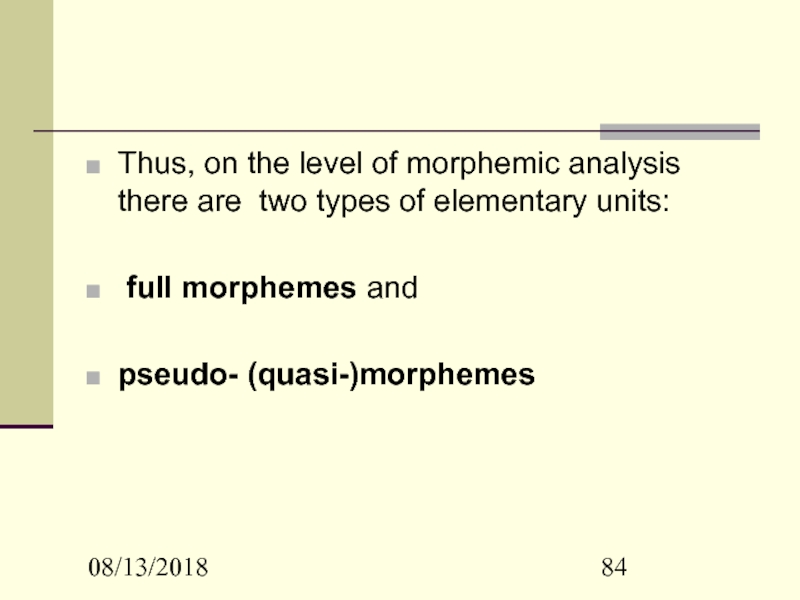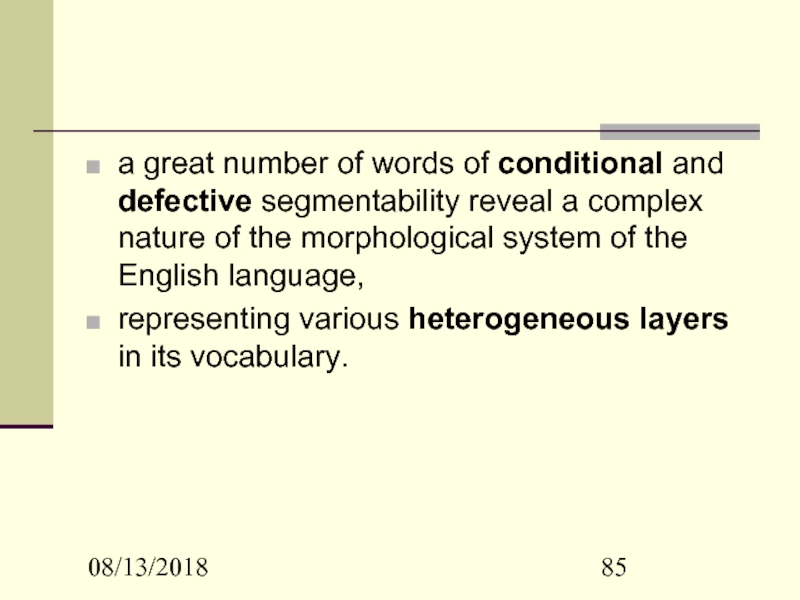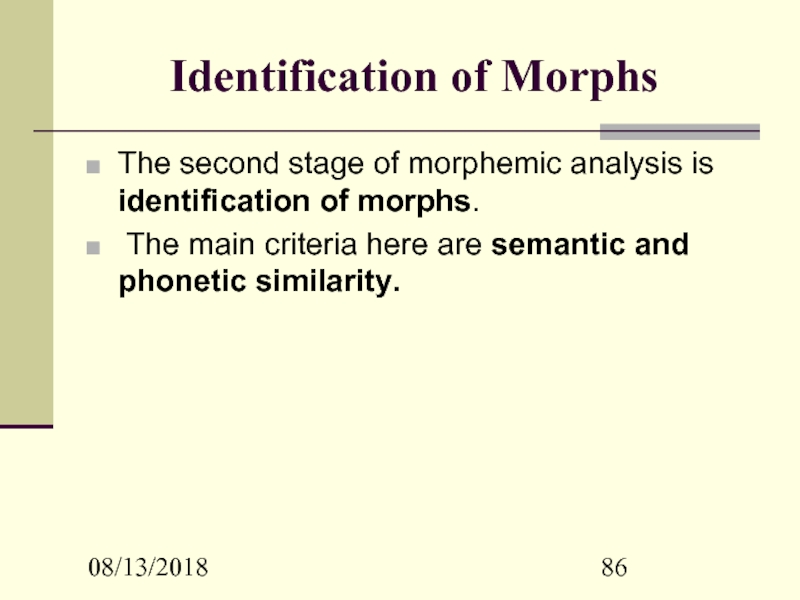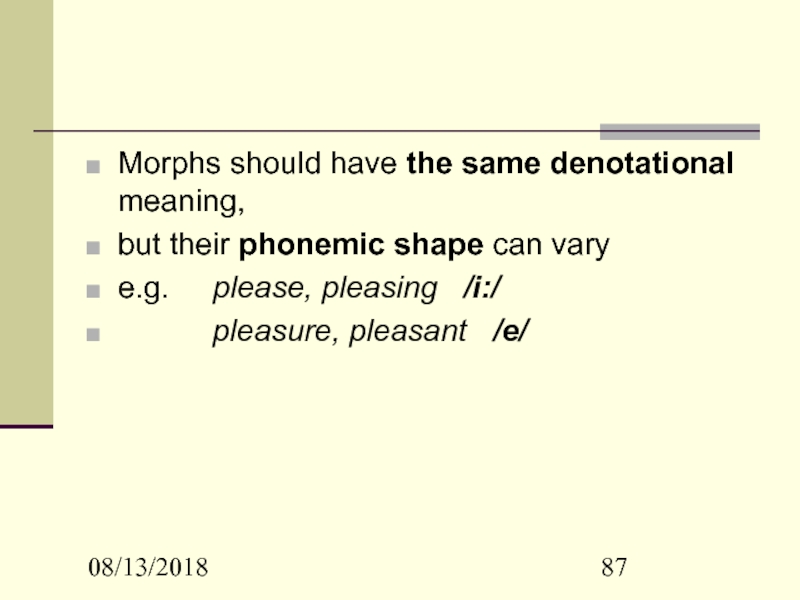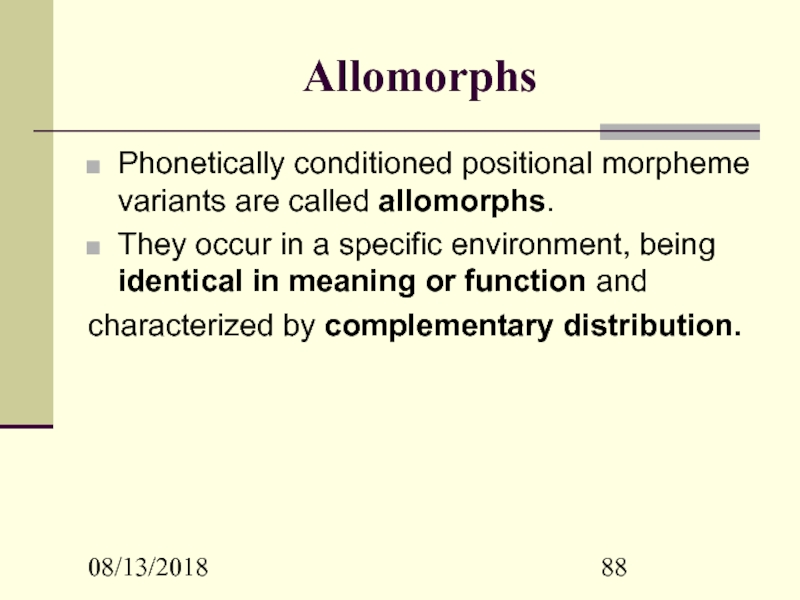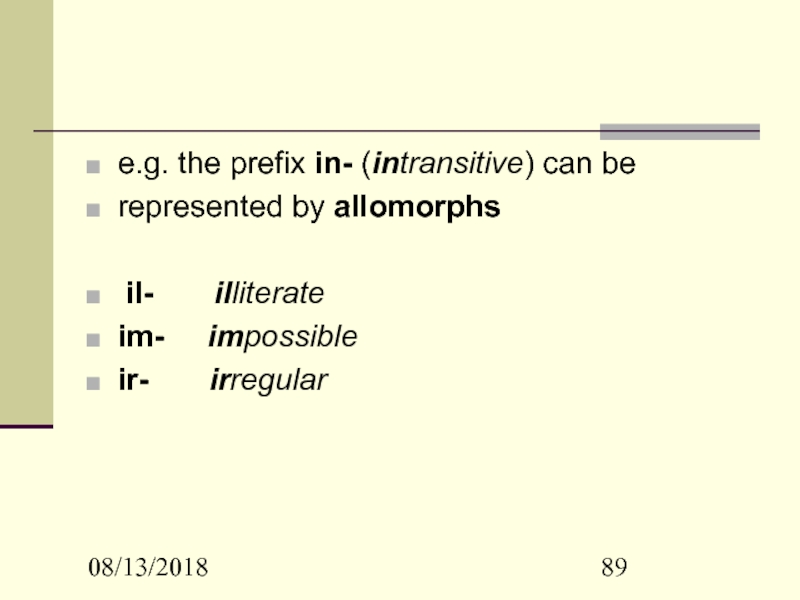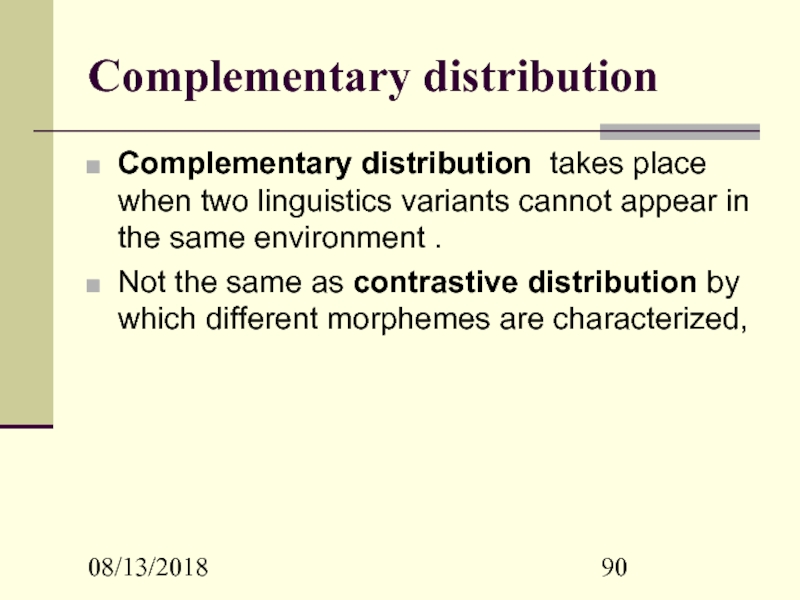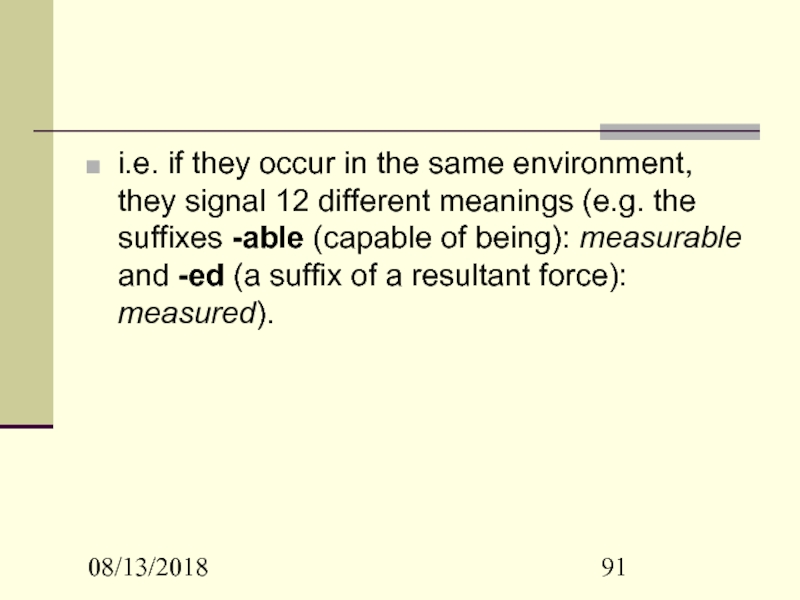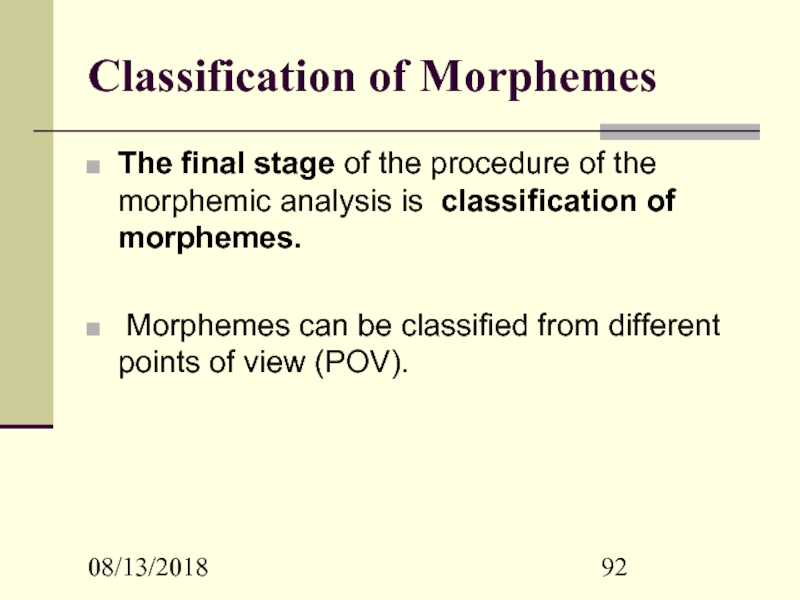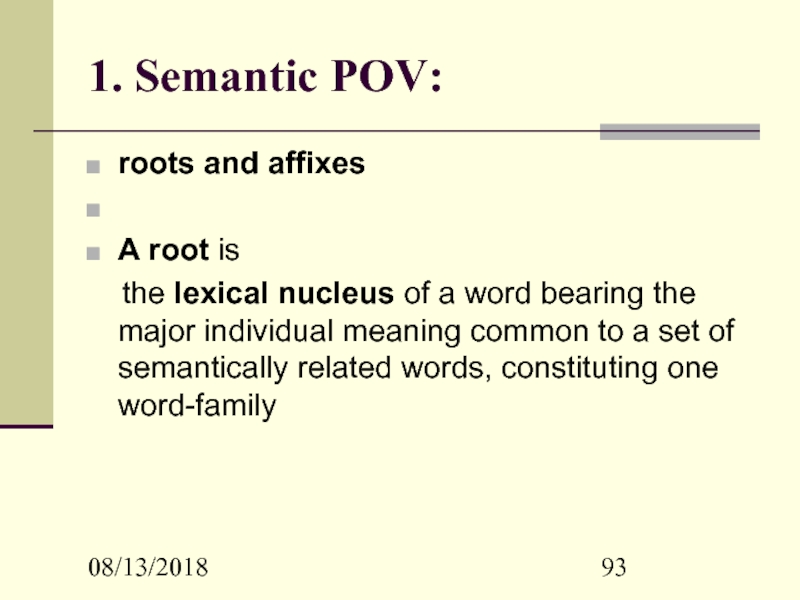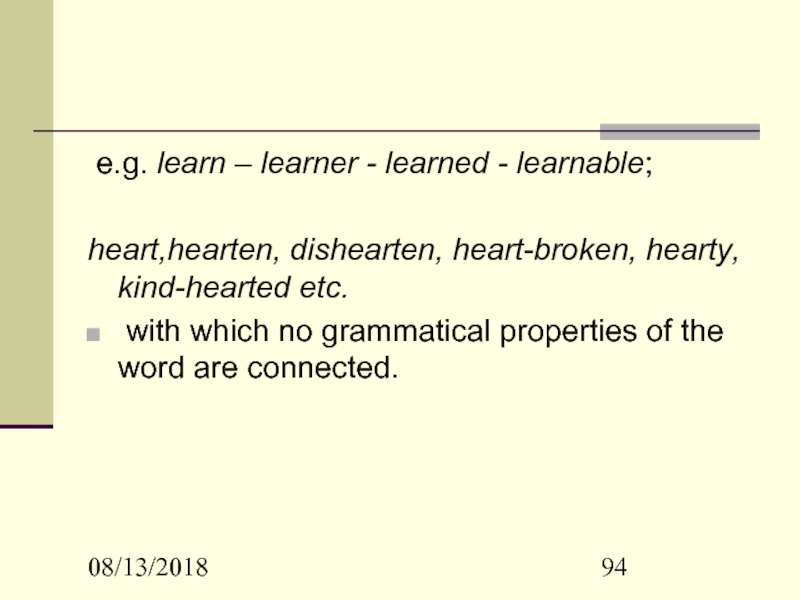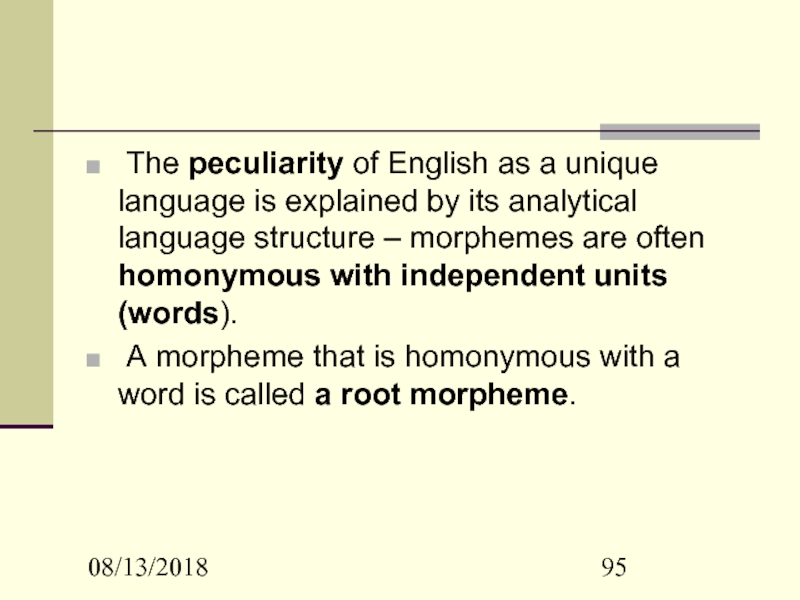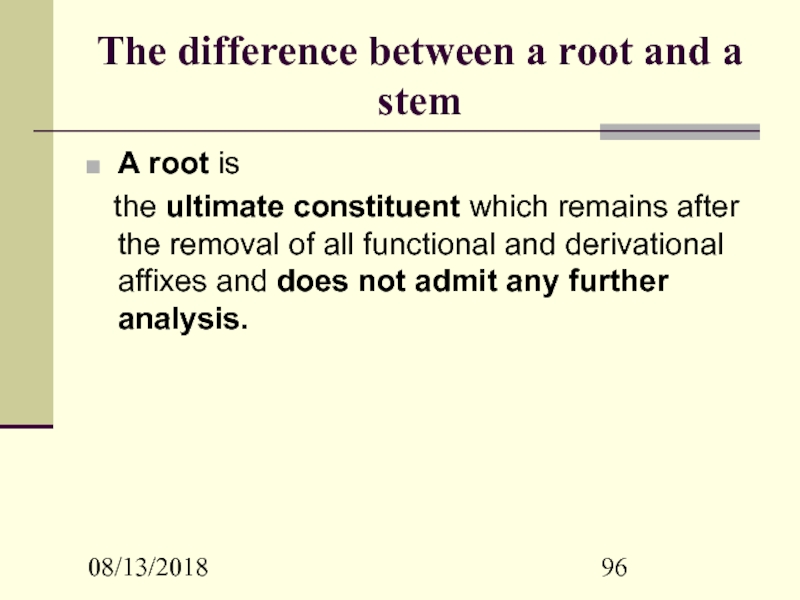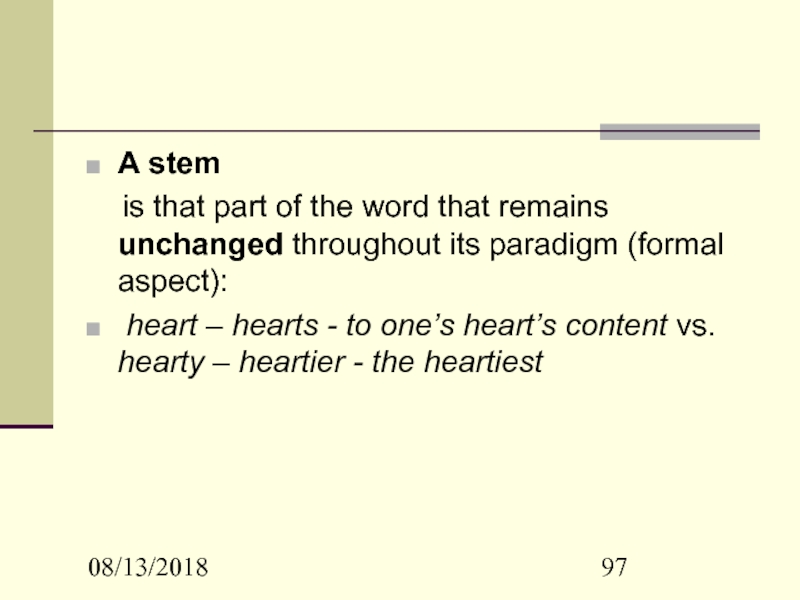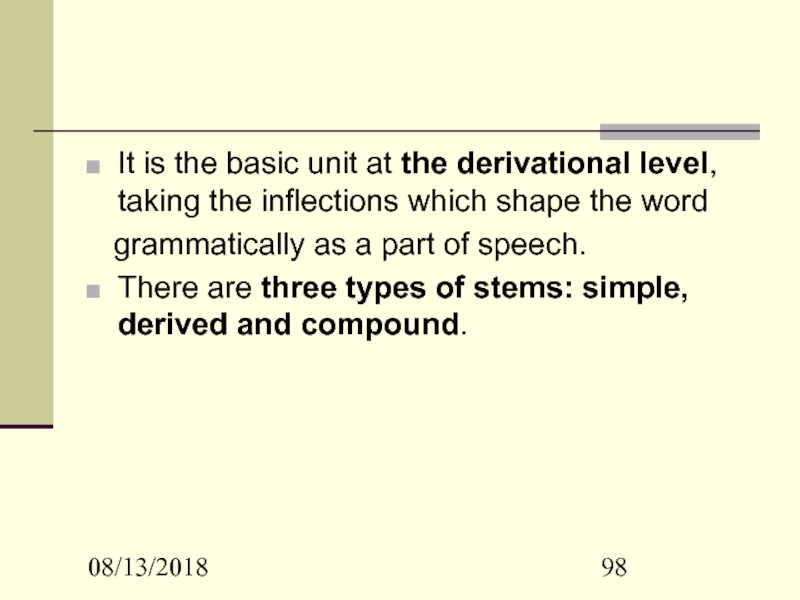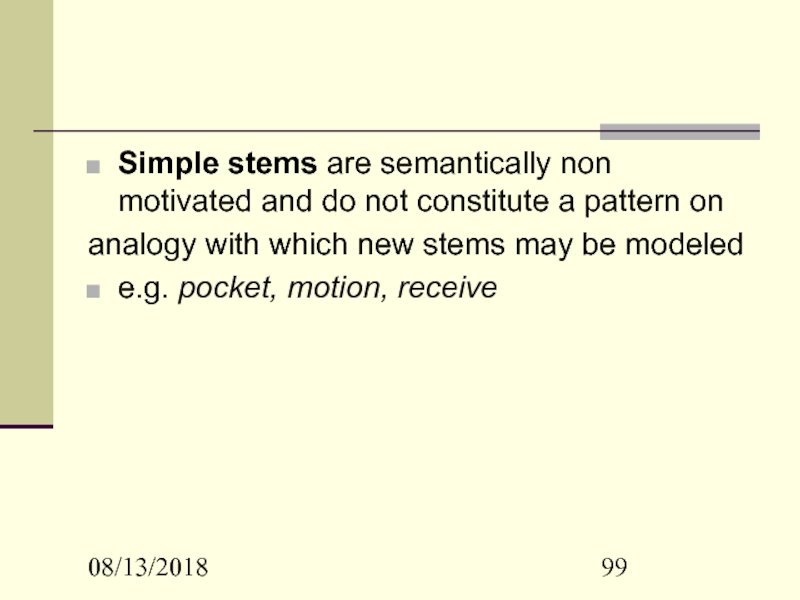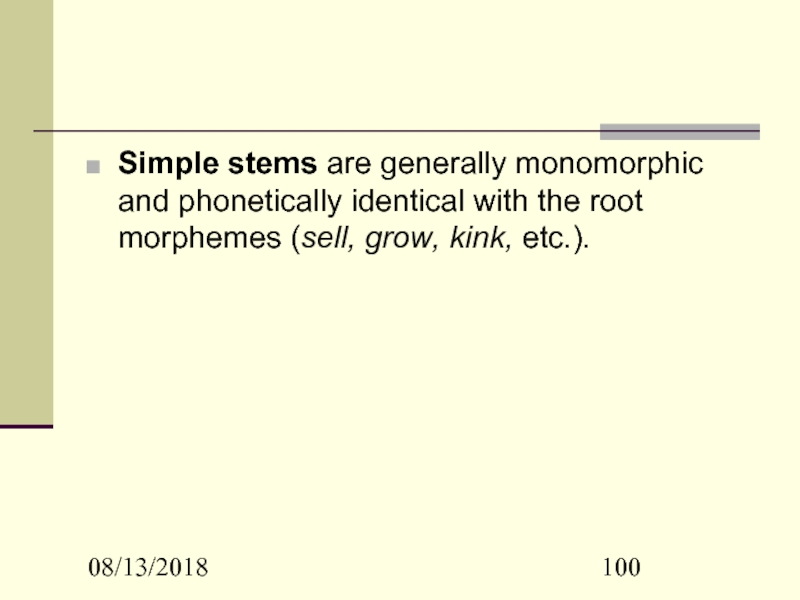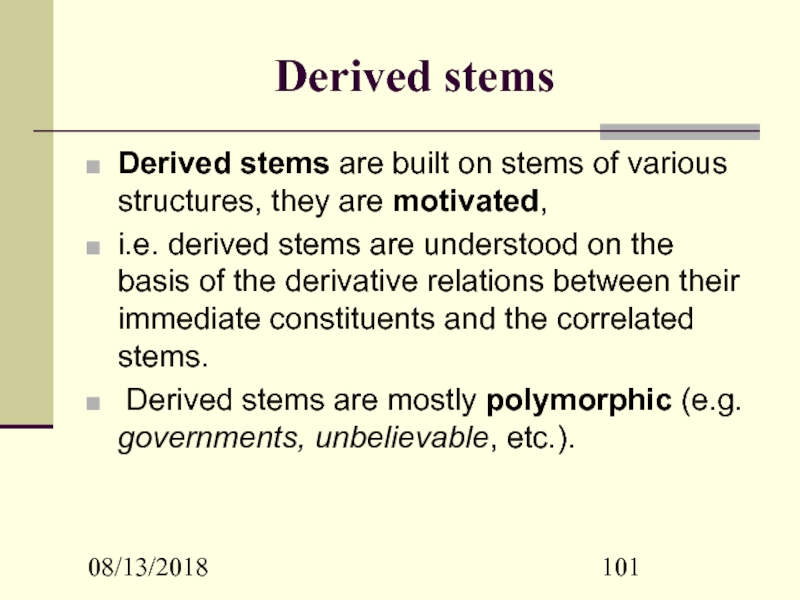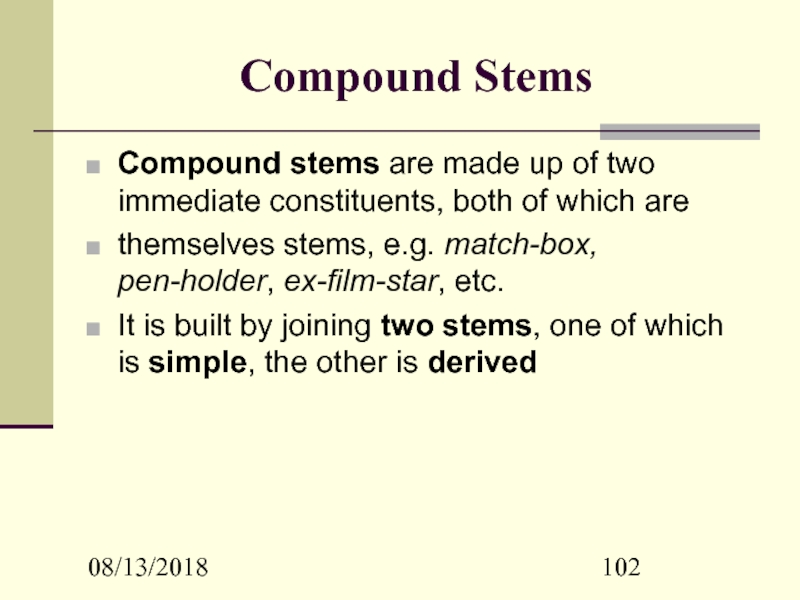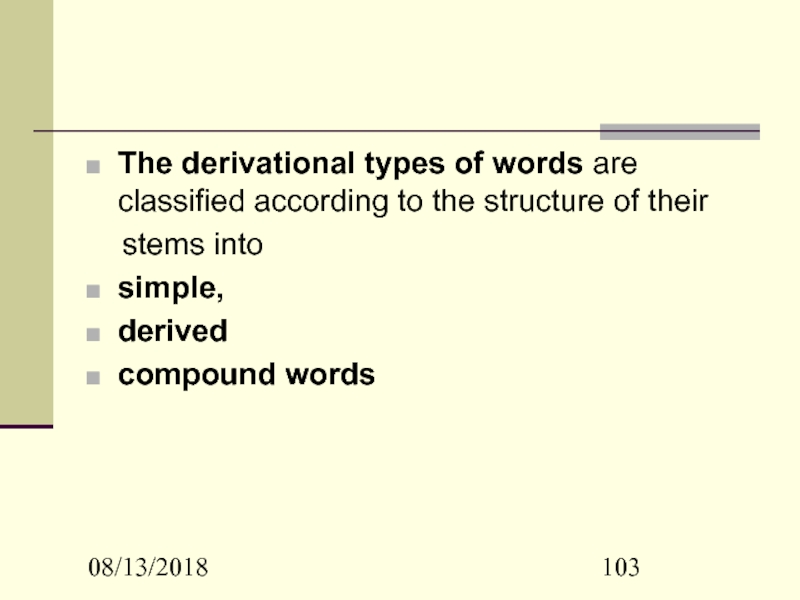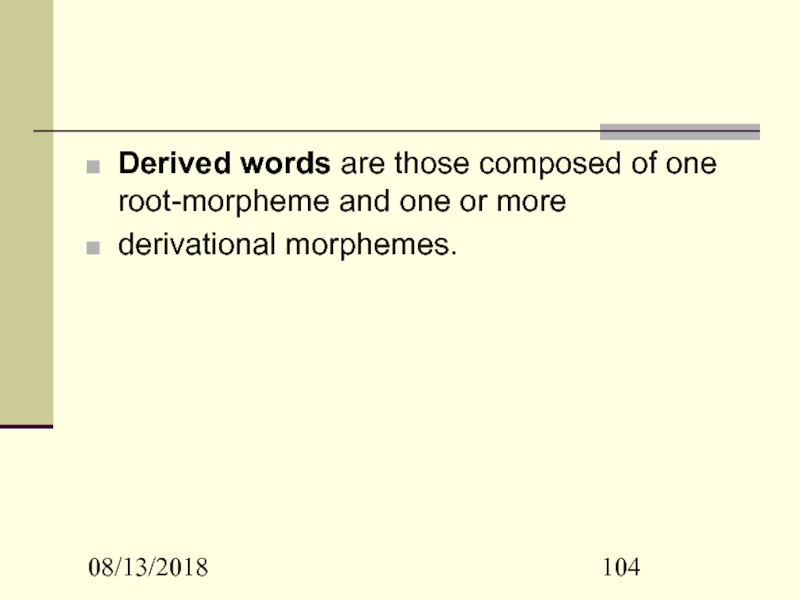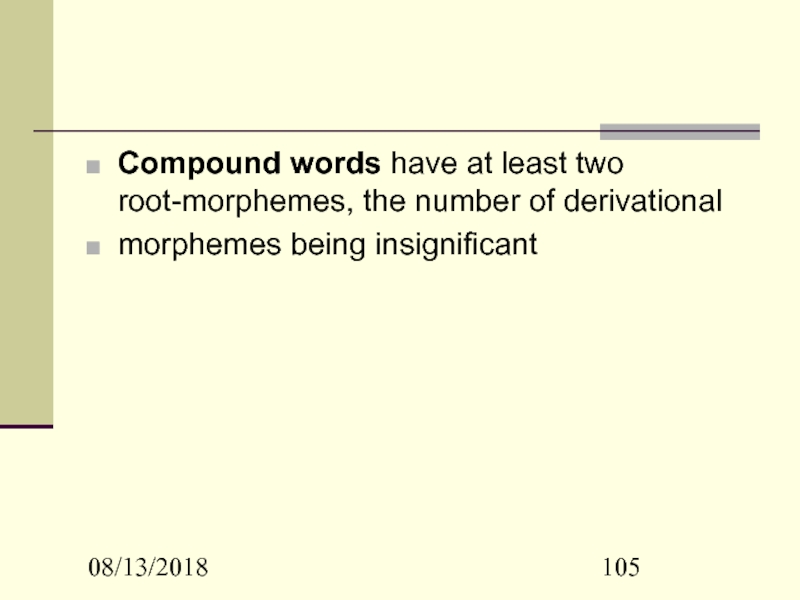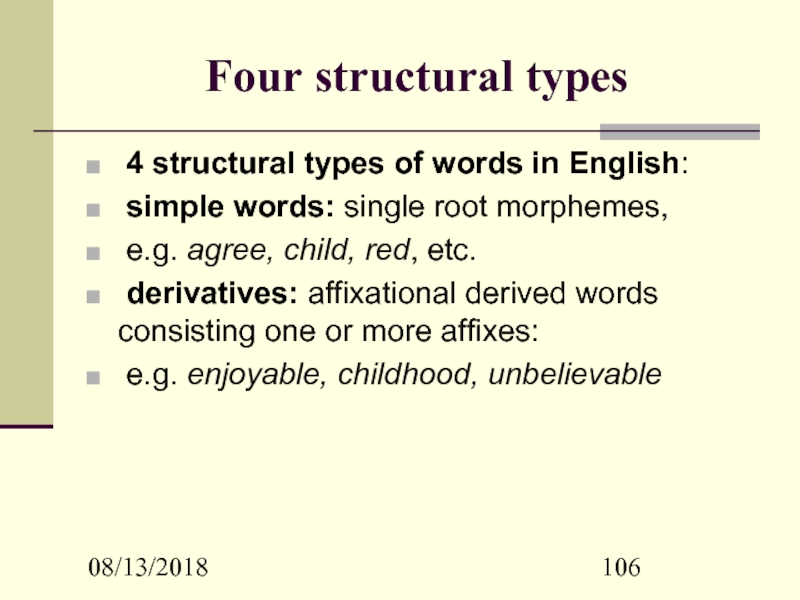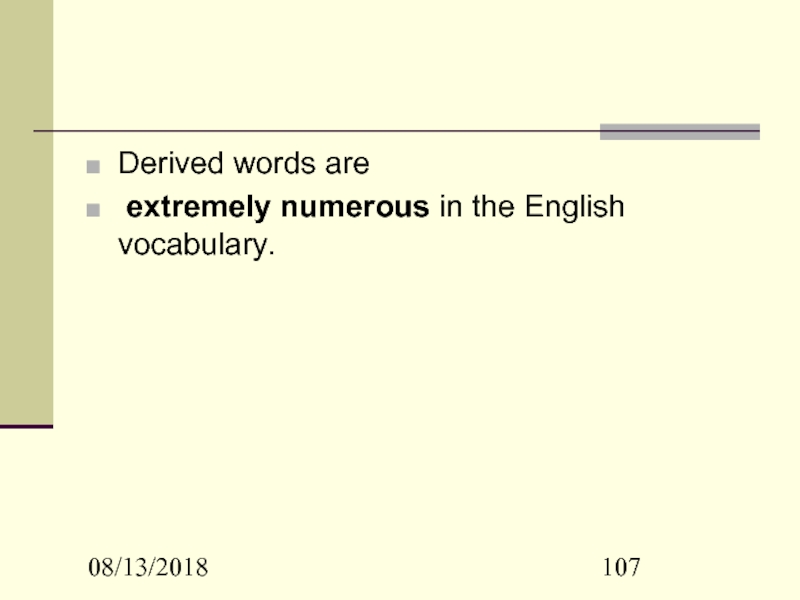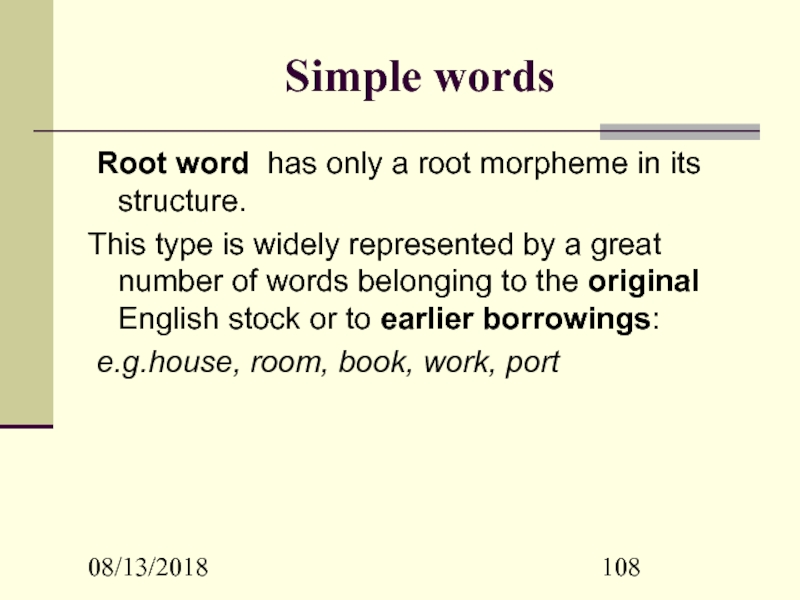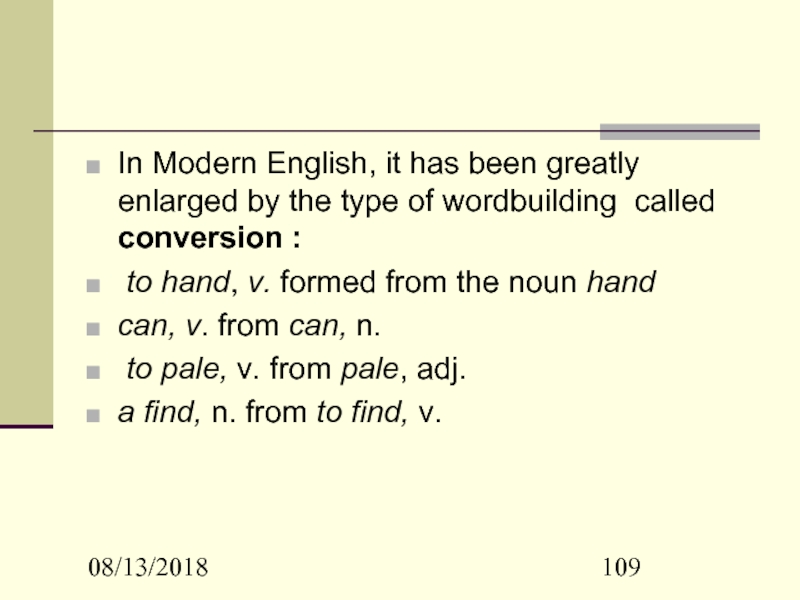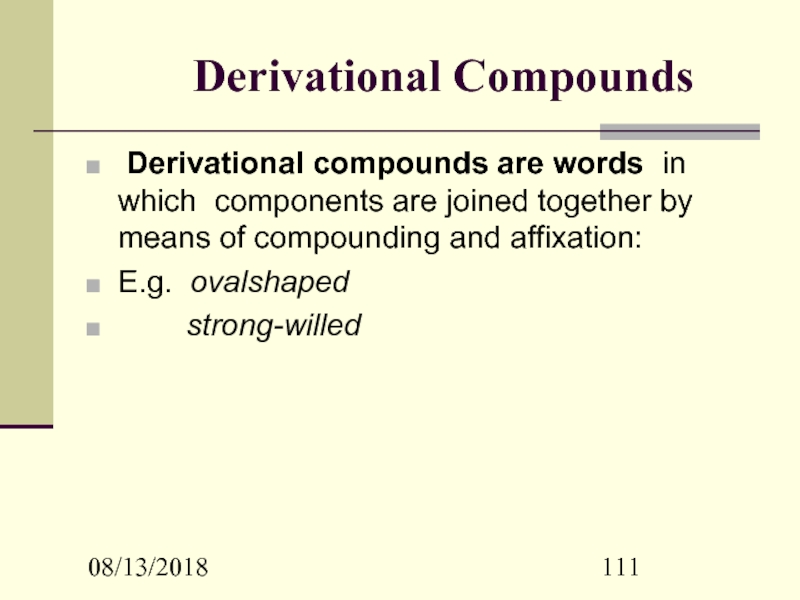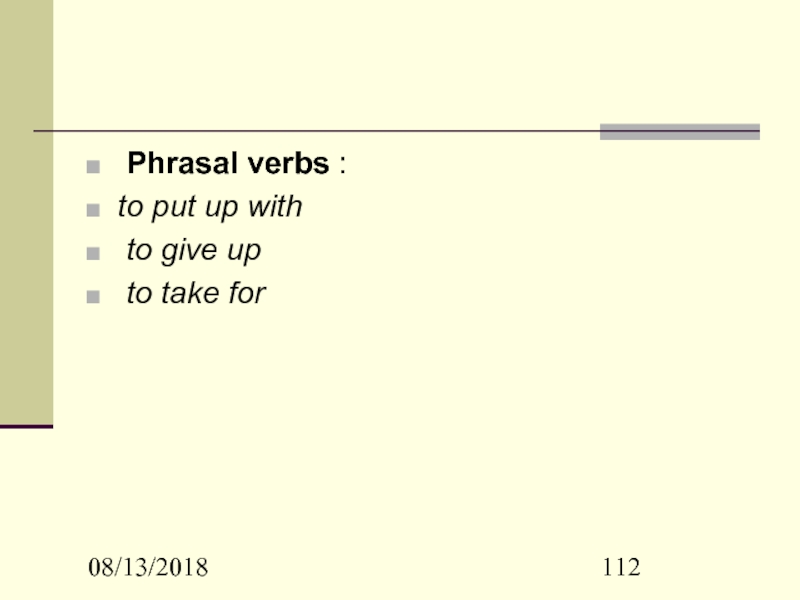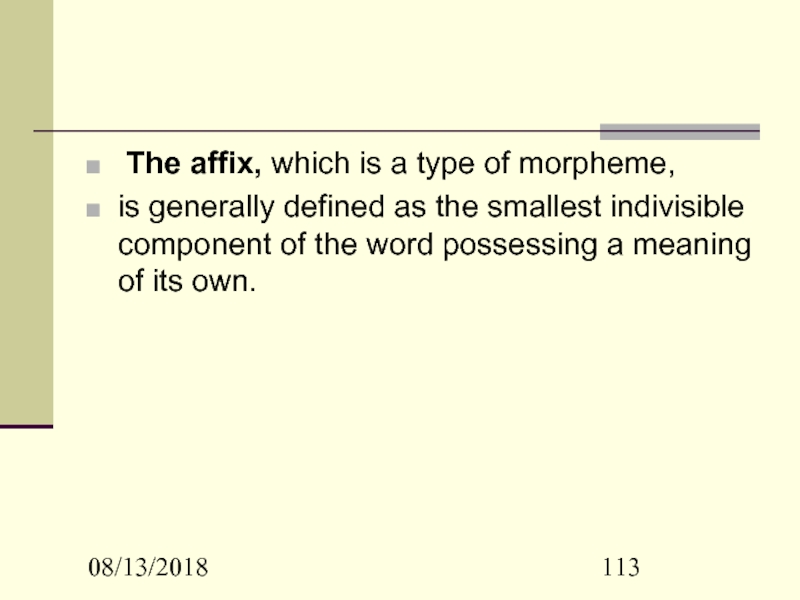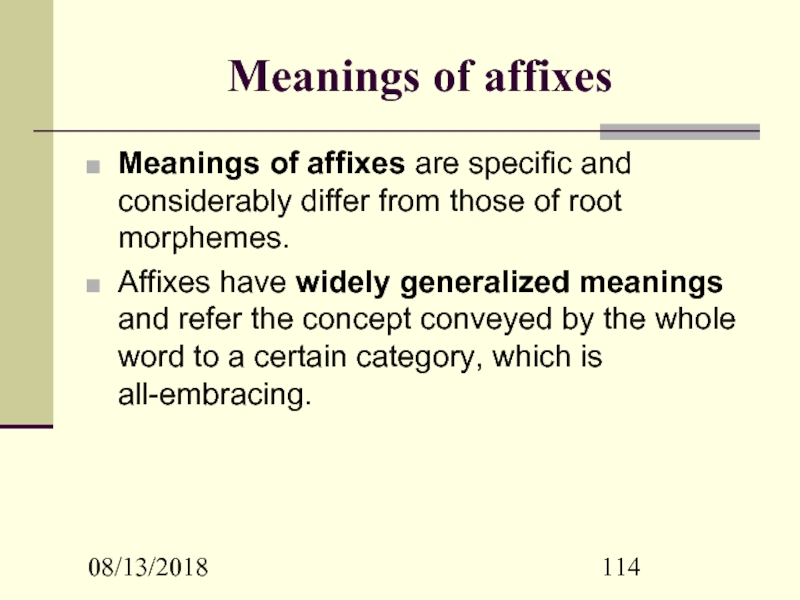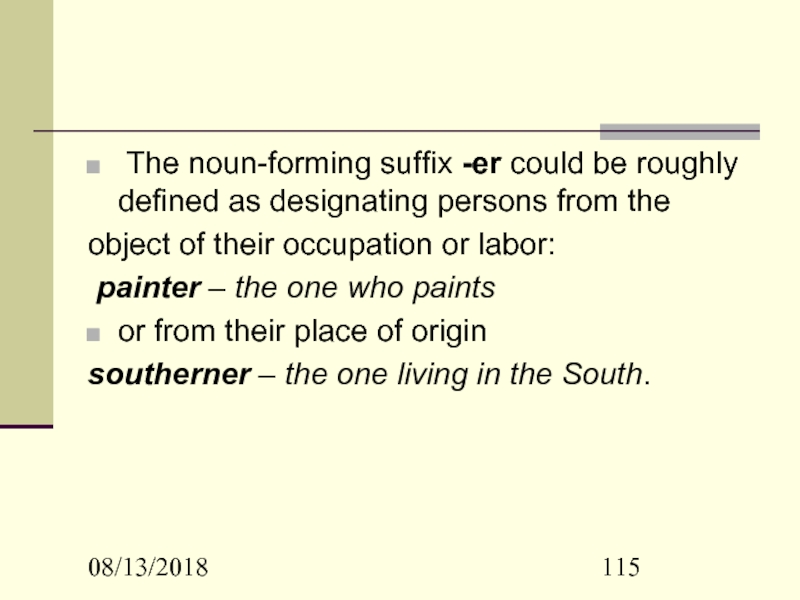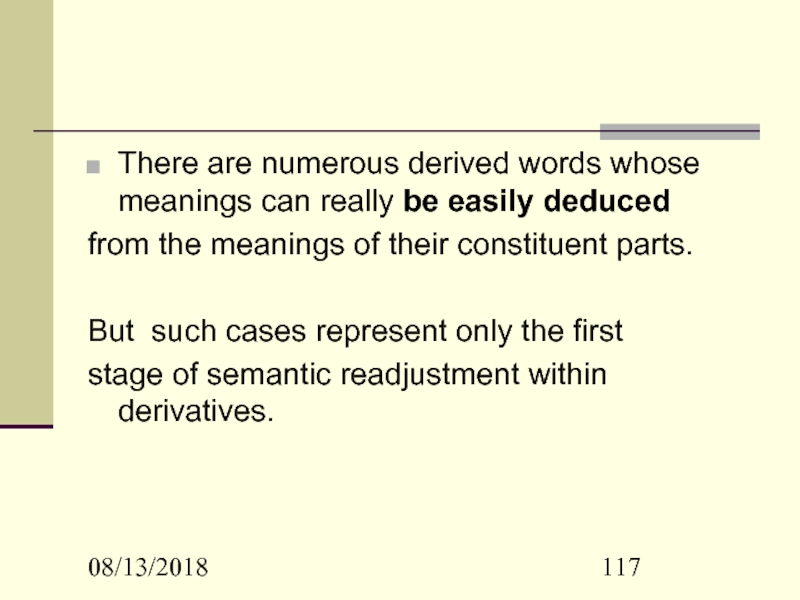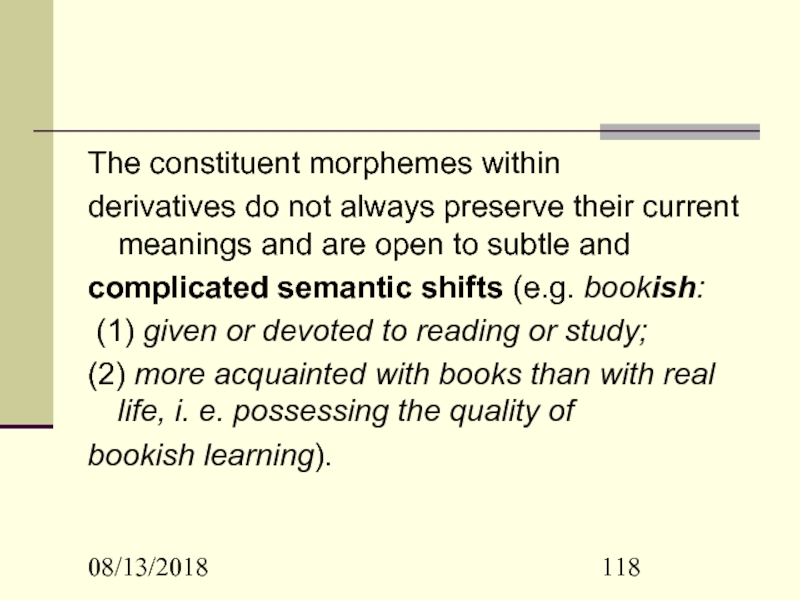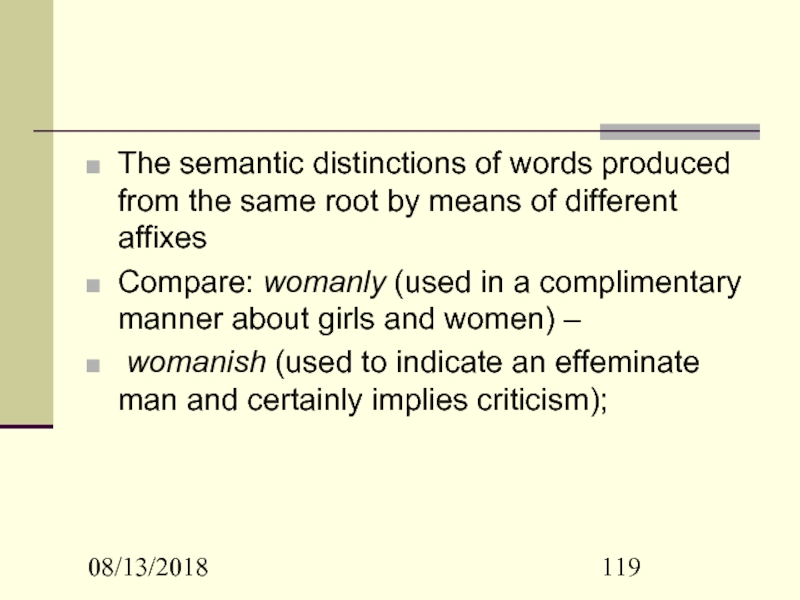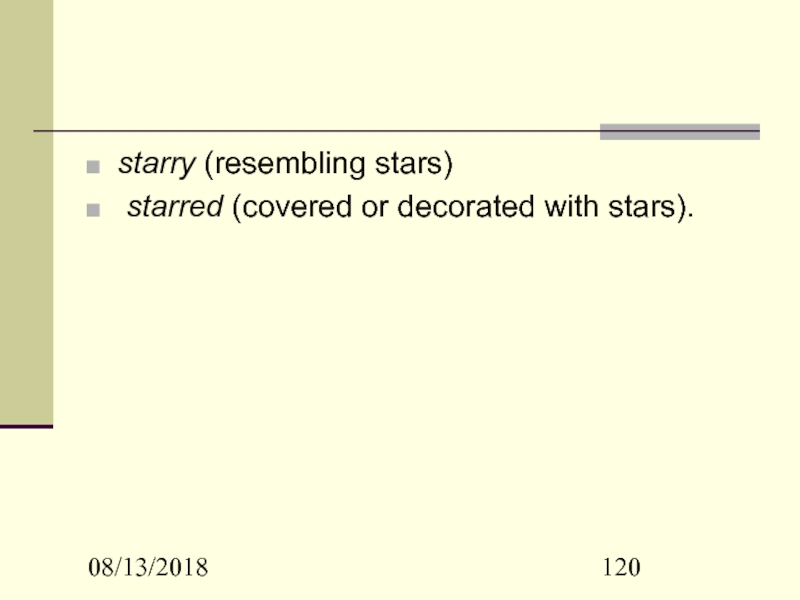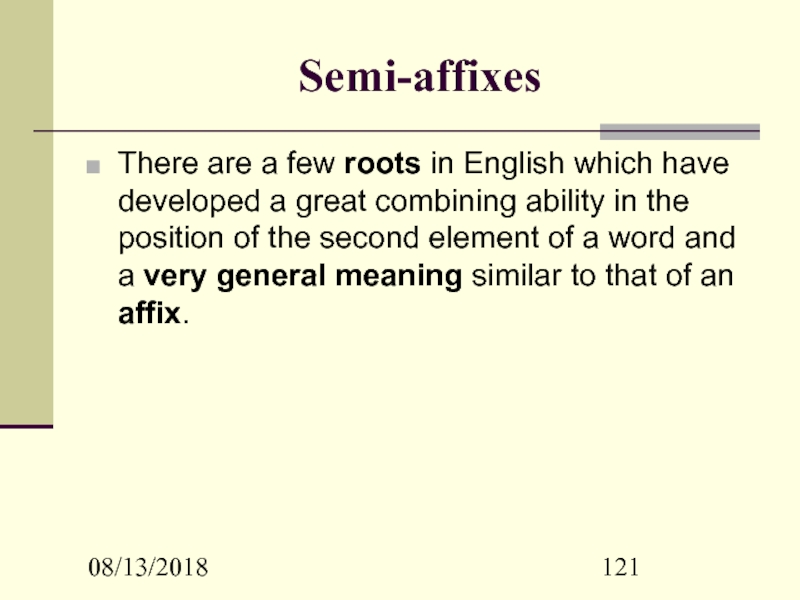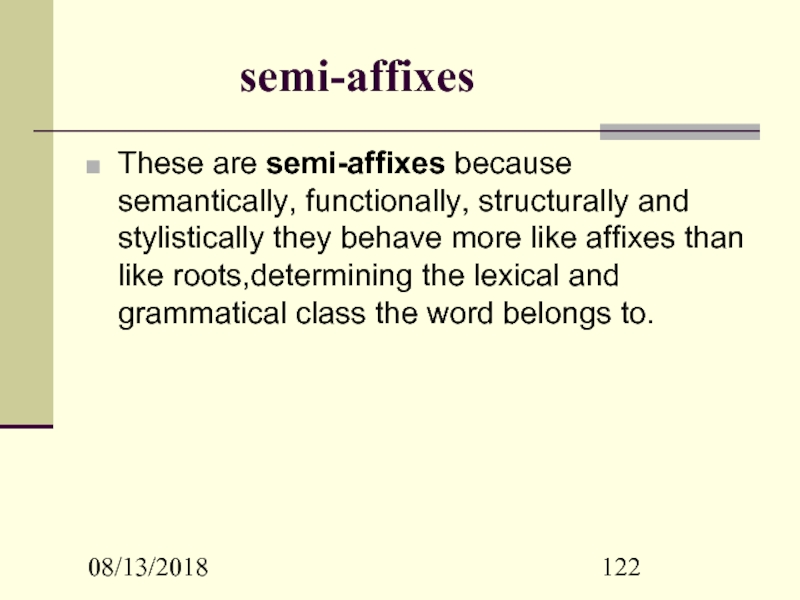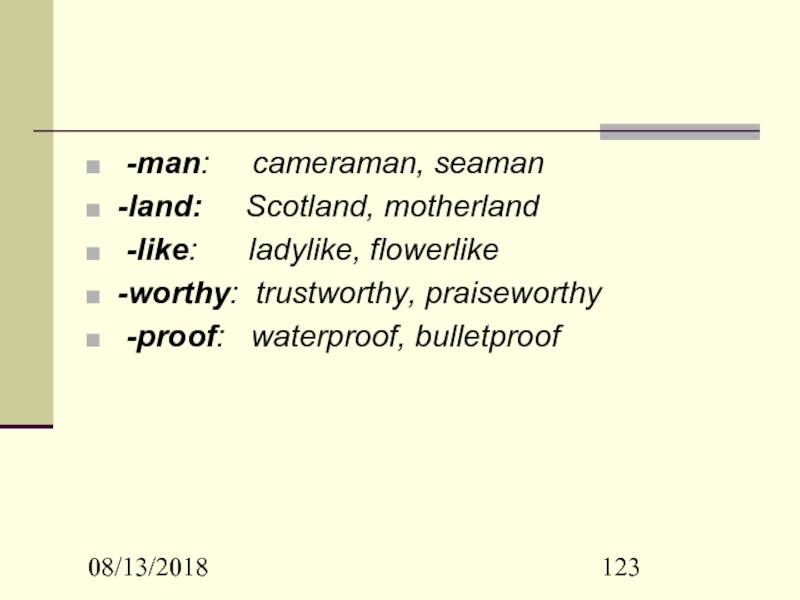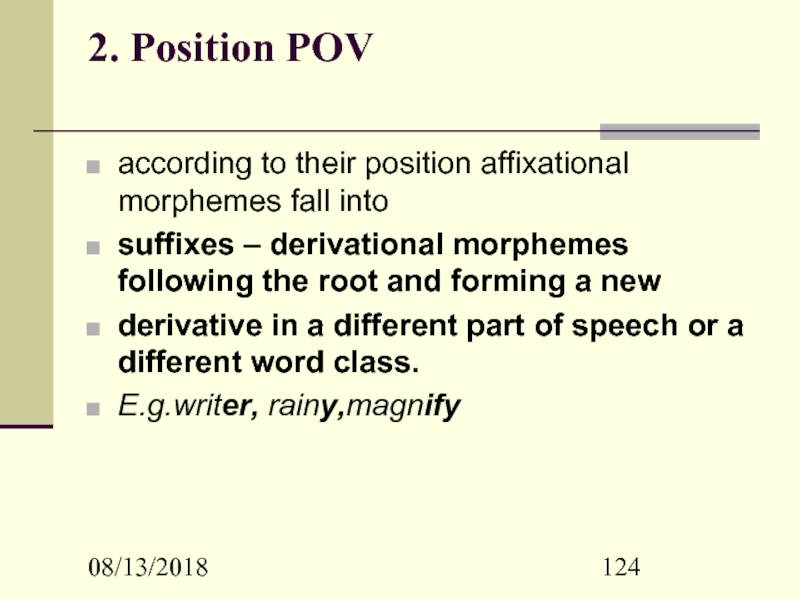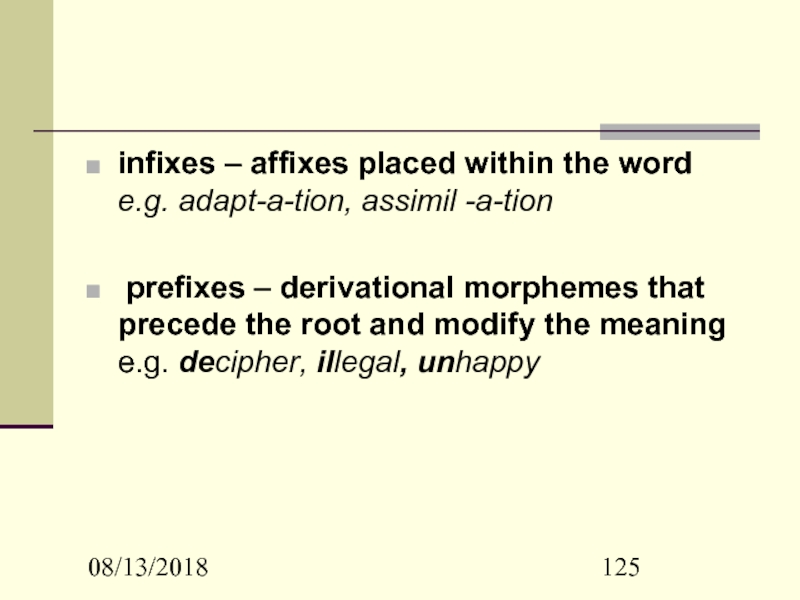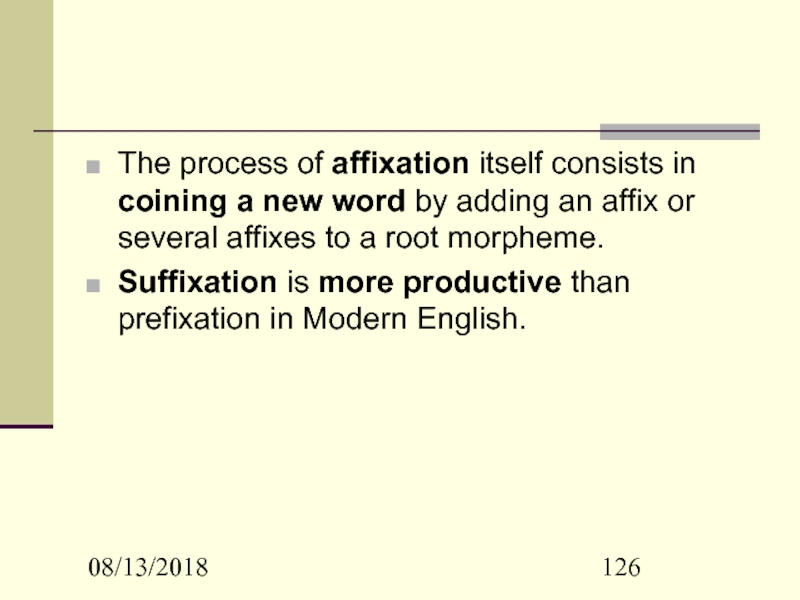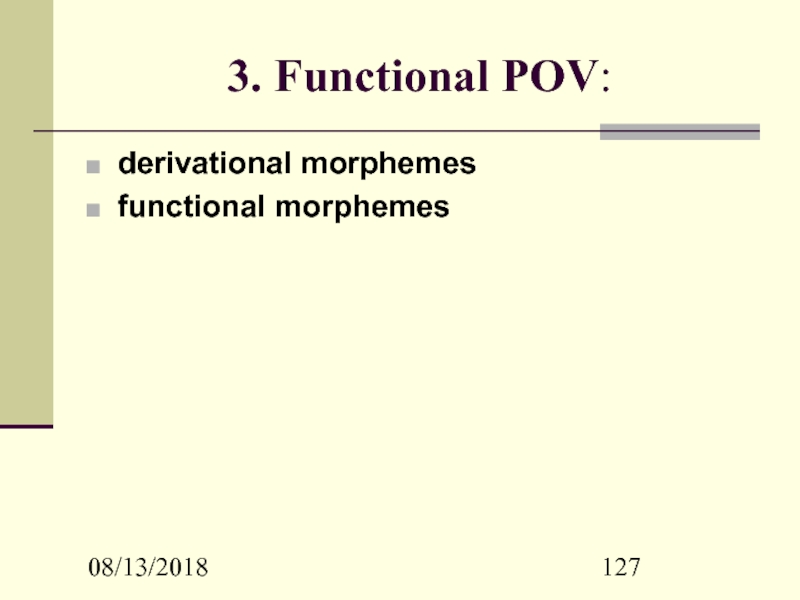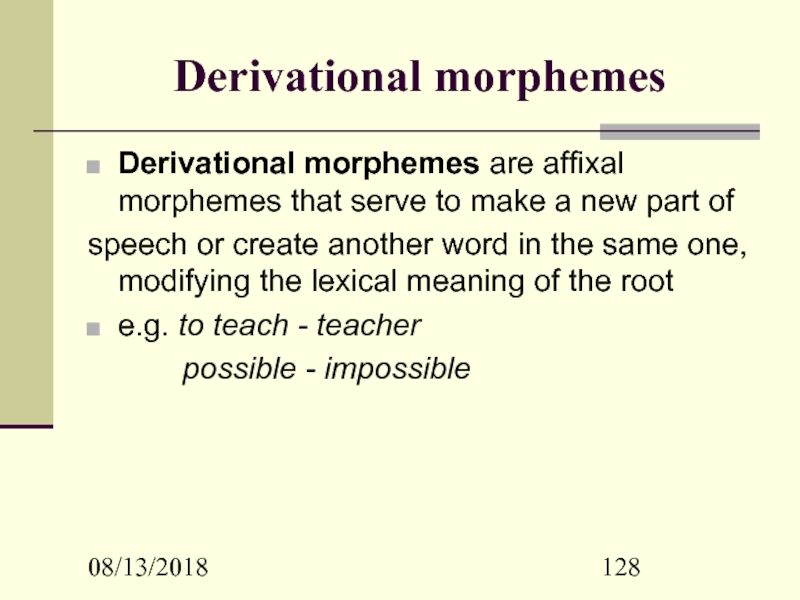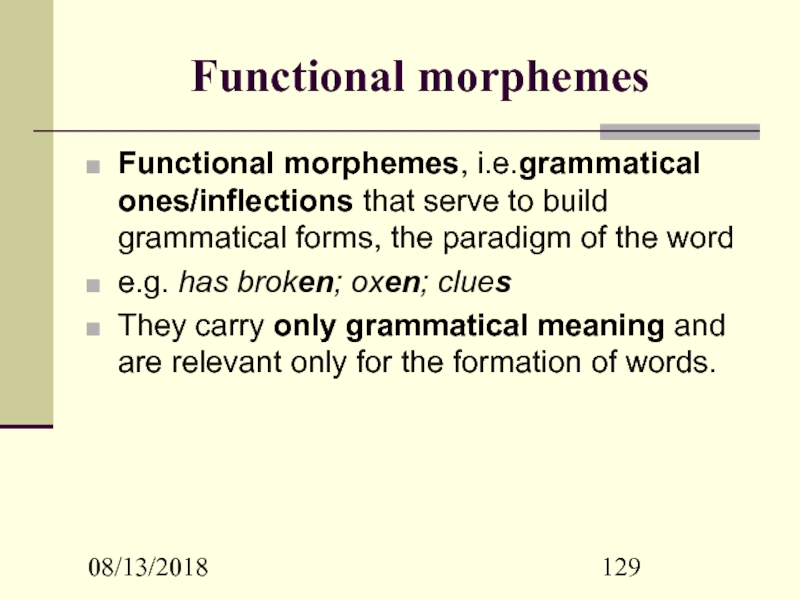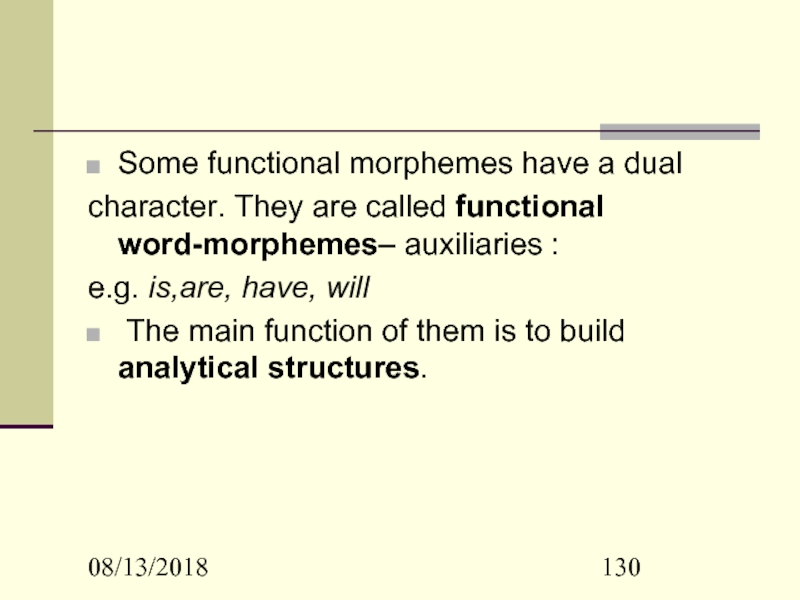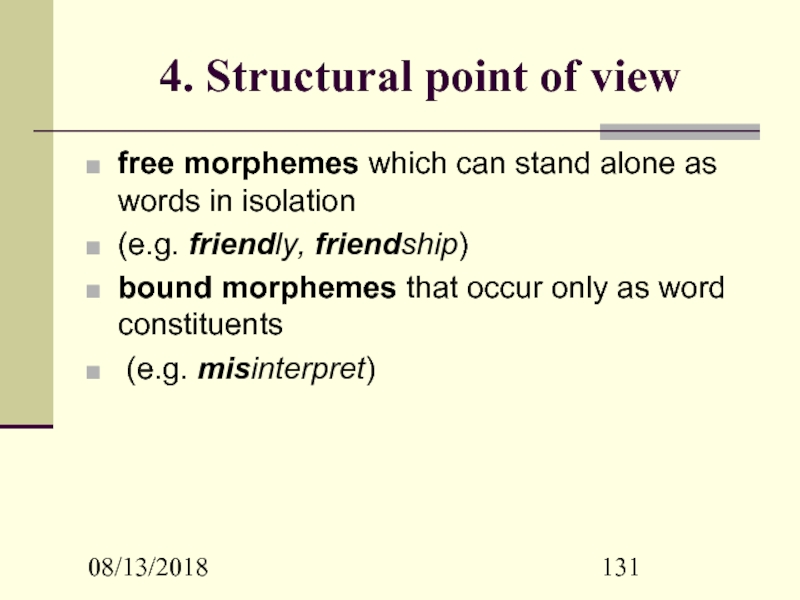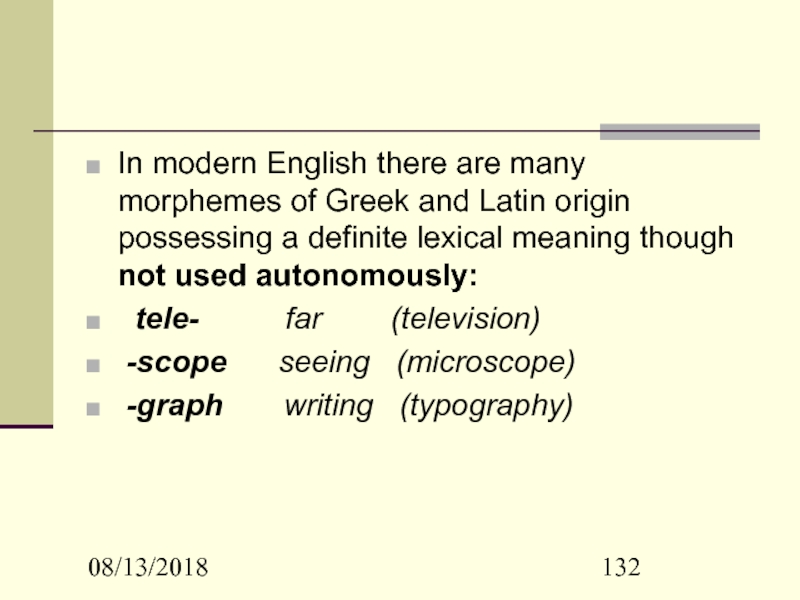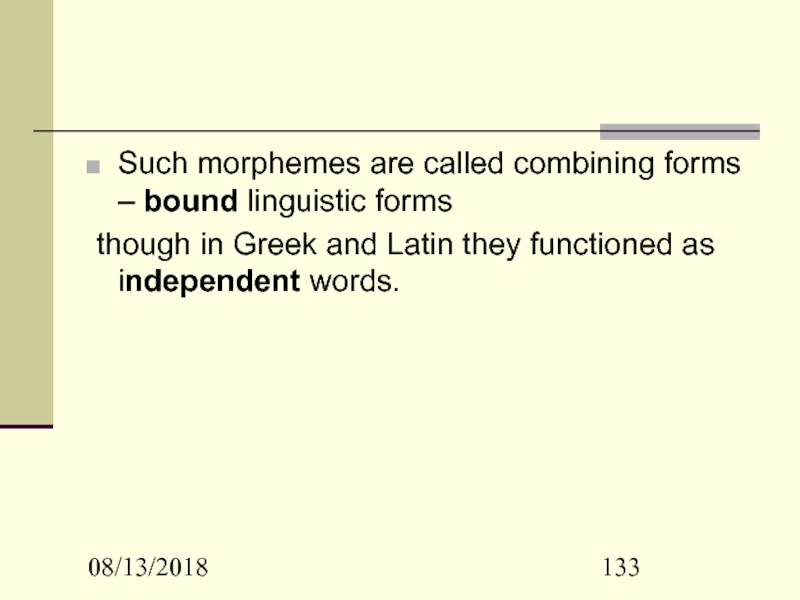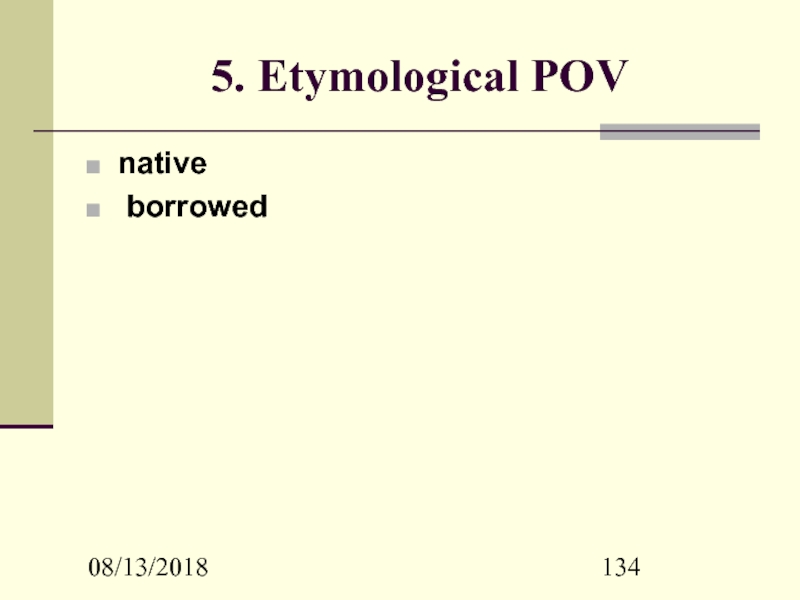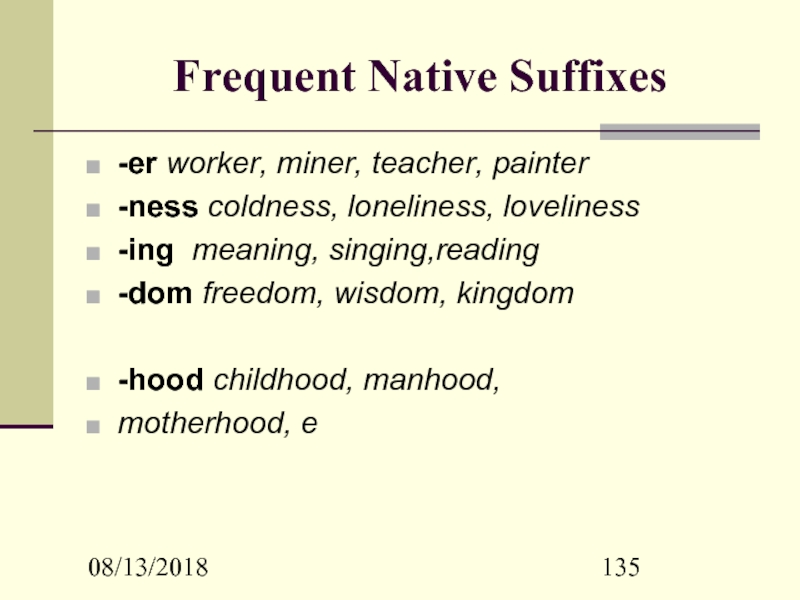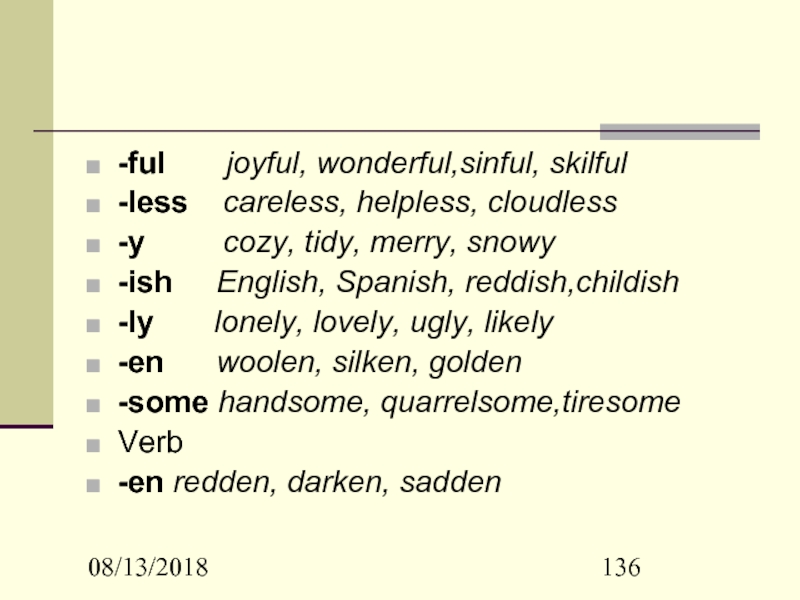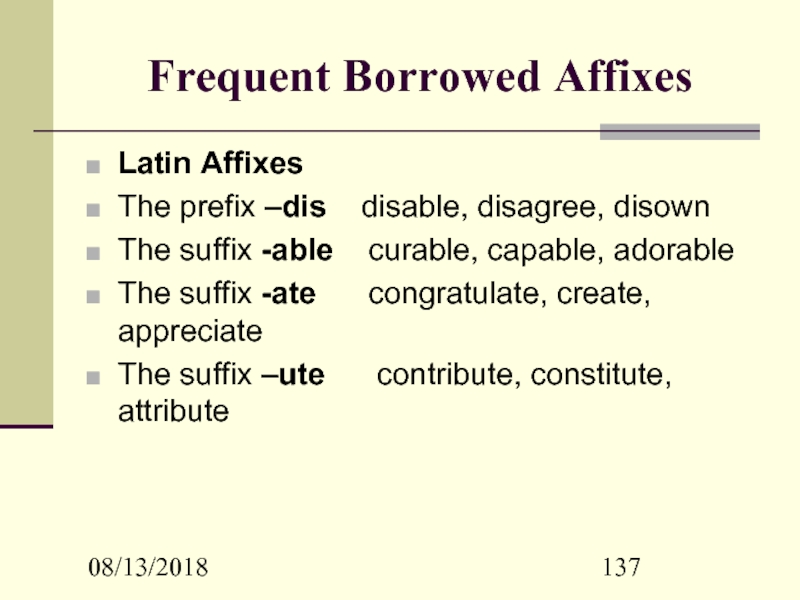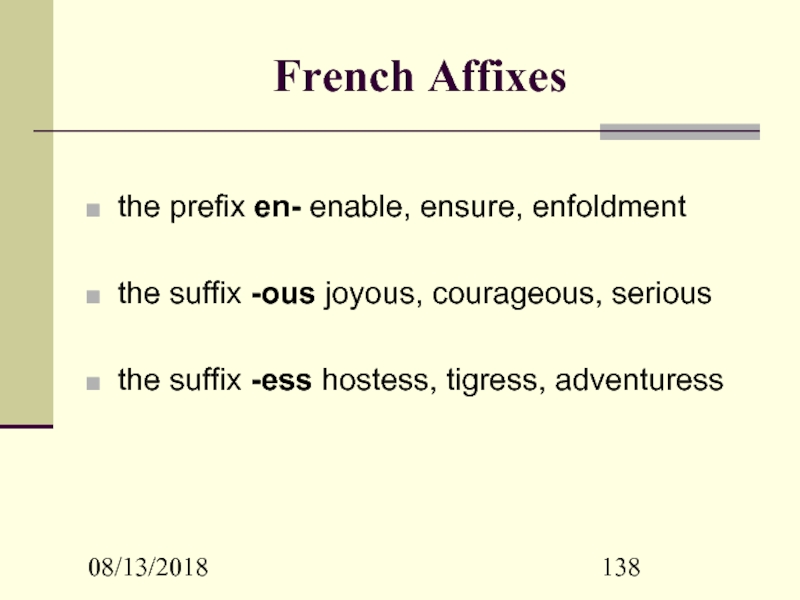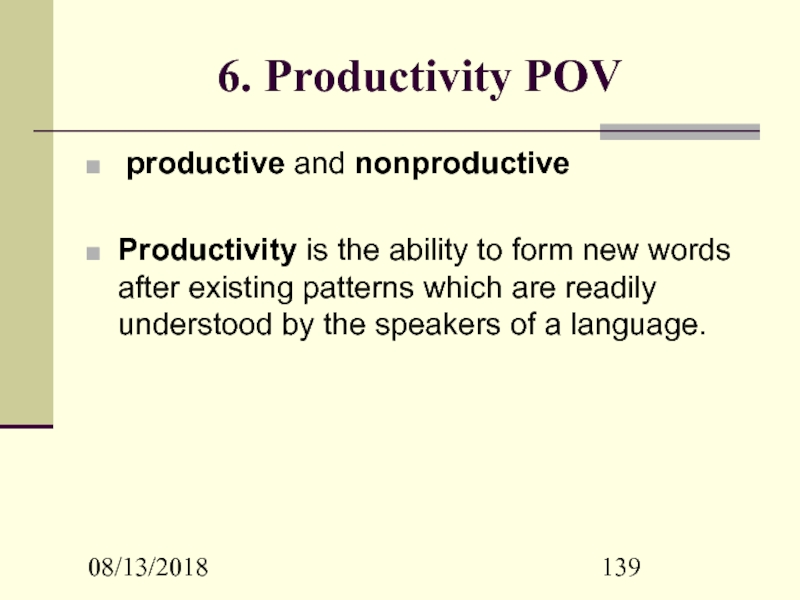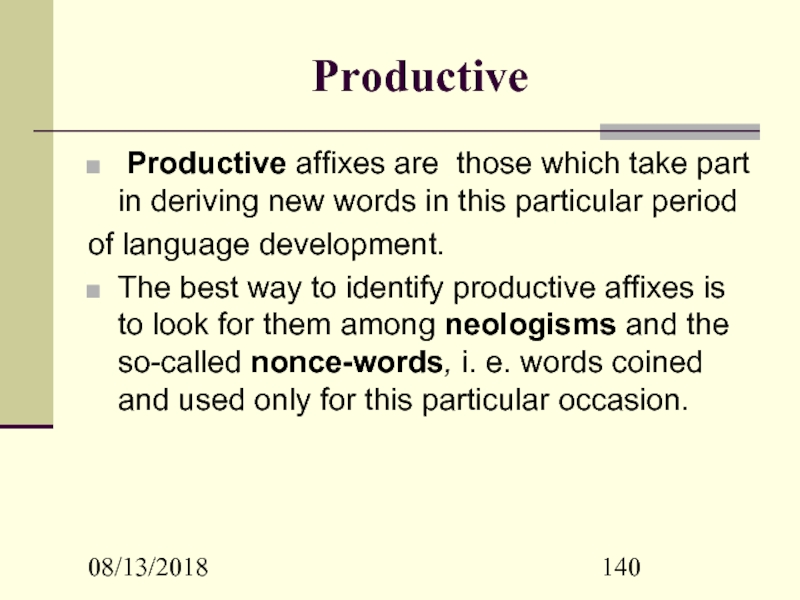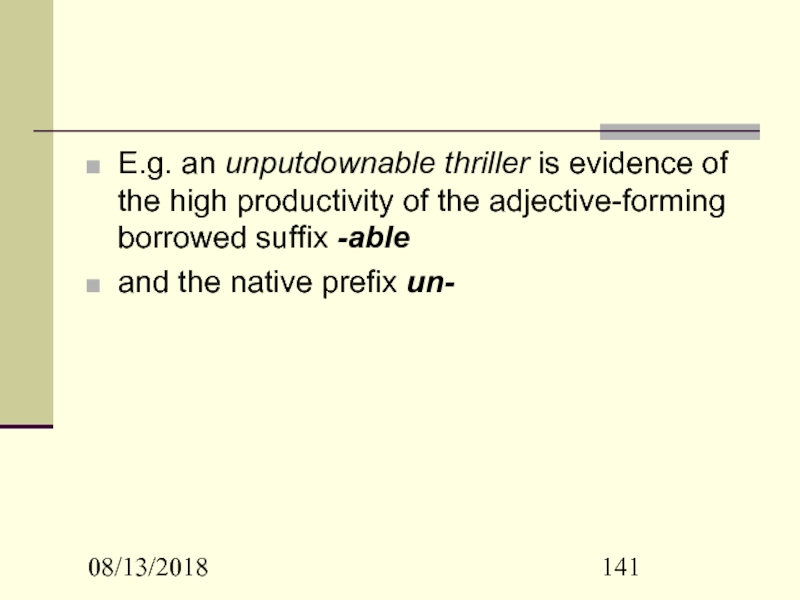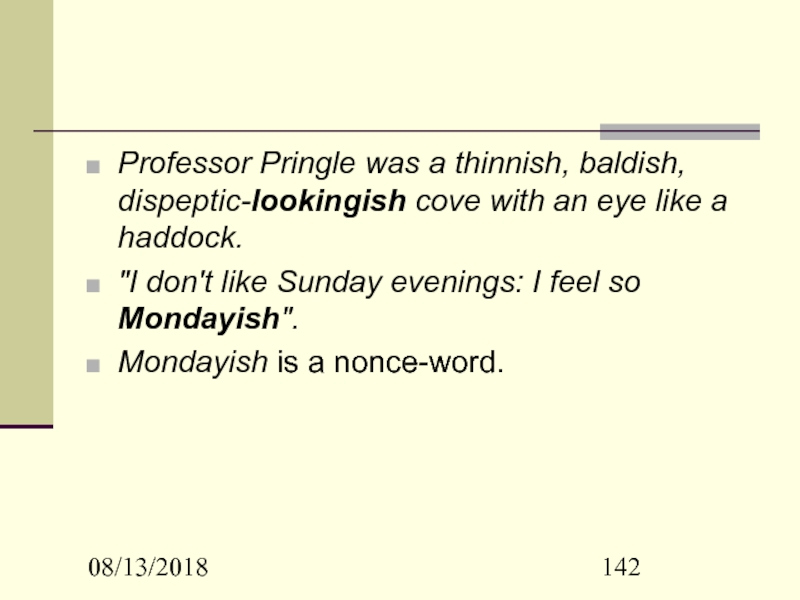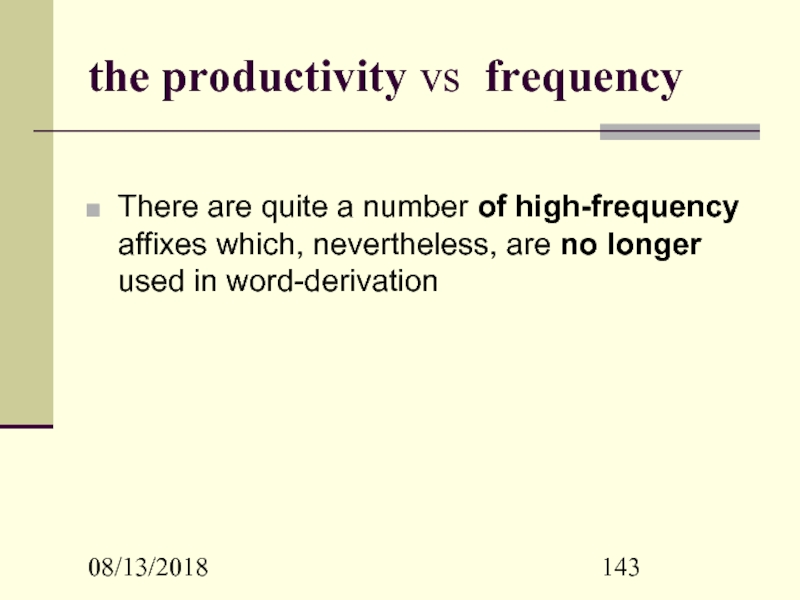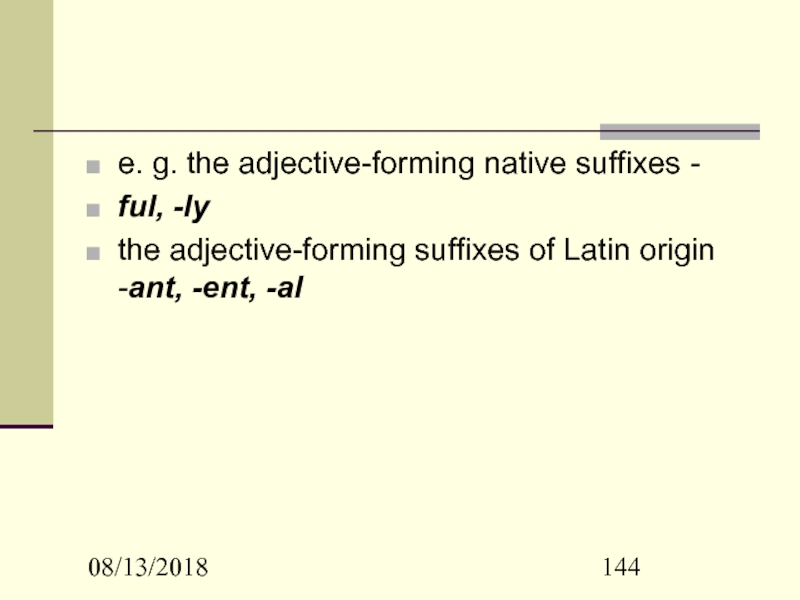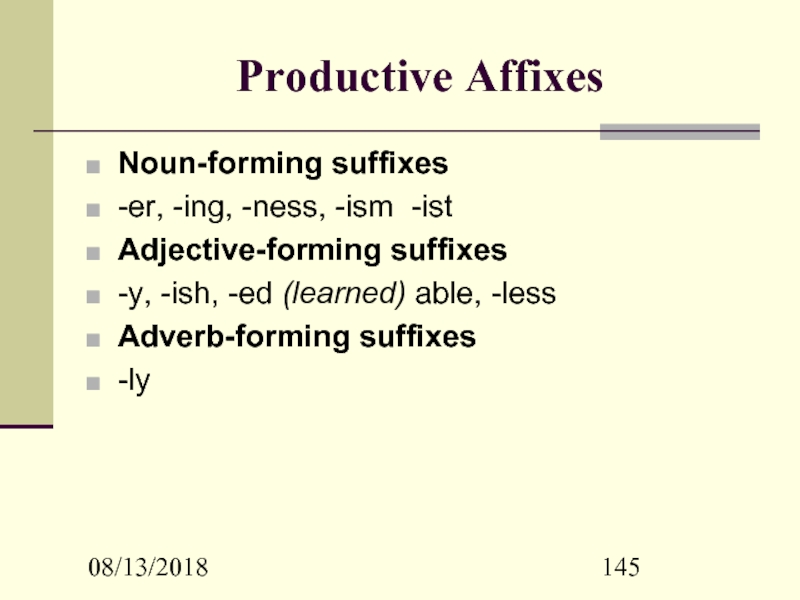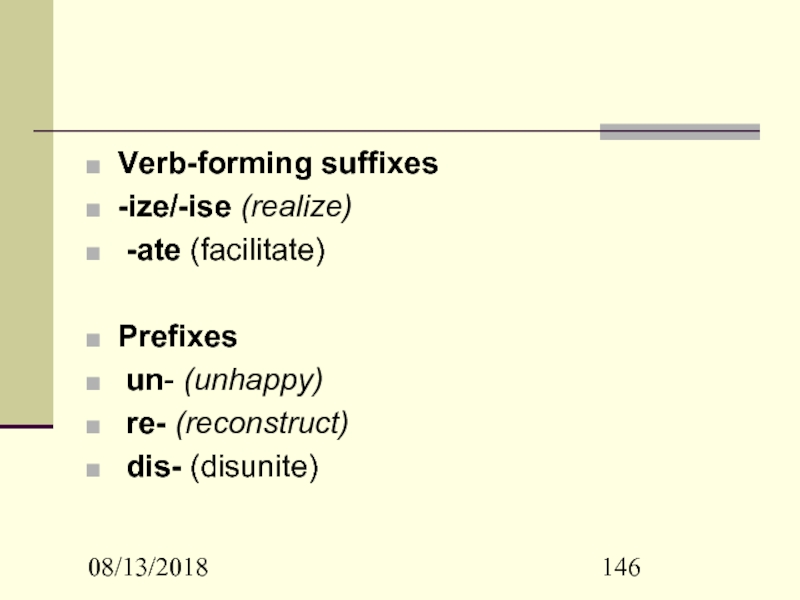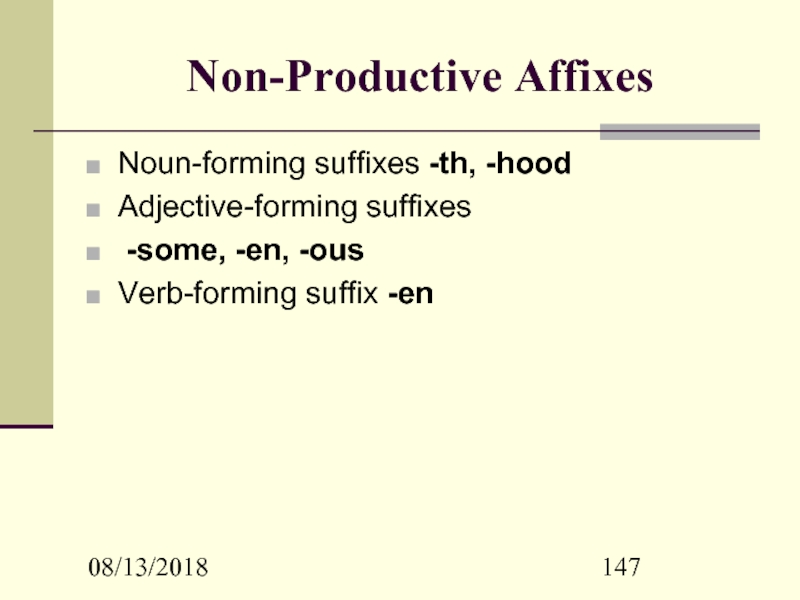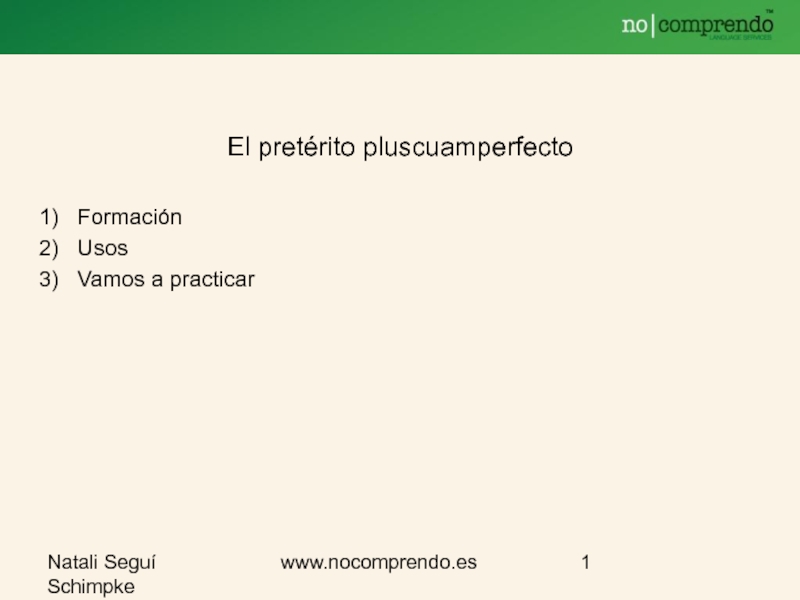- Главная
- Разное
- Дизайн
- Бизнес и предпринимательство
- Аналитика
- Образование
- Развлечения
- Красота и здоровье
- Финансы
- Государство
- Путешествия
- Спорт
- Недвижимость
- Армия
- Графика
- Культурология
- Еда и кулинария
- Лингвистика
- Английский язык
- Астрономия
- Алгебра
- Биология
- География
- Детские презентации
- Информатика
- История
- Литература
- Маркетинг
- Математика
- Медицина
- Менеджмент
- Музыка
- МХК
- Немецкий язык
- ОБЖ
- Обществознание
- Окружающий мир
- Педагогика
- Русский язык
- Технология
- Физика
- Философия
- Химия
- Шаблоны, картинки для презентаций
- Экология
- Экономика
- Юриспруденция
Lexicology. Lexicology studies презентация
Содержание
- 1. Lexicology. Lexicology studies
- 2. 08/13/2018 LITERATURE Антрушина
- 3. 08/13/2018 Мостовий М.І. Лексикологія англійської мови.
- 4. 08/13/2018 Ginzburg R.S., Khidekel S.S., Knyazeva
- 5. 08/13/2018 What is lexicology? the study of
- 6. 08/13/2018 Lexicology studies not only the
- 7. 08/13/2018 Lexicology as a branch of linguistics
- 8. 08/13/2018 Lexicology is concerned with words,
- 9. 08/13/2018 Two principal approaches In the framework
- 10. 08/13/2018 The synchronic approach is concerned with
- 11. 08/13/2018 A Course in Modern English
- 12. 08/13/2018 The diachronic approach deals with
- 13. 08/13/2018 An English Historical Lexicology focuses on
- 14. 08/13/2018 Branches of Lexicology The general study
- 15. 08/13/2018 Special lexicology focuses on the
- 16. 08/13/2018 Contrastive lexicology provides a theoretical
- 17. 08/13/2018 Lexicology studies various lexical units:
- 18. 08/13/2018 Vocabulary studies include such aspects
- 19. 08/13/2018
- 20. 08/13/2018 Semasiology (from Gr. semasia “signification”)
- 21. 08/13/2018 Onomasiology is the study of
- 22. 08/13/2018 A word is a fundamental unit of a language.
- 23. 08/13/2018 Ambiguous The real nature of
- 24. 08/13/2018 The word has acquired definitions
- 25. 08/13/2018 syntactically defined “the minimum
- 26. 08/13/2018 E. Sapir concentrates on the
- 27. 08/13/2018 Semantic A purely semantic treatment is
- 28. 08/13/2018 The prominent French linguist A.
- 29. 08/13/2018 Our native school of linguistics
- 30. 08/13/2018 The nature of the word First,the
- 31. 08/13/2018 Third, the word, viewed structurally, possesses several characteristics.
- 32. 08/13/2018 External + internal A)The modern approach
- 33. 08/13/2018 The external structure is its
- 34. 08/13/2018 The internal structure of the
- 35. 08/13/2018 Unity b) Another structural aspect of
- 36. 08/13/2018 a blackbird vs a black bird
- 37. 08/13/2018 Other words can be inserted
- 38. 08/13/2018 semantic unity The same example may
- 39. 08/13/2018 The word blackbird conveys only
- 40. 08/13/2018 susceptibility c) A further structural feature
- 41. 08/13/2018 To sum up the formal/structural properties
- 42. 08/13/2018 3) a certain freedom of
- 43. 08/13/2018 Thus, a word is the
- 44. 08/13/2018 4 basic kinds of words
- 45. 08/13/2018 3) word-forms which are
- 46. 08/13/2018 A lexeme is a group
- 47. 08/13/2018 Any language is a system
- 48. 08/13/2018 The problem of word-building is
- 49. 08/13/2018 On the syntagmatic level, the
- 50. 08/13/2018 On the paradigmatic level, the
- 51. 08/13/2018 of opposite meaning (e. g.
- 52. 08/13/2018 Inner structure of the
- 53. 08/13/2018 The word consists of morphemes.
- 54. 08/13/2018 The Greek suffix -eme denotes
- 55. 08/13/2018 A morpheme is an association
- 56. 08/13/2018 Morphemes Morphemes occur in speech only
- 57. 08/13/2018 They are not divisible into
- 58. 08/13/2018 Phonemes are the smallest single-facet
- 59. 08/13/2018 So there are 3 lower
- 60. 08/13/2018 Word
- 61. 08/13/2018 A form is considered to
- 62. 08/13/2018 For example, sport, sortive, elegant
- 63. 08/13/2018 A word is, by L.
- 64. 08/13/2018 The method of morphemic analysis Words
- 65. 08/13/2018 Immediate constituents This
- 66. 08/13/2018 The procedure consists of several
- 67. 08/13/2018 The procedure generally used to
- 68. 08/13/2018 It is based on a
- 69. 08/13/2018 Each IC at the
- 70. 08/13/2018 The analysis of the morphemic
- 71. 08/13/2018 Derivative structure The nature, type
- 72. 08/13/2018 Though the derivative structure of
- 73. 08/13/2018 The Derivational Level The derivational level
- 74. 08/13/2018 Word Segmentability segmentable words,
- 75. 08/13/2018 Types of
- 76. 08/13/2018 Complete segmentability Complete
- 77. 08/13/2018 Its constituent morphemes recur with
- 78. 08/13/2018 Conditional segmentability Conditional morphemic segmentability characterizes
- 79. 08/13/2018 E.g. retain, detain, or receive,
- 80. 08/13/2018 Neither the sound-clusters [ri], [di]
- 81. 08/13/2018 Pseudomorphemes The morphemes making up words
- 82. 08/13/2018 Defective morphemic segmentability Defective morphemic segmentability
- 83. 08/13/2018 e.g. cranberry, gooseberry, strawberry
- 84. 08/13/2018 Thus, on the level of
- 85. 08/13/2018 a great number of words
- 86. 08/13/2018 Identification of
- 87. 08/13/2018 Morphs should have the same
- 88. 08/13/2018 Allomorphs Phonetically conditioned positional morpheme variants
- 89. 08/13/2018 e.g. the prefix in- (intransitive)
- 90. 08/13/2018 Complementary distribution Complementary distribution takes place
- 91. 08/13/2018 i.e. if they occur in
- 92. 08/13/2018 Classification of Morphemes The final stage
- 93. 08/13/2018 1. Semantic POV: roots and affixes
- 94. 08/13/2018 e.g. learn – learner
- 95. 08/13/2018 The peculiarity of English
- 96. 08/13/2018 The difference between a root and
- 97. 08/13/2018 A stem
- 98. 08/13/2018 It is the basic unit
- 99. 08/13/2018 Simple stems are semantically non
- 100. 08/13/2018 Simple stems are generally monomorphic
- 101. 08/13/2018
- 102. 08/13/2018
- 103. 08/13/2018 The derivational types of words
- 104. 08/13/2018 Derived words are those composed
- 105. 08/13/2018 Compound words have at least
- 106. 08/13/2018 Four
- 107. 08/13/2018 Derived words are extremely numerous in the English vocabulary.
- 108. 08/13/2018 Simple words Root word has
- 109. 08/13/2018 In Modern English, it has
- 110. 08/13/2018 Compound
- 111. 08/13/2018 Derivational
- 112. 08/13/2018 Phrasal verbs : to
- 113. 08/13/2018 The affix, which is
- 114. 08/13/2018 Meanings of affixes Meanings of affixes
- 115. 08/13/2018 The noun-forming suffix -er
- 116. 08/13/2018 The adjective-forming suffix –ful has
- 117. 08/13/2018 There are numerous derived words
- 118. 08/13/2018 The constituent morphemes within derivatives
- 119. 08/13/2018 The semantic distinctions of words
- 120. 08/13/2018 starry (resembling stars) starred (covered or decorated with stars).
- 121. 08/13/2018 Semi-affixes There are a few roots
- 122. 08/13/2018
- 123. 08/13/2018 -man: cameraman,
- 124. 08/13/2018 2. Position POV according to
- 125. 08/13/2018 infixes – affixes placed within
- 126. 08/13/2018 The process of affixation itself
- 127. 08/13/2018 3. Functional POV: derivational morphemes functional morphemes
- 128. 08/13/2018 Derivational morphemes Derivational morphemes are affixal
- 129. 08/13/2018 Functional morphemes Functional morphemes, i.e.grammatical ones/inflections
- 130. 08/13/2018 Some functional morphemes have a
- 131. 08/13/2018 4. Structural point of view free
- 132. 08/13/2018 In modern English there are
- 133. 08/13/2018 Such morphemes are called combining
- 134. 08/13/2018 5. Etymological POV native borrowed
- 135. 08/13/2018 Frequent Native Suffixes -er worker, miner,
- 136. 08/13/2018 -ful joyful,
- 137. 08/13/2018 Frequent Borrowed Affixes Latin Affixes The
- 138. 08/13/2018 French Affixes the prefix en-
- 139. 08/13/2018 6. Productivity POV productive and
- 140. 08/13/2018 Productive Productive affixes are those
- 141. 08/13/2018 E.g. an unputdownable thriller is
- 142. 08/13/2018 Professor Pringle was a thinnish,
- 143. 08/13/2018 the productivity vs frequency
- 144. 08/13/2018 e. g. the adjective-forming native
- 145. 08/13/2018 Productive Affixes Noun-forming suffixes -er, -ing,
- 146. 08/13/2018 Verb-forming suffixes -ize/-ise (realize)
- 147. 08/13/2018 Non-Productive Affixes Noun-forming suffixes -th, -hood
Слайд 208/13/2018
LITERATURE
Антрушина Г.Б., Афанасьєва О.В., Морозова Н.Н. Лексикология английского языка.
– М.: ДРОФА, 2005. – 286 с.
Арнольд И.В. Лексикология современного английского языка. – М.: Высшая школа, 1986. – 295 с.
Верба Л.Г. Порівняльна лексикологія англійської та української мов. – Вінниця: Нова книга, 2003. – 160 с.
Арнольд И.В. Лексикология современного английского языка. – М.: Высшая школа, 1986. – 295 с.
Верба Л.Г. Порівняльна лексикологія англійської та української мов. – Вінниця: Нова книга, 2003. – 160 с.
Слайд 308/13/2018
Мостовий М.І. Лексикологія англійської мови. – Харків: Основа, 1993. – 256
с.
Харитончик З.А. Лексикология английского языка. – Минск: Вышэйшая школа, 1992. – 229 c.
Crystal D. The Cambridge Encyclopedia of The English Language. – Cambridge: Cambridge University Press, 2005. – 499 p.
Харитончик З.А. Лексикология английского языка. – Минск: Вышэйшая школа, 1992. – 229 c.
Crystal D. The Cambridge Encyclopedia of The English Language. – Cambridge: Cambridge University Press, 2005. – 499 p.
Слайд 408/13/2018
Ginzburg R.S., Khidekel S.S., Knyazeva G.Y., Sankin A.A. A Course in
Modern English Lexicology. – М.: Higher School Publishing House, 1979. – 269 p.
Rayevskaya N.М. English Lexicology. – Київ: Вища школа, 1971. – 332 p.
Rayevskaya N.М. English Lexicology. – Київ: Вища школа, 1971. – 332 p.
Слайд 508/13/2018
What is lexicology?
the study of lexis i.e. its vocabulary or lexicon
Greek
lexis is ‘word’
logos denotes ‘learning, a department of knowledge’
Vocabulary = lexis = lexicon is the total word stock of the language
Lexiсolоgу is ‘the science of the words’
logos denotes ‘learning, a department of knowledge’
Vocabulary = lexis = lexicon is the total word stock of the language
Lexiсolоgу is ‘the science of the words’
Слайд 608/13/2018
Lexicology studies
not only the simple words in all their aspects
but it
deals with complex and compound words,
the meaningful units of the language
etymology, the study of the origin of words
the meaningful units of the language
etymology, the study of the origin of words
Слайд 708/13/2018
Lexicology as a branch of linguistics
has its own aims and
methods of scientific research
Its basic task is a study and systematic description of vocabulary in respect to its origin, development and current use .
Its basic task is a study and systematic description of vocabulary in respect to its origin, development and current use .
Слайд 808/13/2018
Lexicology is concerned with
words,
variable word-groups,
phraseological units,
with morphemes which
make up words
Слайд 908/13/2018
Two principal approaches
In the framework of lexicology, both
synchronic (Gr syn
“together”,“with” and chronos “time”)
and diachronic or historical (Gr dia “through”)
suggested by the Swiss philologist Ferdinand de Saussure
and diachronic or historical (Gr dia “through”)
suggested by the Swiss philologist Ferdinand de Saussure
Слайд 1008/13/2018
The synchronic approach
is concerned with the vocabulary of a language as
it exists at a given time, for instance, at the present time.
It is special Desсriptive Lexicology that deals with the vocabulary and vocabulary units of a particular language at a certain time.
It is special Desсriptive Lexicology that deals with the vocabulary and vocabulary units of a particular language at a certain time.
Слайд 1108/13/2018
A Course in Modern English Lexicology is a course in special
Descriptive Lexicology,
as its object of study is the English vocabulary as it exists at the present time.
as its object of study is the English vocabulary as it exists at the present time.
Слайд 1208/13/2018
The diachronic approach
deals with the changes and the development of
vocabulary in the course of time.
It is special Historical Lexicology that deals with the evolution of the vocabulary units of a language as time goes by.
It is special Historical Lexicology that deals with the evolution of the vocabulary units of a language as time goes by.
Слайд 1308/13/2018
An English Historical Lexicology
focuses on the origin of English vocabulary
units,
their change and development,
the linguistic and extralinguistic factors modifying their structure,
meaning and usage within the history of the English language.
their change and development,
the linguistic and extralinguistic factors modifying their structure,
meaning and usage within the history of the English language.
Слайд 1408/13/2018
Branches of Lexicology
The general study of words and vocabulary, irrespective of
the specific features of any particular language, is known as general lexicology.
Linguistic phenomena and properties common to all languages are referred to as language universals.
Linguistic phenomena and properties common to all languages are referred to as language universals.
Слайд 1508/13/2018
Special lexicology focuses on the description of the peculiarities in the
vocabulary of a given language.
Слайд 1608/13/2018
Contrastive lexicology provides a theoretical foundation on which the vocabularies of
different languages can be compared and described.
Its priority is the correlation between the vocabularies of two or more languages.
Its priority is the correlation between the vocabularies of two or more languages.
Слайд 1708/13/2018
Lexicology studies various lexical units:
morphemes
words
variable word-groups
phraseological
units
Слайд 1808/13/2018
Vocabulary studies include such aspects of research as
etymology,
semasiology
onomasiology.
Слайд 1908/13/2018
Etymology
The evolution of a
vocabulary forms the object of historical lexicology or
etymology (from Gr. etymon “true, real”), discussing the origin of various words,
their change and development, examining the linguistic and extra-linguistic forces
that modify their structure, meaning and usage.
etymology (from Gr. etymon “true, real”), discussing the origin of various words,
their change and development, examining the linguistic and extra-linguistic forces
that modify their structure, meaning and usage.
Слайд 2008/13/2018
Semasiology (from Gr. semasia “signification”) is a branch of linguistics with
subject-matter of the study of word meaning and the classification of changes in the signification of words or forms, viewed as normal and vital factors of any linguistic development.
It is the most relevant to polysemy and homonymy.
It is the most relevant to polysemy and homonymy.
Слайд 2108/13/2018
Onomasiology is the study of the principles and regularities of the
signification of things / notions by lexical and lexico-phraseological means of a given language.
It has its special value in studying dialects, with relevance to synonymity.
It has its special value in studying dialects, with relevance to synonymity.
Слайд 2308/13/2018
Ambiguous
The real nature of a word and the term itself has
always been one of the most ambiguous issues in almost every branch of linguistics.
Слайд 2408/13/2018
The word has acquired definitions from the
syntactic,
semantic,
phonological points of
view
as well as a definition combining various approaches.
as well as a definition combining various approaches.
Слайд 2508/13/2018
syntactically defined
“the minimum sentence” by H.Sweet
“the minimum independent unit
of
utterance” by L.Bloomfield
utterance” by L.Bloomfield
Слайд 2608/13/2018
E. Sapir concentrates on the syntactic and semantic aspects calling the
word
“one of the smallest completely satisfying bits of isolated meaning, into which the
sentence resolves itself”.
“one of the smallest completely satisfying bits of isolated meaning, into which the
sentence resolves itself”.
Слайд 2708/13/2018
Semantic
A purely semantic treatment is observed in S. Ullmann’s explanation of
words
as meaningful segments that are ultimately composed of meaningful units.
as meaningful segments that are ultimately composed of meaningful units.
Слайд 2808/13/2018
The prominent French linguist A. Meillet combines the semantic, phonological
and grammatical
criteria:
“A word is defined by the association of a given meaning with a given group of sounds susceptible of a given grammatical employment”.
“A word is defined by the association of a given meaning with a given group of sounds susceptible of a given grammatical employment”.
Слайд 2908/13/2018
Our native school of linguistics understands the word
as a dialectical
double facet unit of form and content, reflecting human notions, and in this sense being considered as a form of their existence.
Слайд 3008/13/2018
The nature of the word
First,the word is a unit of speech
which serves the purposes of human communication.
Thus, the word can be defined as a unit of communication.
Secondly, the word can be perceived as the total of the sounds which comprise it.
Thus, the word can be defined as a unit of communication.
Secondly, the word can be perceived as the total of the sounds which comprise it.
Слайд 3208/13/2018
External + internal
A)The modern approach to the word as double-facet unit
is based on distinguishing between
the external
and the internal structures of the word.
the external
and the internal structures of the word.
Слайд 3308/13/2018
The external structure is its morphological structure.
E.g. in the word
post-impressionists the following morphemes are distinguished:
prefixes post-, im-
the root –press-
the noun-forming suffixes -ion, -ist
and the grammatical suffix of plurality -s.
prefixes post-, im-
the root –press-
the noun-forming suffixes -ion, -ist
and the grammatical suffix of plurality -s.
Слайд 3408/13/2018
The internal structure of the word, or its meaning, is commonly
referred to as the word's semantic structure.
This is the word's main aspect. Words can serve the purposes of human communication solely due to their meanings.
This is the word's main aspect. Words can serve the purposes of human communication solely due to their meanings.
Слайд 3508/13/2018
Unity
b) Another structural aspect of the word is its unity.
The
word possesses both its external (or formal) unity and semantic unity.
The formal unity of the word is sometimes interpreted as indivisibility.
The formal unity of the word is sometimes interpreted as indivisibility.
Слайд 3608/13/2018
a blackbird vs a black bird
The word blackbird, which is characterized
by unity, possesses a single grammatical framing: blackbirds. The first constituent black is not subject to any grammatical changes.
In the word-group a black bird each constituent can acquire grammatical forms of its own: the blackest birds I've ever seen.
In the word-group a black bird each constituent can acquire grammatical forms of its own: the blackest birds I've ever seen.
Слайд 3808/13/2018
semantic unity
The same example may be used to illustrate what we
mean by semantic unity.
In the word-group a black bird each of the meaningful words conveys a separate concept:
bird – a kind of living creature;
black – a color.
In the word-group a black bird each of the meaningful words conveys a separate concept:
bird – a kind of living creature;
black – a color.
Слайд 3908/13/2018
The word blackbird conveys only one concept: the type of bird.
This is one of the main features of any word:
it always conveys one concept, no matter how many component morphemes it may have in its external structure.
it always conveys one concept, no matter how many component morphemes it may have in its external structure.
Слайд 4008/13/2018
susceptibility
c) A further structural feature of the word is its susceptibility
to grammatical employment.
In speech most words can be used in different grammatical forms in which their interrelations are realized.
In speech most words can be used in different grammatical forms in which their interrelations are realized.
Слайд 4108/13/2018
To sum up the formal/structural properties of the word
1) isolatability
words can function in isolation, can make a sentence of their own under certain circumstances;
2) inseparability/unity
words are characterized by some integrity, e.g. a light – alight (with admiration);
2) inseparability/unity
words are characterized by some integrity, e.g. a light – alight (with admiration);
Слайд 4208/13/2018
3) a certain freedom of distribution
exposition in the sentence can
be different
4) susceptibility to grammatical employment
5) a word as one of the fundamental units of the language is a double facet unit of form (its external structure) and meaning (its internal/semantic structure).
4) susceptibility to grammatical employment
5) a word as one of the fundamental units of the language is a double facet unit of form (its external structure) and meaning (its internal/semantic structure).
Слайд 4308/13/2018
Thus, a word is the smallest naming unit of a language
with a more or less free distribution used for the purposes of human communication, materially representing a group of sounds, possessing a meaning, susceptible to grammatical employment and characterized by formal and semantic unity.
Слайд 4408/13/2018
4 basic kinds of words
1) orthographic words –
words distinguished
from each other by their spelling;
2) phonological words –
distinguished from each other by their pronunciation;
2) phonological words –
distinguished from each other by their pronunciation;
Слайд 4508/13/2018
3) word-forms
which are grammatical variants;
4) words as items of meaning,
the headwords of dictionary entries, called lexemes.
Слайд 4608/13/2018
A lexeme is a group of words united by the common
lexical meaning, but having different
grammatical forms. The base forms of such words, represented either by one orthographic word or a sequence of words called multi-word lexemes which have to be considered as single lexemes (e.g. phrasal verbs, some compounds).
grammatical forms. The base forms of such words, represented either by one orthographic word or a sequence of words called multi-word lexemes which have to be considered as single lexemes (e.g. phrasal verbs, some compounds).
Слайд 4708/13/2018
Any language is a system of systems consisting of two subsystems:
the system of words’ possible lexical meanings , the semantic structure
2) the system of words’ grammatical forms , its paradigm.
Слайд 4808/13/2018
The problem of word-building is associated with prevailing morphological word-structures and
with the processes of coining new words.
Semantics is the study of meaning. Modern approaches to this problem are characterized by two different levels of study: syntagmatic and paradigmatic.
Semantics is the study of meaning. Modern approaches to this problem are characterized by two different levels of study: syntagmatic and paradigmatic.
Слайд 4908/13/2018
On the syntagmatic level, the semantic structure of the word is
analyzed in its
linear relationships with neighbouring words in connected speech.
In other words, the semantic characteristics of the word are observed, described and studied on the basis of its typical contexts.
linear relationships with neighbouring words in connected speech.
In other words, the semantic characteristics of the word are observed, described and studied on the basis of its typical contexts.
Слайд 5008/13/2018
On the paradigmatic level, the word is studied in its relationships
with other words in the vocabulary system.
So, a word may be studied in comparison with other words of a similar meaning (e. g. work, n. – labor, n.; to refuse, v. – to reject v. – to decline, v.),
So, a word may be studied in comparison with other words of a similar meaning (e. g. work, n. – labor, n.; to refuse, v. – to reject v. – to decline, v.),
Слайд 5108/13/2018
of opposite meaning (e. g. busy, adj. – idle, adj.; to
accept, v. – to reject,v.),
of different stylistic characteristics (e. g. man, n. – chap, n. – bloke, n. — guy, n.).
Thus, the key problems of paradigmatic studies are synonymy, antonymy,and functional styles.
of different stylistic characteristics (e. g. man, n. – chap, n. – bloke, n. — guy, n.).
Thus, the key problems of paradigmatic studies are synonymy, antonymy,and functional styles.
Слайд 5208/13/2018
Inner structure of the word composition.
Word building.
The morpheme
and its types.
Morphemic analysis of words.
Affixation.
Morphemic analysis of words.
Affixation.
Слайд 5308/13/2018
The word consists of morphemes.
The term morpheme is derived from
Greek morphe (form) + -eme.
Слайд 5408/13/2018
The Greek suffix -eme denotes the smallest significant or distinctive unit.
The morpheme is
the smallest meaningful unit which has a sound form and meaning and occurs in speech only as a part of a word.
Слайд 5508/13/2018
A morpheme is an association of a given meaning with a
given sound pattern.
But unlike a word it is not autonomous.
But unlike a word it is not autonomous.
Слайд 5608/13/2018
Morphemes
Morphemes occur in speech only as
constituent parts of words,
not independently,
although a word may consist of a single
morpheme.
morpheme.
Слайд 5708/13/2018
They are not divisible into smaller meaningful units.
So the morpheme
is the minimum double-facet (form/meaning)meaningful language unit that can be subdivided into phonemes
Слайд 5808/13/2018
Phonemes are
the smallest single-facet distinctive units of
language with no meaning
of their own
Слайд 6008/13/2018
Word building
Word building (word-formation)
is the
creation of new words from elements
already existing in a particular language.
already existing in a particular language.
Слайд 6108/13/2018
A form is considered to be free if it may stand
alone without changing its meaning;
if not, it is a bound form because it is always bound to something else.
if not, it is a bound form because it is always bound to something else.
Слайд 6208/13/2018
For example, sport, sortive, elegant may occur alone as utterances,
whereas
their parts eleg-,-ive, -ant are bound forms because they never occur alone
Слайд 6308/13/2018
A word is, by L. Bloomfield's definition, a minimum free form.
A morpheme is said to be either bound or free.
Слайд 6408/13/2018
The method of morphemic analysis
Words are segmented into morphemes with the
help of the method of morphemic analysis.
Its aim is to split the word into its constituent morphemes and to determine their number and types.
Its aim is to split the word into its constituent morphemes and to determine their number and types.
Слайд 6508/13/2018
Immediate constituents
This is accomplished by the procedure known
as
the analysis into immediate constituents (IC’s),
first suggested by L. Bloomfield.
the analysis into immediate constituents (IC’s),
first suggested by L. Bloomfield.
Слайд 6608/13/2018
The procedure consists of several stages:
segmentation of words;
identification of
morphs;
classification of morphemes.
classification of morphemes.
Слайд 6708/13/2018
The procedure generally used to segment words into the constituting morphemes
is
the method of Immediate and
Ultimate Constituents.
the method of Immediate and
Ultimate Constituents.
Слайд 6808/13/2018
It is based on a binary principle, i.e. each stage of
the procedure involves two components the word immediately breaks into.
At each stage these two components are referred to as the Immediate Constituents (ICs)
At each stage these two components are referred to as the Immediate Constituents (ICs)
Слайд 6908/13/2018
Each IC at the next stage of the analysis is
in turn broken into two smaller meaningful elements.
This analysis is completed when we arrive at constituents incapable of any further division, i.e. morphemes.
They are called the Ultimate Constituents (UCs).
This analysis is completed when we arrive at constituents incapable of any further division, i.e. morphemes.
They are called the Ultimate Constituents (UCs).
Слайд 7008/13/2018
The analysis of the morphemic structure of words reveals
the ultimate
meaningful constituents (UCs),
their typical sequence and arrangement,
but it does not show the way a word is constructed.
their typical sequence and arrangement,
but it does not show the way a word is constructed.
Слайд 7108/13/2018
Derivative structure
The nature, type and arrangement of the ICs of the
word are known as its derivative structure.
Слайд 7208/13/2018
Though the derivative structure of the word is
closely connected with its
morphemic structure and often coincides with it,
it cardinally differs from it.
it cardinally differs from it.
Слайд 7308/13/2018
The Derivational Level
The derivational level of the analysis aims at establishing
correlations between different types of words,
The focus is on the structural and semantic patterns
The focus is on the structural and semantic patterns
Слайд 7408/13/2018
Word Segmentability
segmentable words, i.e. those allowing of segmentation into morphemes,
e.g. information, unputdownable, silently
non-segmentable words, i.e. those not
allowing of such segmentation,
e.g. boy, wife, call.
Слайд 7508/13/2018
Types of Segmentation
Three types of segmentation
of words:
complete
conditional
defective
complete
conditional
defective
Слайд 7608/13/2018
Complete segmentability
Complete segmentability is characteristic of words whose
the morphemic structure is transparent enough
as their individual morphemes clearly stand out within the word lending themselves easily to isolation.
as their individual morphemes clearly stand out within the word lending themselves easily to isolation.
Слайд 7708/13/2018
Its constituent morphemes recur with the same meaning in many other
words,
e.g. establishment,
agreement
e.g. establishment,
agreement
Слайд 7808/13/2018
Conditional segmentability
Conditional morphemic segmentability characterizes words whose segmentation
into constituent morphemes is
doubtful for semantic reasons.
Слайд 7908/13/2018
E.g. retain, detain, or receive, deceive the sound-clusters [ri], [di], on
the one hand, can be singled out quite easily due to their recurrence in a number of words,
on the other hand, they have nothing in common with the phonetically identical
morphemes re-. de- as found in words like rewrite, reorganize, decode, deurbanize;
on the other hand, they have nothing in common with the phonetically identical
morphemes re-. de- as found in words like rewrite, reorganize, decode, deurbanize;
Слайд 8008/13/2018
Neither the sound-clusters [ri], [di]
nor the sound-clusters [-tein], [si:v]
have
any lexical or functional meaning of their own.
Слайд 8108/13/2018
Pseudomorphemes
The morphemes making up words of complete segmentability do not reach
the full status of morphemes for the semantic reason.
They are called pseudomorphemes or quasimorphemes.
They are called pseudomorphemes or quasimorphemes.
Слайд 8208/13/2018
Defective morphemic segmentability
Defective morphemic segmentability is the property of words whose
unique
morphemic components seldom or never recur in other words
morphemic components seldom or never recur in other words
Слайд 8308/13/2018
e.g. cranberry, gooseberry, strawberry
Defective morphemic segmentability is obvious due to
the fact that the morphemes
cran-, goose-, straw- are unique morphemes
cran-, goose-, straw- are unique morphemes
Слайд 8408/13/2018
Thus, on the level of morphemic analysis there are two types
of elementary units:
full morphemes and
pseudo- (quasi-)morphemes
full morphemes and
pseudo- (quasi-)morphemes
Слайд 8508/13/2018
a great number of words of conditional and defective segmentability reveal
a complex nature of the morphological system of the English language,
representing various heterogeneous layers in its vocabulary.
representing various heterogeneous layers in its vocabulary.
Слайд 8608/13/2018
Identification of Morphs
The second stage of morphemic
analysis is identification of morphs.
The main criteria here are semantic and phonetic similarity.
The main criteria here are semantic and phonetic similarity.
Слайд 8708/13/2018
Morphs should have the same denotational meaning,
but their phonemic shape
can vary
e.g. please, pleasing /i:/
pleasure, pleasant /e/
e.g. please, pleasing /i:/
pleasure, pleasant /e/
Слайд 8808/13/2018
Allomorphs
Phonetically conditioned positional morpheme variants are called allomorphs.
They occur in
a specific environment, being identical in meaning or function and
characterized by complementary distribution.
characterized by complementary distribution.
Слайд 8908/13/2018
e.g. the prefix in- (intransitive) can be
represented by allomorphs
il-
illiterate
im- impossible
ir- irregular
im- impossible
ir- irregular
Слайд 9008/13/2018
Complementary distribution
Complementary distribution takes place when two linguistics variants cannot appear
in the same environment .
Not the same as contrastive distribution by which different morphemes are characterized,
Not the same as contrastive distribution by which different morphemes are characterized,
Слайд 9108/13/2018
i.e. if they occur in the same environment, they signal 12
different meanings (e.g. the suffixes -able (capable of being): measurable and -ed (a suffix of a resultant force): measured).
Слайд 9208/13/2018
Classification of Morphemes
The final stage of the procedure of the morphemic
analysis is classification of morphemes.
Morphemes can be classified from different points of view (POV).
Morphemes can be classified from different points of view (POV).
Слайд 9308/13/2018
1. Semantic POV:
roots and affixes
A root is
the
lexical nucleus of a word bearing the major individual meaning common to a set of semantically related words, constituting one word-family
Слайд 9408/13/2018
e.g. learn – learner - learned - learnable;
heart,hearten, dishearten, heart-broken,
hearty, kind-hearted etc.
with which no grammatical properties of the word are connected.
with which no grammatical properties of the word are connected.
Слайд 9508/13/2018
The peculiarity of English as a unique language is explained
by its analytical language structure – morphemes are often homonymous with independent units (words).
A morpheme that is homonymous with a word is called a root morpheme.
A morpheme that is homonymous with a word is called a root morpheme.
Слайд 9608/13/2018
The difference between a root and a stem
A root is
the ultimate constituent which remains after the removal of all functional and derivational affixes and does not admit any further analysis.
Слайд 9708/13/2018
A stem
is that part of the word that
remains unchanged throughout its paradigm (formal aspect):
heart – hearts - to one’s heart’s content vs. hearty – heartier - the heartiest
heart – hearts - to one’s heart’s content vs. hearty – heartier - the heartiest
Слайд 9808/13/2018
It is the basic unit at the derivational level, taking the
inflections which shape the word
grammatically as a part of speech.
There are three types of stems: simple, derived and compound.
grammatically as a part of speech.
There are three types of stems: simple, derived and compound.
Слайд 9908/13/2018
Simple stems are semantically non motivated and do not constitute a
pattern on
analogy with which new stems may be modeled
e.g. pocket, motion, receive
analogy with which new stems may be modeled
e.g. pocket, motion, receive
Слайд 10008/13/2018
Simple stems are generally monomorphic and phonetically identical with the root
morphemes (sell, grow, kink, etc.).
Слайд 10108/13/2018
Derived stems
Derived stems
are built on stems of various structures, they are motivated,
i.e. derived stems are understood on the basis of the derivative relations between their immediate constituents and the correlated stems.
Derived stems are mostly polymorphic (e.g. governments, unbelievable, etc.).
i.e. derived stems are understood on the basis of the derivative relations between their immediate constituents and the correlated stems.
Derived stems are mostly polymorphic (e.g. governments, unbelievable, etc.).
Слайд 10208/13/2018
Compound Stems
Compound stems are
made up of two immediate constituents, both of which are
themselves stems, e.g. match-box, pen-holder, ex-film-star, etc.
It is built by joining two stems, one of which is simple, the other is derived
themselves stems, e.g. match-box, pen-holder, ex-film-star, etc.
It is built by joining two stems, one of which is simple, the other is derived
Слайд 10308/13/2018
The derivational types of words are classified according to the structure
of their
stems into
simple,
derived
compound words
stems into
simple,
derived
compound words
Слайд 10408/13/2018
Derived words are those composed of one root-morpheme and one or
more
derivational morphemes.
derivational morphemes.
Слайд 10508/13/2018
Compound words have at least two root-morphemes, the number of derivational
morphemes
being insignificant
Слайд 10608/13/2018
Four structural types
4 structural types
of words in English:
simple words: single root morphemes,
e.g. agree, child, red, etc.
derivatives: affixational derived words consisting one or more affixes:
e.g. enjoyable, childhood, unbelievable
simple words: single root morphemes,
e.g. agree, child, red, etc.
derivatives: affixational derived words consisting one or more affixes:
e.g. enjoyable, childhood, unbelievable
Слайд 10808/13/2018
Simple words
Root word has only a root morpheme in its
structure.
This type is widely represented by a great number of words belonging to the original English stock or to earlier borrowings:
e.g.house, room, book, work, port
This type is widely represented by a great number of words belonging to the original English stock or to earlier borrowings:
e.g.house, room, book, work, port
Слайд 10908/13/2018
In Modern English, it has been greatly enlarged by the type
of wordbuilding called conversion :
to hand, v. formed from the noun hand
can, v. from can, n.
to pale, v. from pale, adj.
a find, n. from to find, v.
to hand, v. formed from the noun hand
can, v. from can, n.
to pale, v. from pale, adj.
a find, n. from to find, v.
Слайд 11008/13/2018
Compound Words
Compound words consist of
two or more stems
e. g. dining-room, bluebell, mother-in-law, good-for-nothing
Words of this structural type are produced by the word-building process called composition
e. g. dining-room, bluebell, mother-in-law, good-for-nothing
Words of this structural type are produced by the word-building process called composition
Слайд 11108/13/2018
Derivational Compounds
Derivational compounds are
words in which components are joined together by means of compounding and affixation:
E.g. ovalshaped
strong-willed
E.g. ovalshaped
strong-willed
Слайд 11308/13/2018
The affix, which is a type of morpheme,
is generally
defined as the smallest indivisible component of the word possessing a meaning of its own.
Слайд 11408/13/2018
Meanings of affixes
Meanings of affixes are specific and considerably differ from
those of root morphemes.
Affixes have widely generalized meanings and refer the concept conveyed by the whole word to a certain category, which is all-embracing.
Affixes have widely generalized meanings and refer the concept conveyed by the whole word to a certain category, which is all-embracing.
Слайд 11508/13/2018
The noun-forming suffix -er could be roughly defined as designating
persons from the
object of their occupation or labor:
painter – the one who paints
or from their place of origin
southerner – the one living in the South.
object of their occupation or labor:
painter – the one who paints
or from their place of origin
southerner – the one living in the South.
Слайд 11608/13/2018
The adjective-forming suffix –ful has the meaning of "full of", "characterized
by“: beautiful, careful
-ish may often means “simply insufficiency of quality”:
greenish – green, but not quite.
-ish may often means “simply insufficiency of quality”:
greenish – green, but not quite.
Слайд 11708/13/2018
There are numerous derived words whose meanings can really be easily
deduced
from the meanings of their constituent parts.
But such cases represent only the first
stage of semantic readjustment within derivatives.
from the meanings of their constituent parts.
But such cases represent only the first
stage of semantic readjustment within derivatives.
Слайд 11808/13/2018
The constituent morphemes within
derivatives do not always preserve their current meanings
and are open to subtle and
complicated semantic shifts (e.g. bookish:
(1) given or devoted to reading or study;
(2) more acquainted with books than with real life, i. e. possessing the quality of
bookish learning).
complicated semantic shifts (e.g. bookish:
(1) given or devoted to reading or study;
(2) more acquainted with books than with real life, i. e. possessing the quality of
bookish learning).
Слайд 11908/13/2018
The semantic distinctions of words produced from the same root by
means of different affixes
Compare: womanly (used in a complimentary manner about girls and women) –
womanish (used to indicate an effeminate man and certainly implies criticism);
Compare: womanly (used in a complimentary manner about girls and women) –
womanish (used to indicate an effeminate man and certainly implies criticism);
Слайд 12108/13/2018
Semi-affixes
There are a few roots in English which have developed a
great combining ability in the position of the second element of a word and a very general meaning similar to that of an affix.
Слайд 12208/13/2018
semi-affixes
These are semi-affixes because
semantically, functionally, structurally and stylistically they behave more like affixes than like roots,determining the lexical and grammatical class the word belongs to.
Слайд 12308/13/2018
-man: cameraman, seaman
-land: Scotland, motherland
-like:
ladylike, flowerlike
-worthy: trustworthy, praiseworthy
-proof: waterproof, bulletproof
-worthy: trustworthy, praiseworthy
-proof: waterproof, bulletproof
Слайд 12408/13/2018
2. Position POV
according to their position affixational morphemes fall into
suffixes –
derivational morphemes following the root and forming a new
derivative in a different part of speech or a different word class.
E.g.writer, rainy,magnify
derivative in a different part of speech or a different word class.
E.g.writer, rainy,magnify
Слайд 12508/13/2018
infixes – affixes placed within the word e.g. adapt-a-tion, assimil -a-tion
prefixes – derivational morphemes that precede the root and modify the meaning e.g. decipher, illegal, unhappy
Слайд 12608/13/2018
The process of affixation itself consists in coining a new word
by adding an affix or several affixes to a root morpheme.
Suffixation is more productive than prefixation in Modern English.
Suffixation is more productive than prefixation in Modern English.
Слайд 12808/13/2018
Derivational morphemes
Derivational morphemes are affixal morphemes that serve to make a
new part of
speech or create another word in the same one, modifying the lexical meaning of the root
e.g. to teach - teacher
possible - impossible
speech or create another word in the same one, modifying the lexical meaning of the root
e.g. to teach - teacher
possible - impossible
Слайд 12908/13/2018
Functional morphemes
Functional morphemes, i.e.grammatical ones/inflections that serve to build grammatical forms,
the paradigm of the word
e.g. has broken; oxen; clues
They carry only grammatical meaning and are relevant only for the formation of words.
e.g. has broken; oxen; clues
They carry only grammatical meaning and are relevant only for the formation of words.
Слайд 13008/13/2018
Some functional morphemes have a dual
character. They are called functional word-morphemes–
auxiliaries :
e.g. is,are, have, will
The main function of them is to build analytical structures.
e.g. is,are, have, will
The main function of them is to build analytical structures.
Слайд 13108/13/2018
4. Structural point of view
free morphemes which can stand alone as
words in isolation
(e.g. friendly, friendship)
bound morphemes that occur only as word constituents
(e.g. misinterpret)
(e.g. friendly, friendship)
bound morphemes that occur only as word constituents
(e.g. misinterpret)
Слайд 13208/13/2018
In modern English there are many morphemes of Greek and Latin
origin possessing a definite lexical meaning though not used autonomously:
tele- far (television)
-scope seeing (microscope)
-graph writing (typography)
tele- far (television)
-scope seeing (microscope)
-graph writing (typography)
Слайд 13308/13/2018
Such morphemes are called combining forms – bound linguistic forms
though
in Greek and Latin they functioned as independent words.
Слайд 13508/13/2018
Frequent Native Suffixes
-er worker, miner, teacher, painter
-ness coldness, loneliness, loveliness
-ing meaning,
singing,reading
-dom freedom, wisdom, kingdom
-hood childhood, manhood,
motherhood, e
-dom freedom, wisdom, kingdom
-hood childhood, manhood,
motherhood, e
Слайд 13608/13/2018
-ful joyful, wonderful,sinful, skilful
-less careless, helpless, cloudless
-y
cozy, tidy, merry, snowy
-ish English, Spanish, reddish,childish
-ly lonely, lovely, ugly, likely
-en woolen, silken, golden
-some handsome, quarrelsome,tiresome
Verb
-en redden, darken, sadden
-ish English, Spanish, reddish,childish
-ly lonely, lovely, ugly, likely
-en woolen, silken, golden
-some handsome, quarrelsome,tiresome
Verb
-en redden, darken, sadden
Слайд 13708/13/2018
Frequent Borrowed Affixes
Latin Affixes
The prefix –dis disable, disagree, disown
The suffix
-able curable, capable, adorable
The suffix -ate congratulate, create, appreciate
The suffix –ute contribute, constitute, attribute
The suffix -ate congratulate, create, appreciate
The suffix –ute contribute, constitute, attribute
Слайд 13808/13/2018
French Affixes
the prefix en- enable, ensure, enfoldment
the suffix -ous joyous, courageous,
serious
the suffix -ess hostess, tigress, adventuress
the suffix -ess hostess, tigress, adventuress
Слайд 13908/13/2018
6. Productivity POV
productive and nonproductive
Productivity is the ability to form
new words after existing patterns which are readily understood by the speakers of a language.
Слайд 14008/13/2018
Productive
Productive affixes are those which take part in deriving new
words in this particular period
of language development.
The best way to identify productive affixes is to look for them among neologisms and the so-called nonce-words, i. e. words coined and used only for this particular occasion.
of language development.
The best way to identify productive affixes is to look for them among neologisms and the so-called nonce-words, i. e. words coined and used only for this particular occasion.
Слайд 14108/13/2018
E.g. an unputdownable thriller is evidence of the high productivity of
the adjective-forming borrowed suffix -able
and the native prefix un-
and the native prefix un-
Слайд 14208/13/2018
Professor Pringle was a thinnish, baldish, dispeptic-lookingish cove with an eye
like a haddock.
"I don't like Sunday evenings: I feel so Mondayish".
Mondayish is a nonce-word.
"I don't like Sunday evenings: I feel so Mondayish".
Mondayish is a nonce-word.
Слайд 14308/13/2018
the productivity vs frequency
There are quite a number of high-frequency
affixes which, nevertheless, are no longer used in word-derivation
Слайд 14408/13/2018
e. g. the adjective-forming native suffixes -
ful, -ly
the adjective-forming suffixes of
Latin origin -ant, -ent, -al
Слайд 14508/13/2018
Productive Affixes
Noun-forming suffixes
-er, -ing, -ness, -ism -ist
Adjective-forming suffixes
-y, -ish, -ed
(learned) able, -less
Adverb-forming suffixes
-ly
Adverb-forming suffixes
-ly
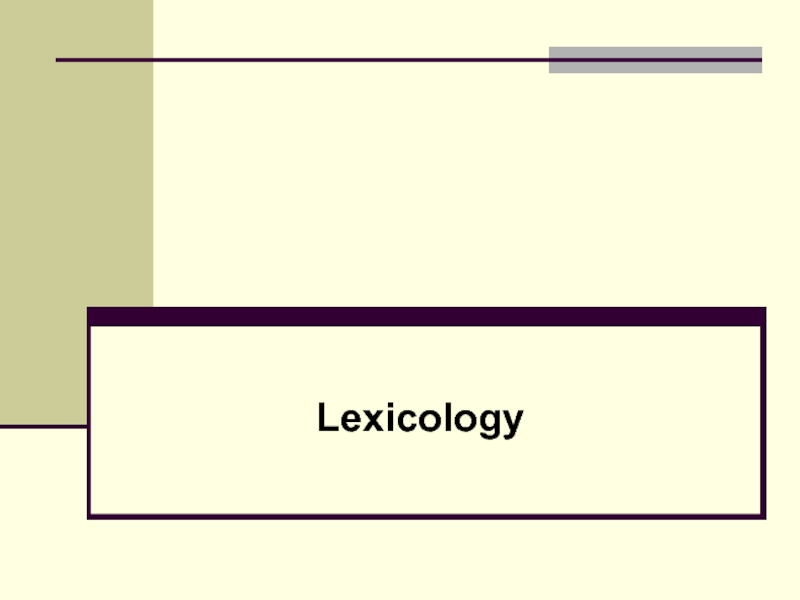
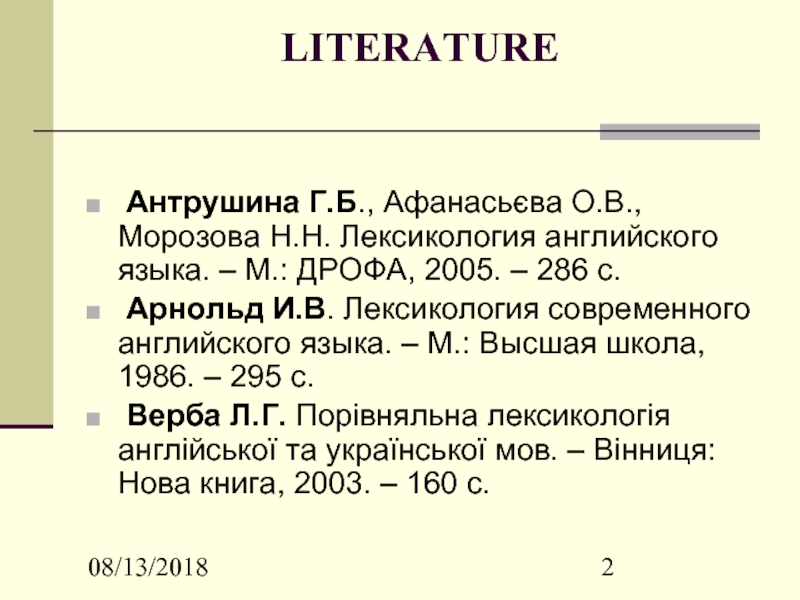

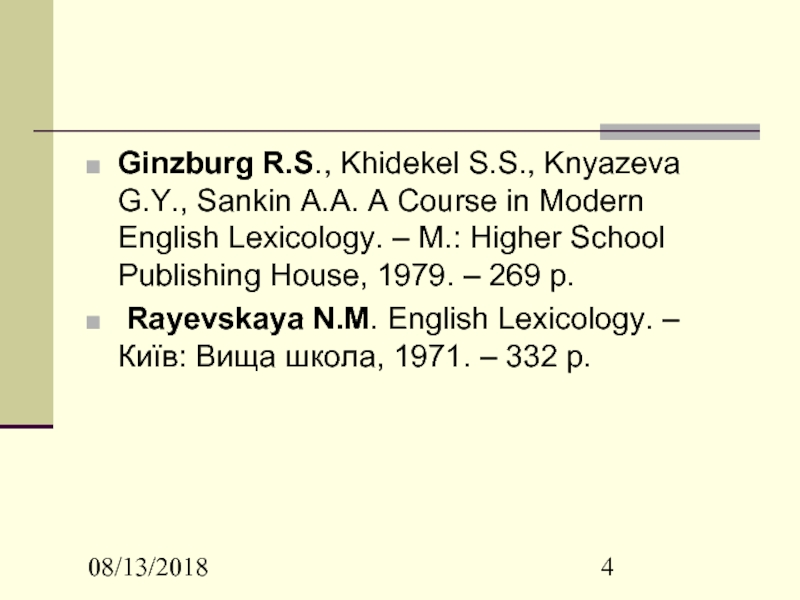
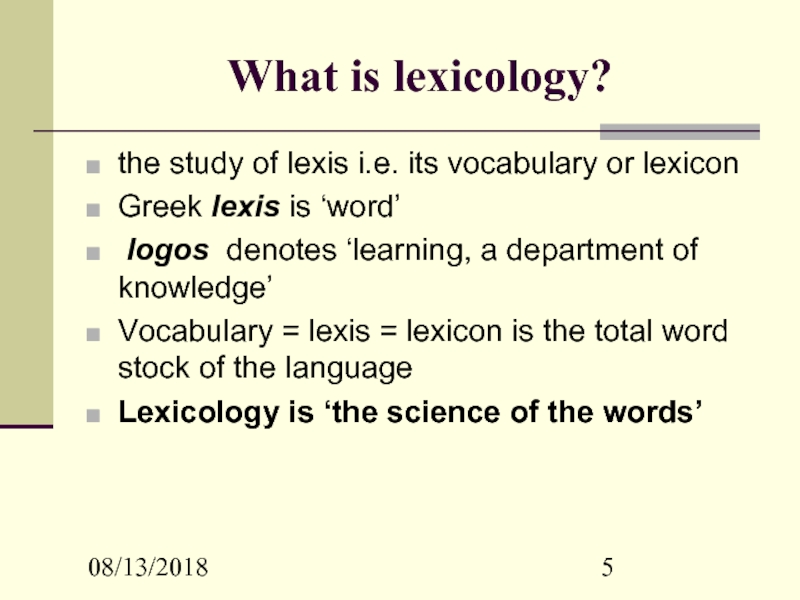
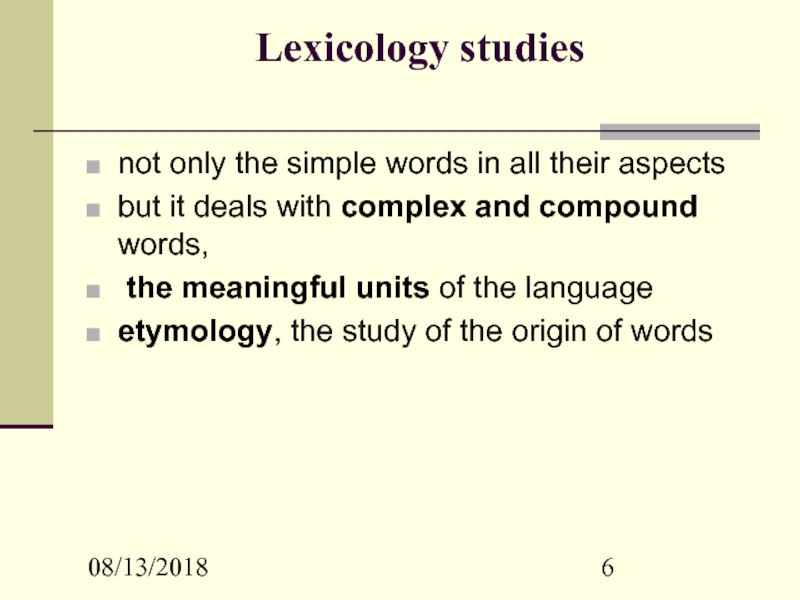
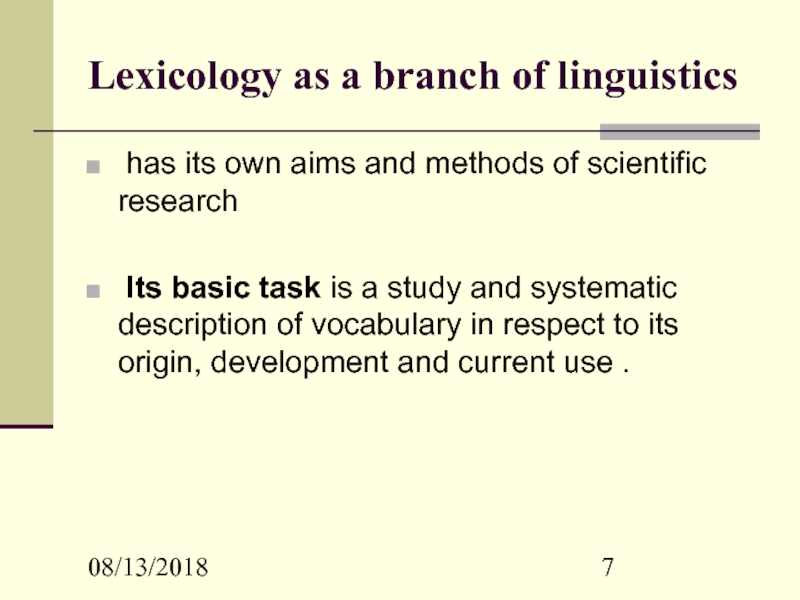
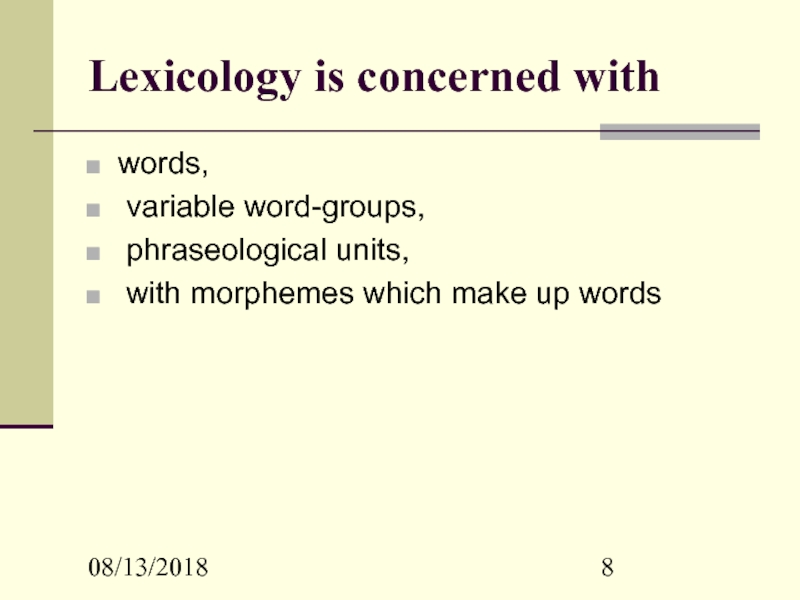
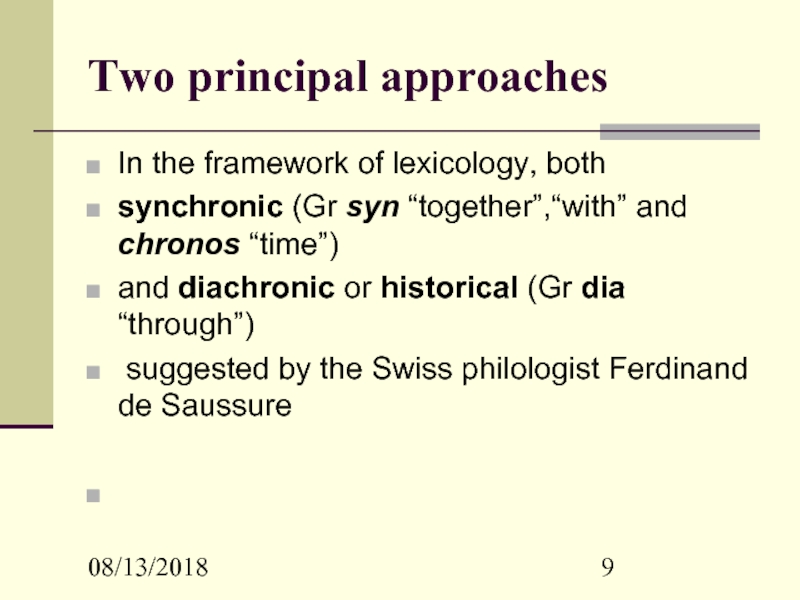
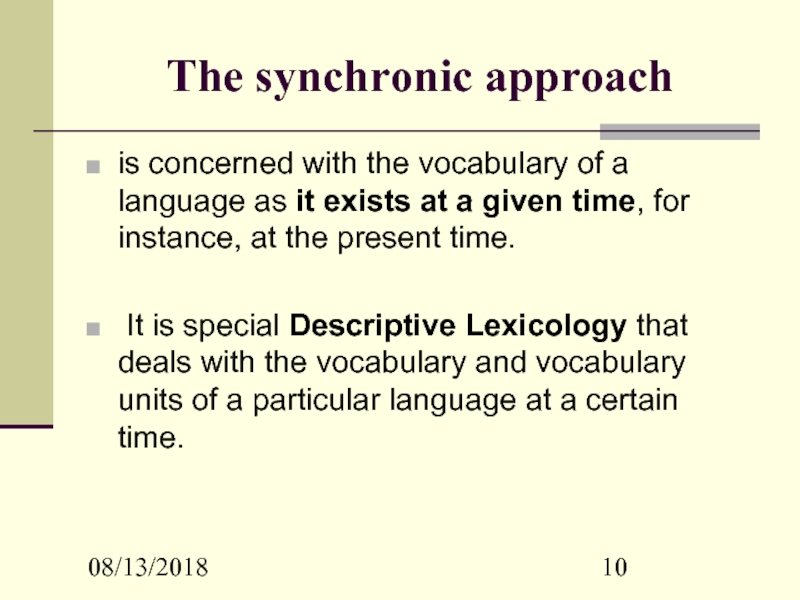
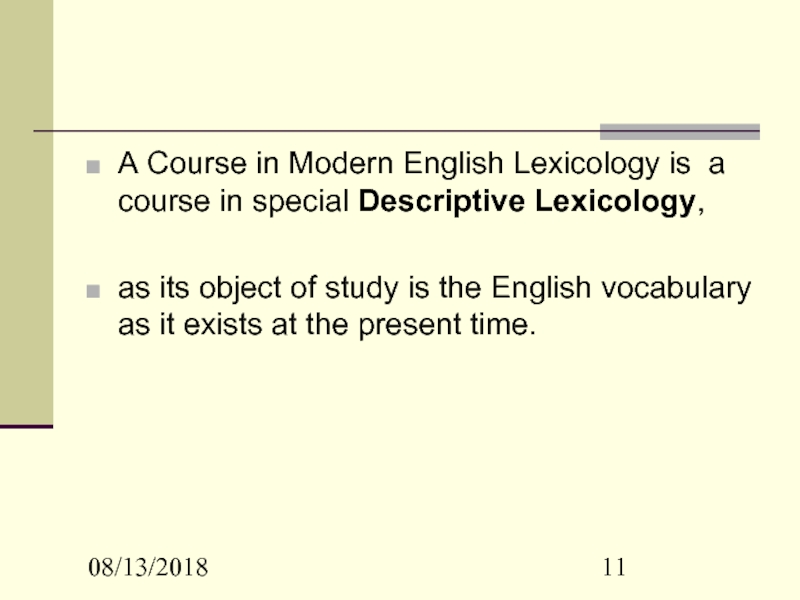

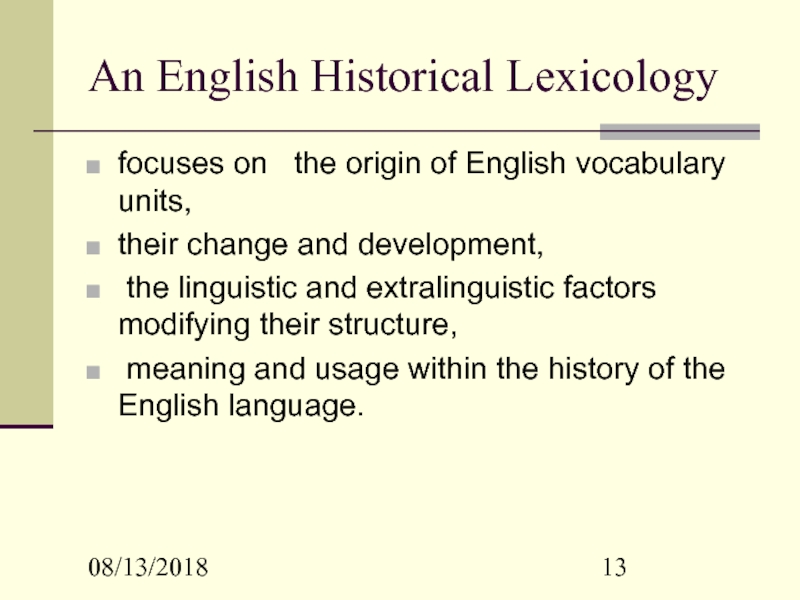
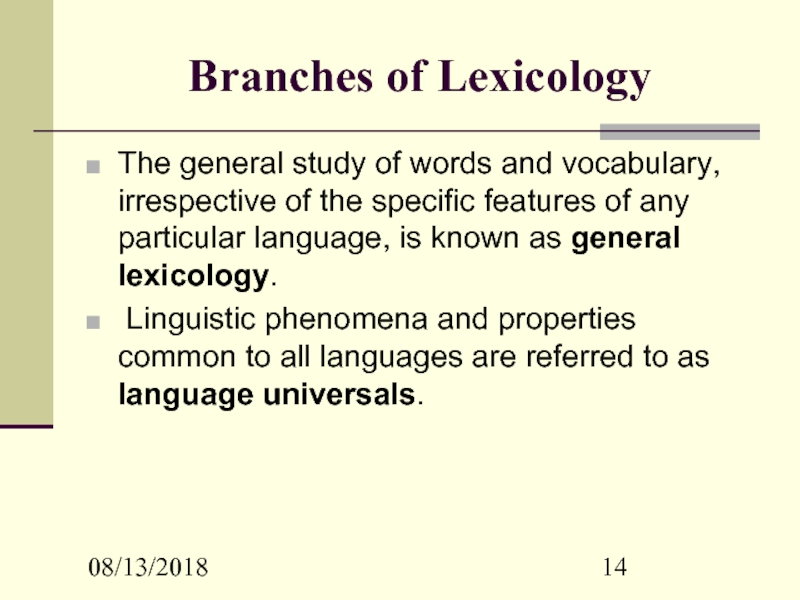
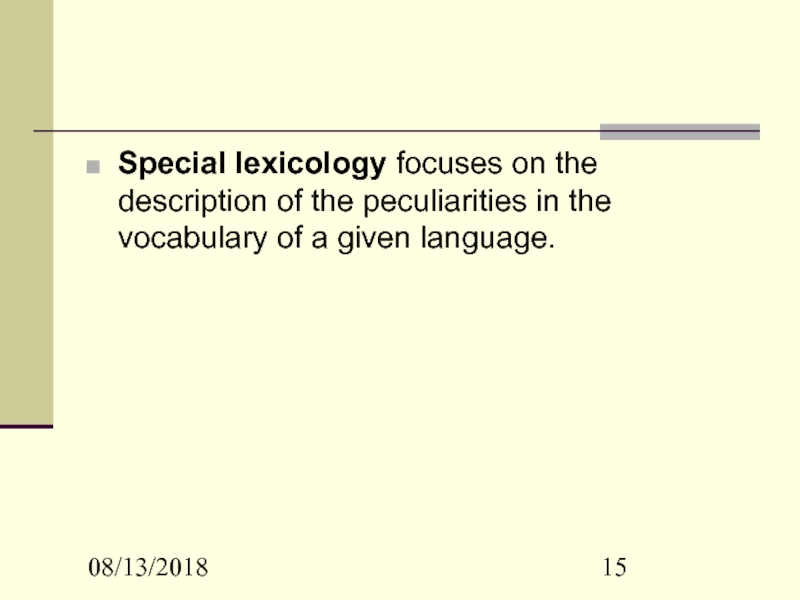
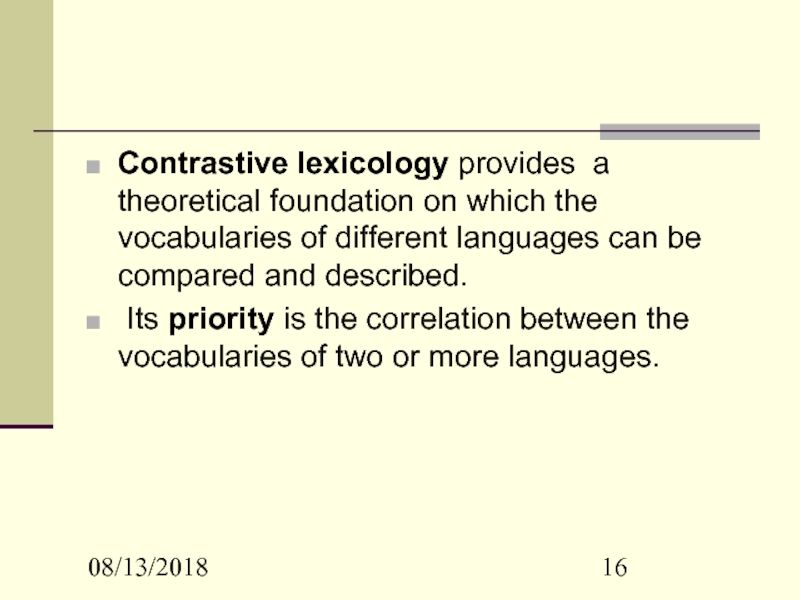
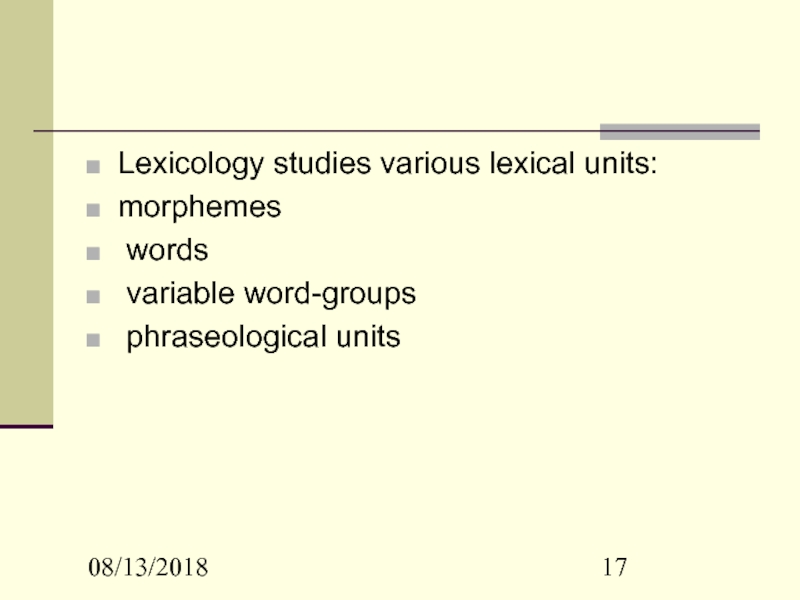
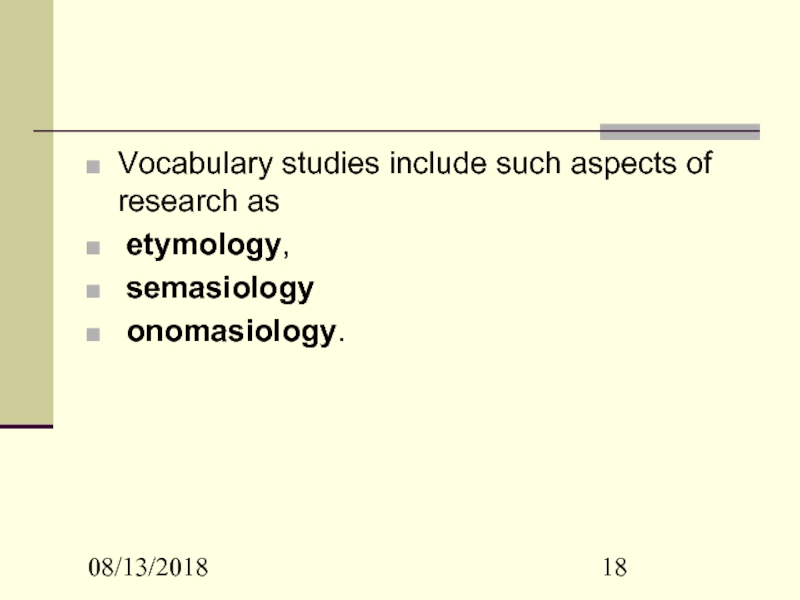
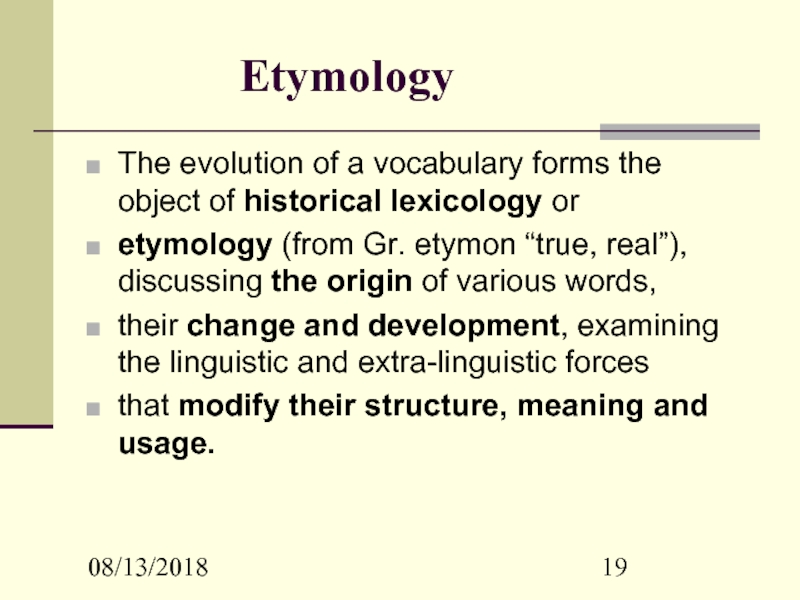
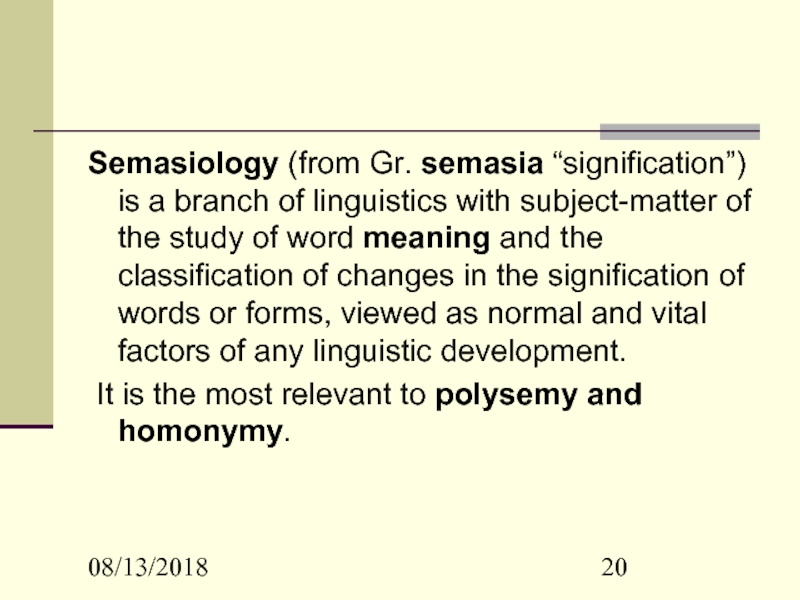
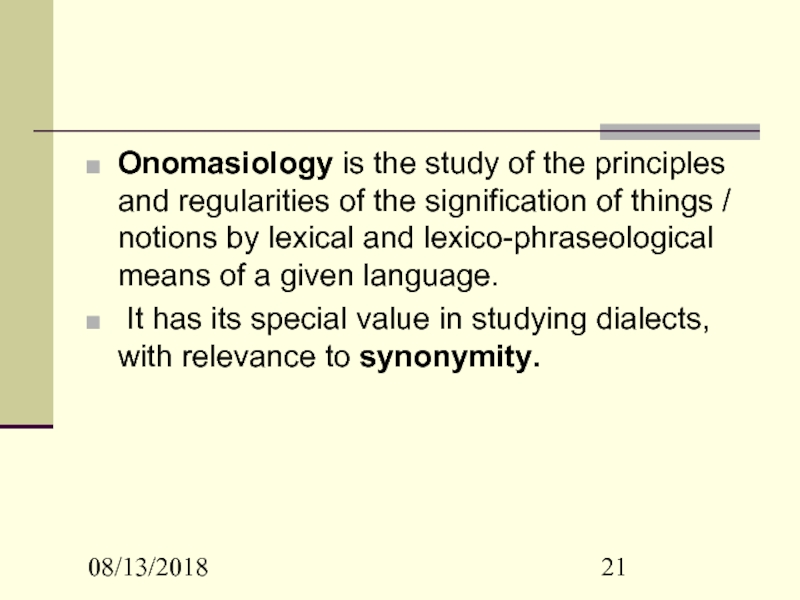
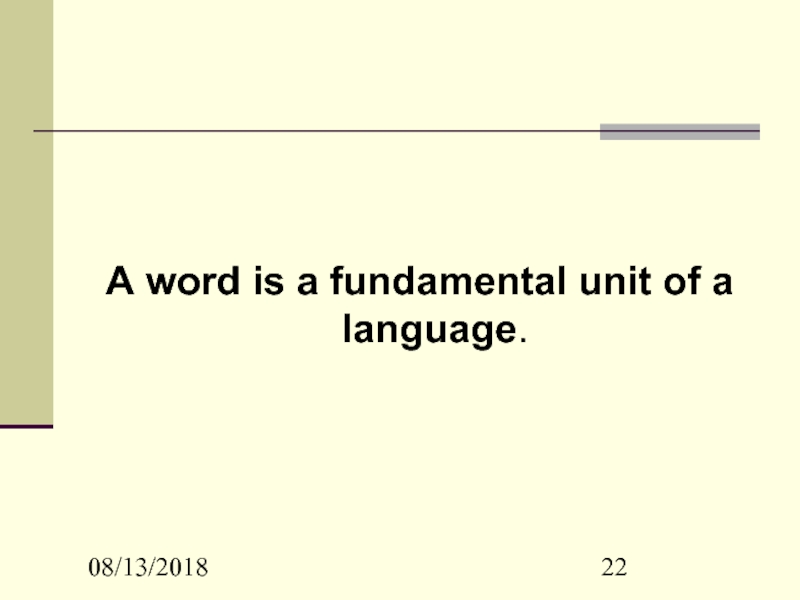
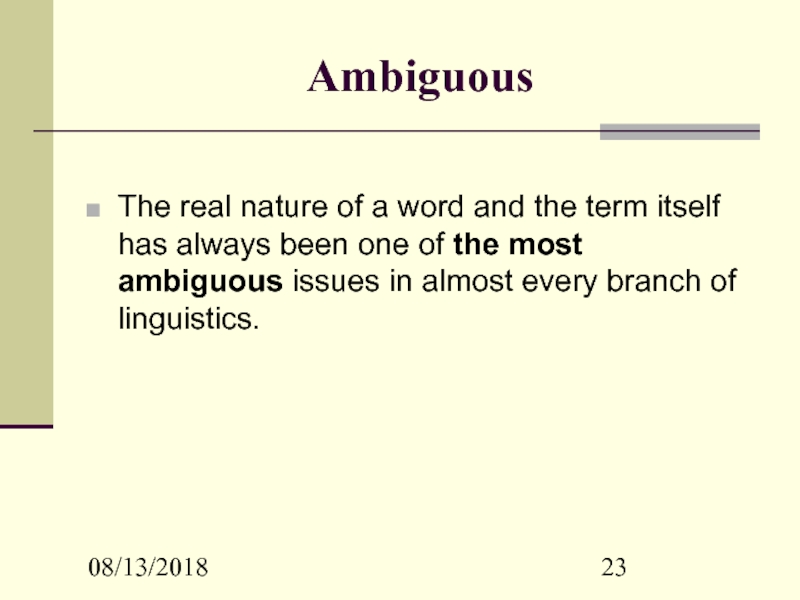
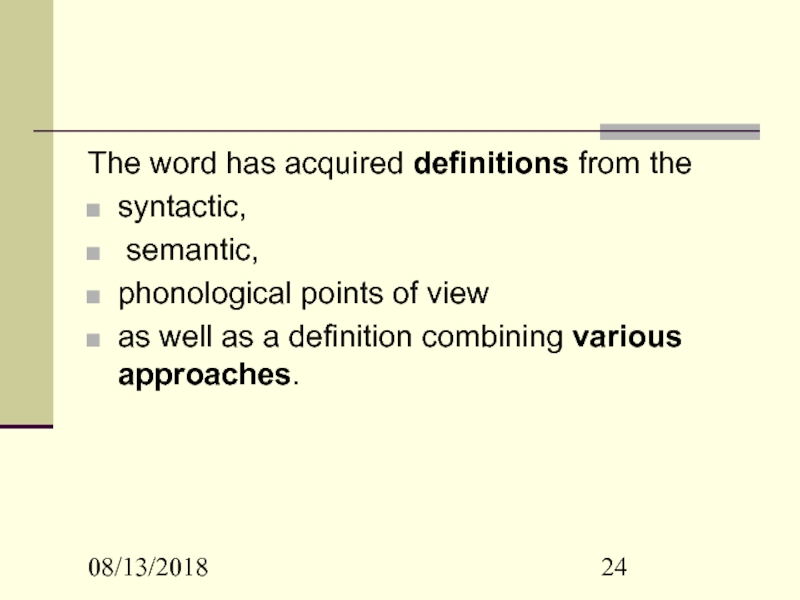
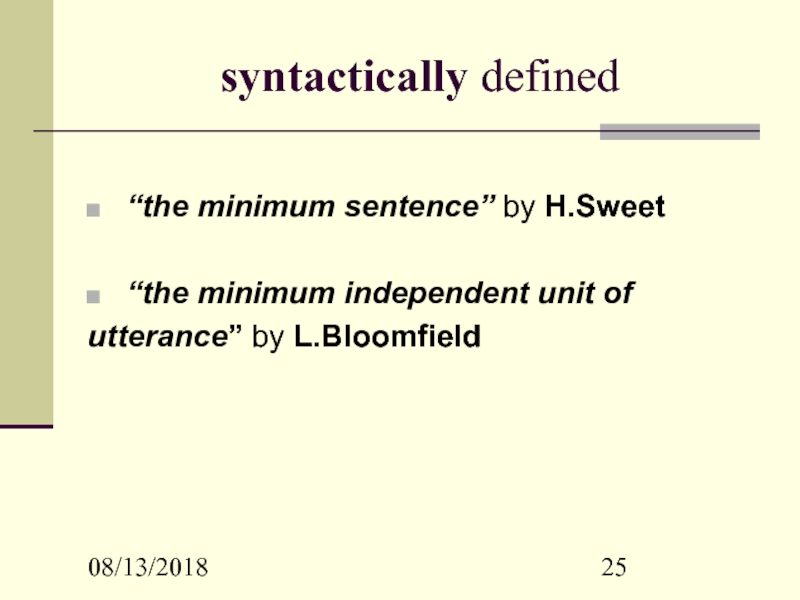
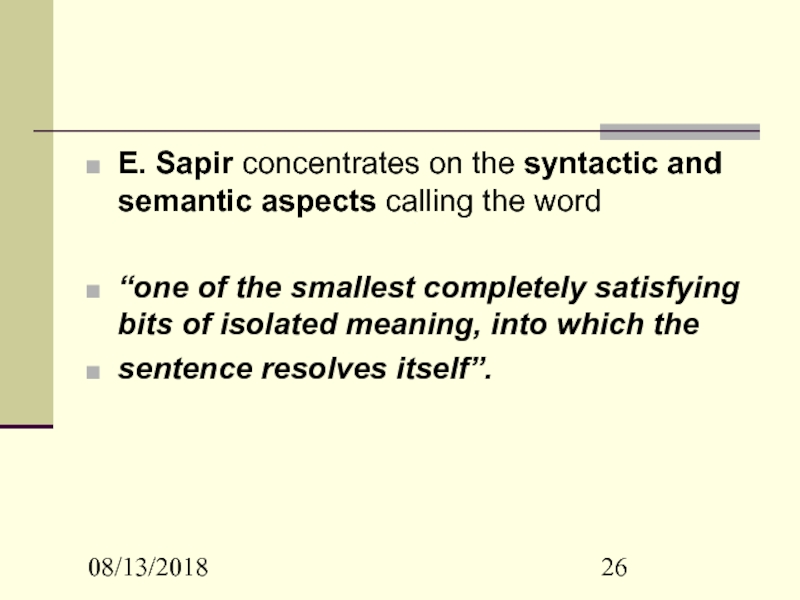
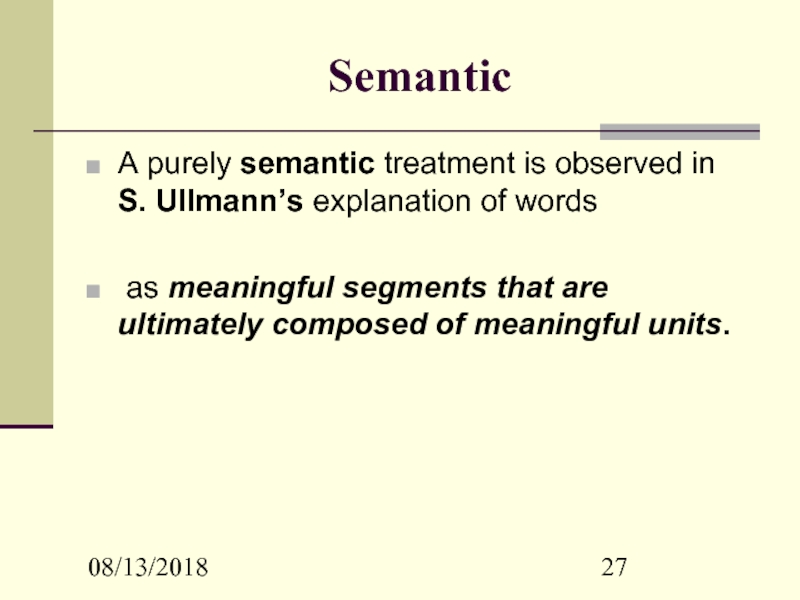
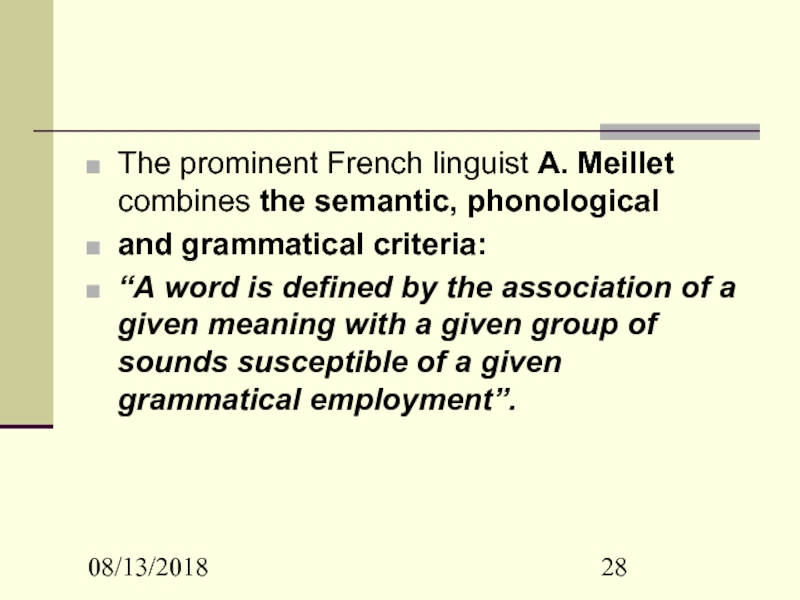
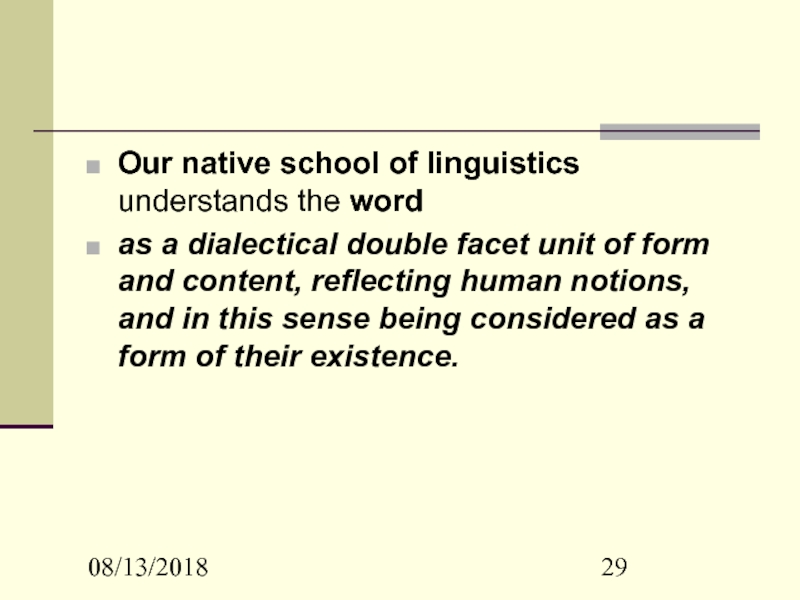
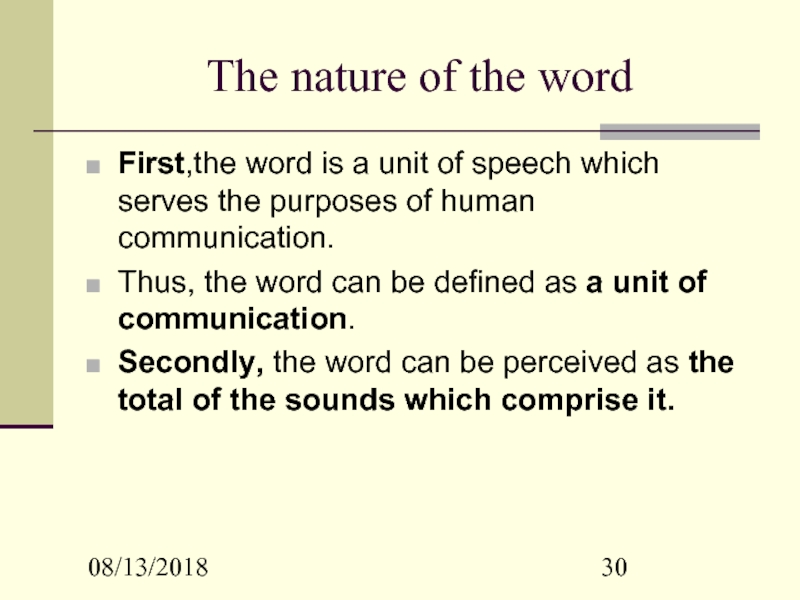
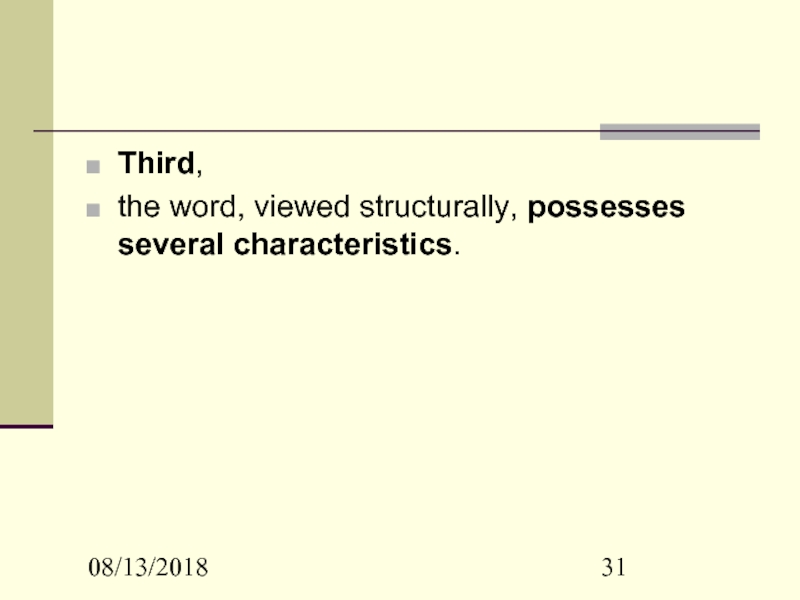
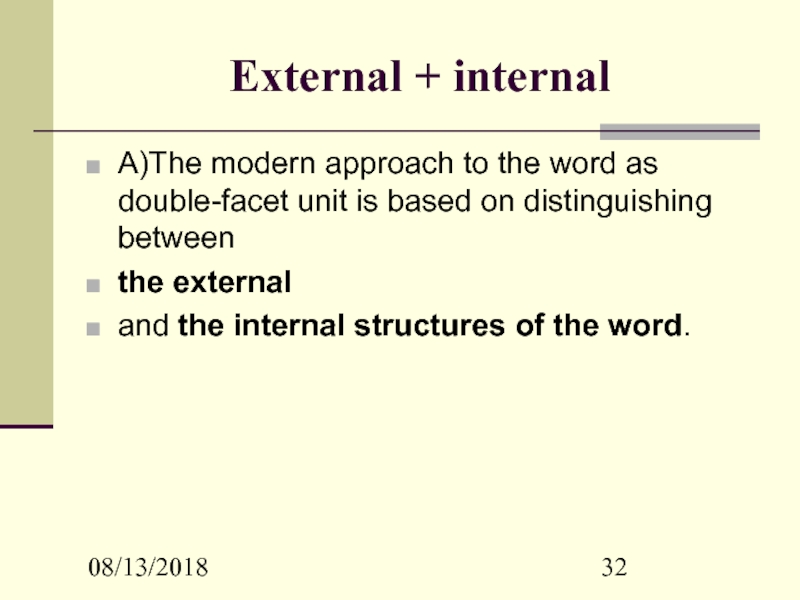
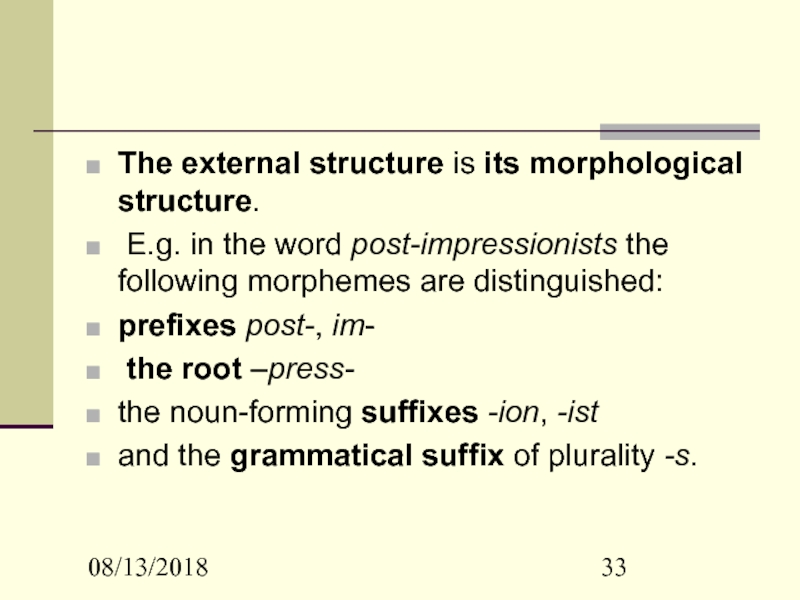
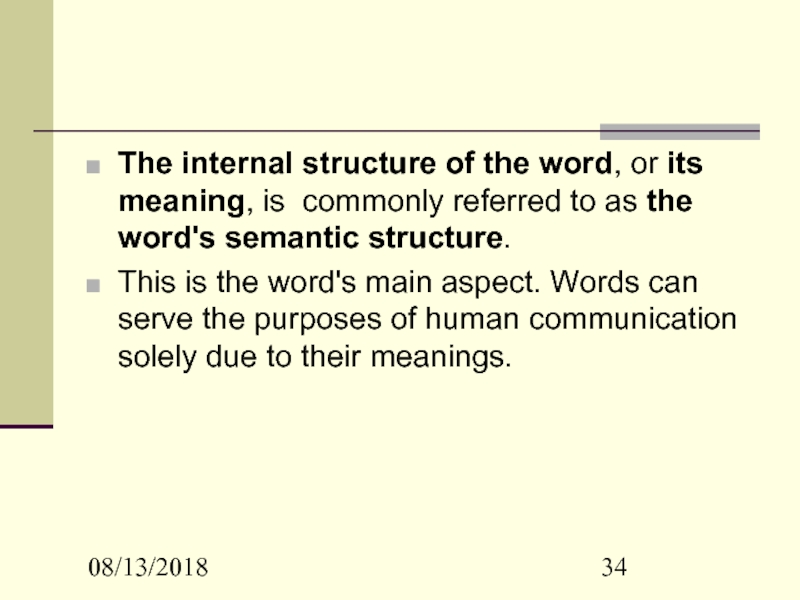
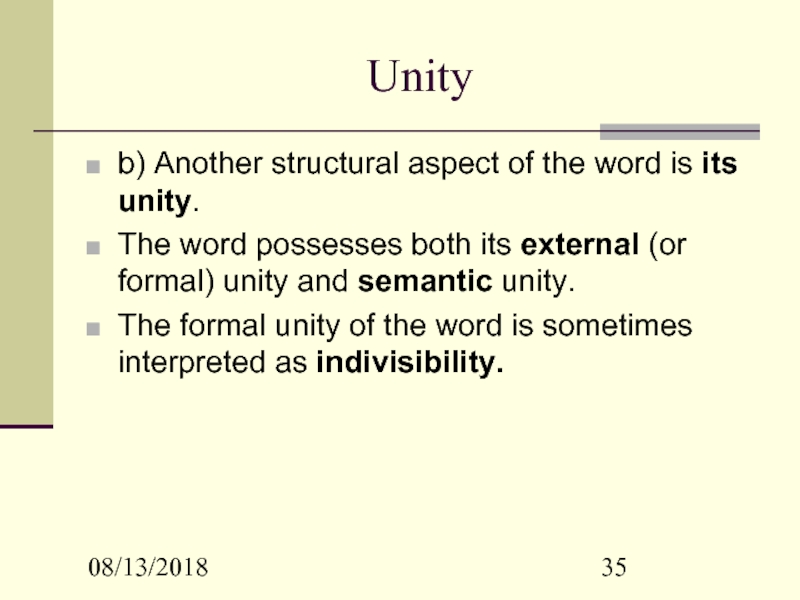
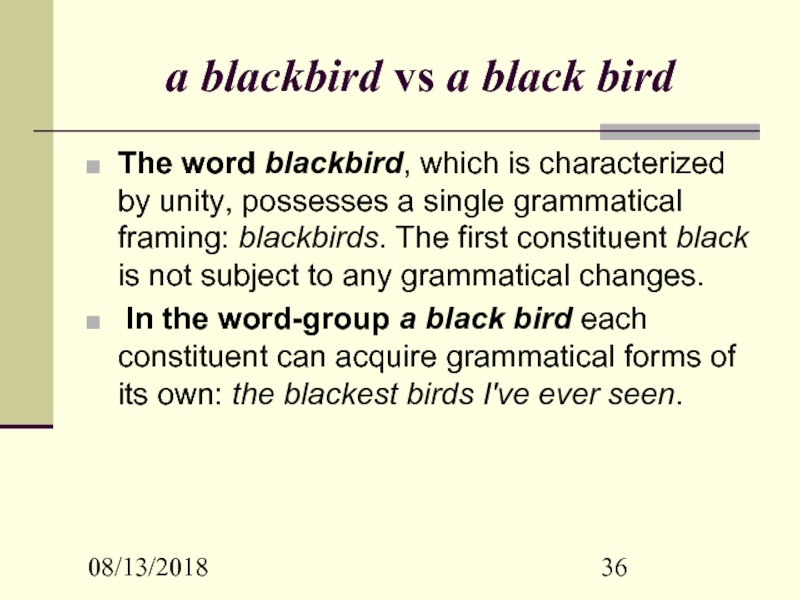
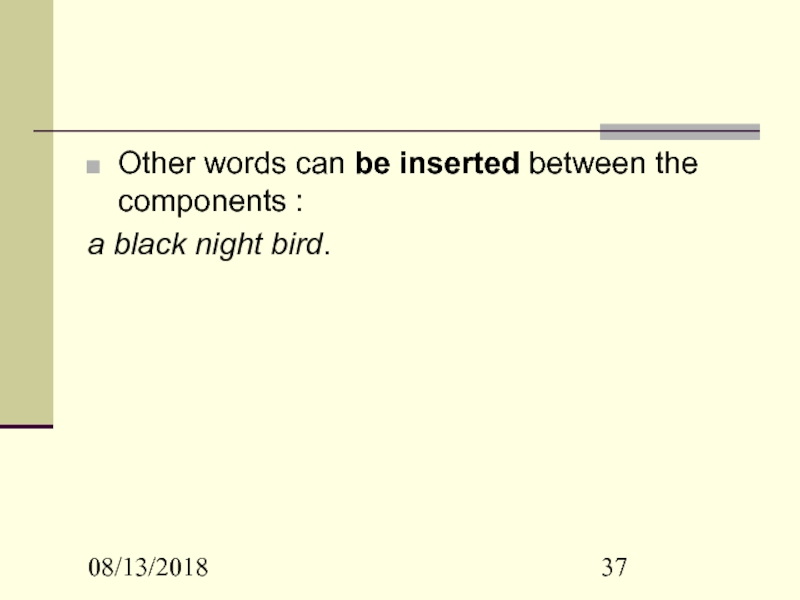
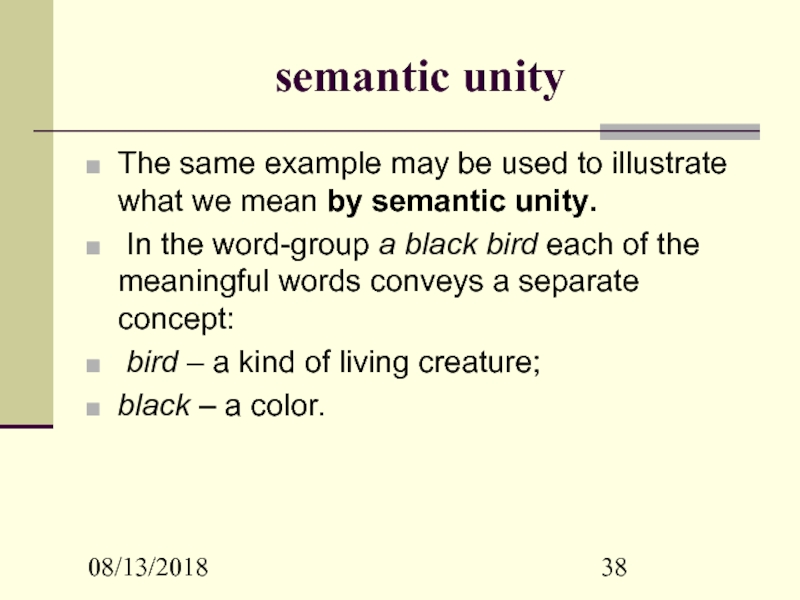
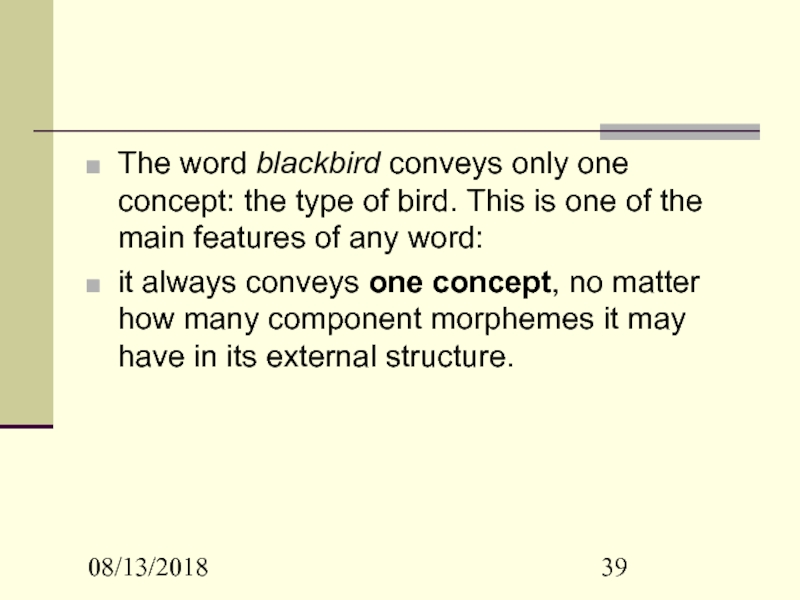
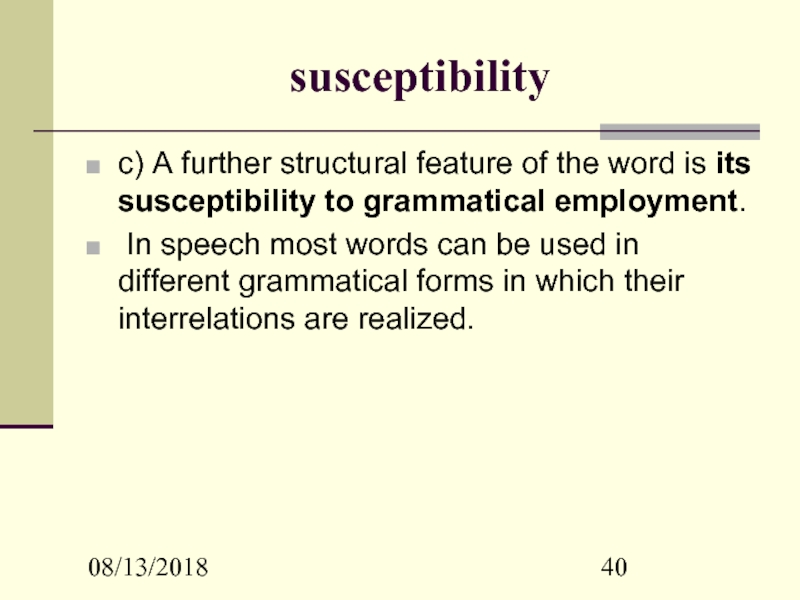
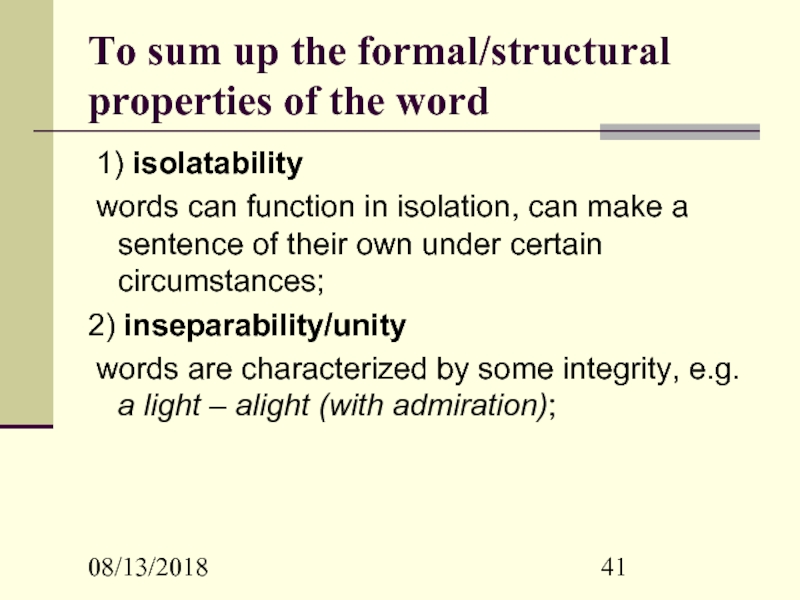
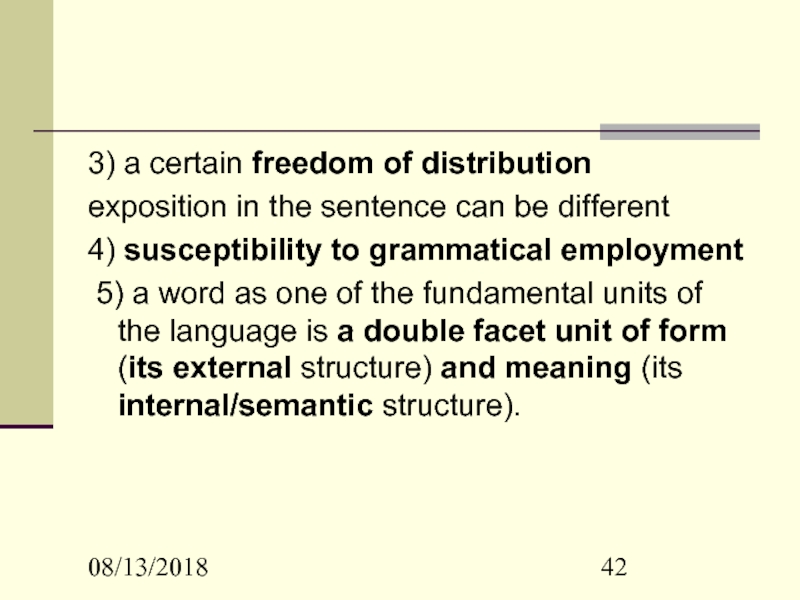
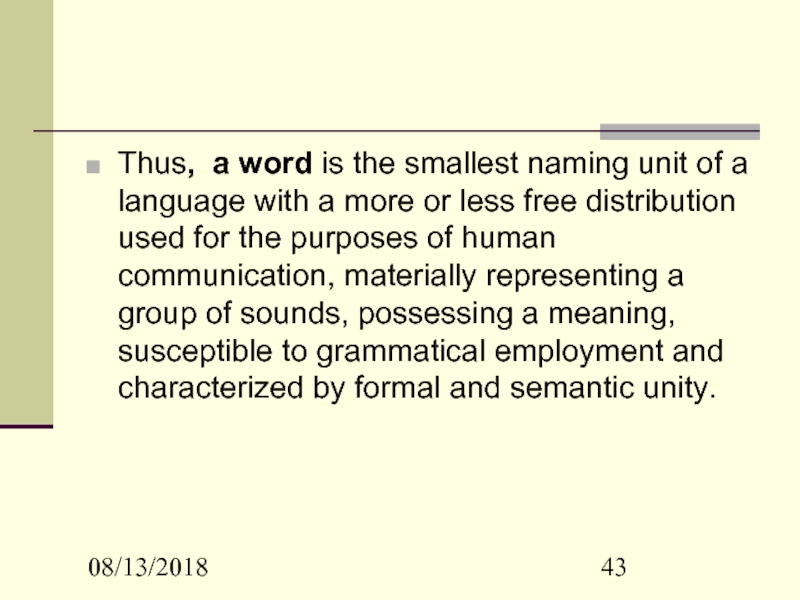
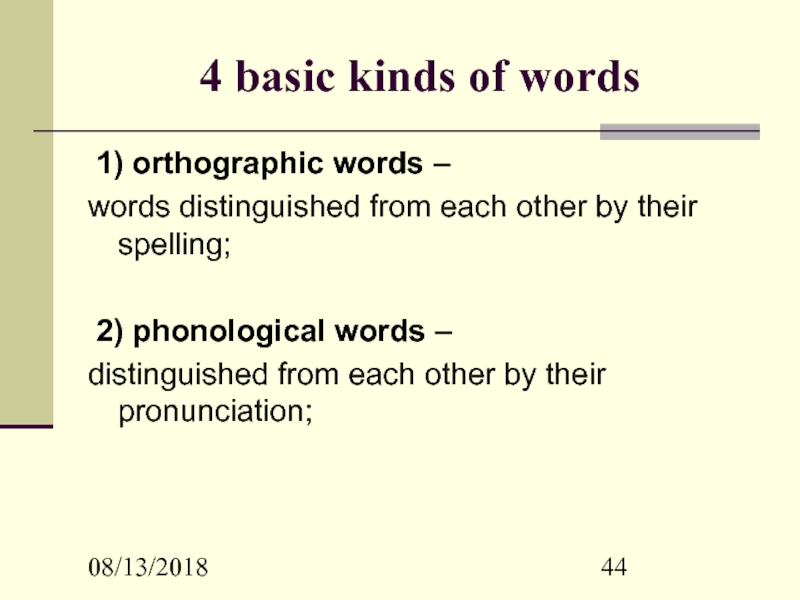


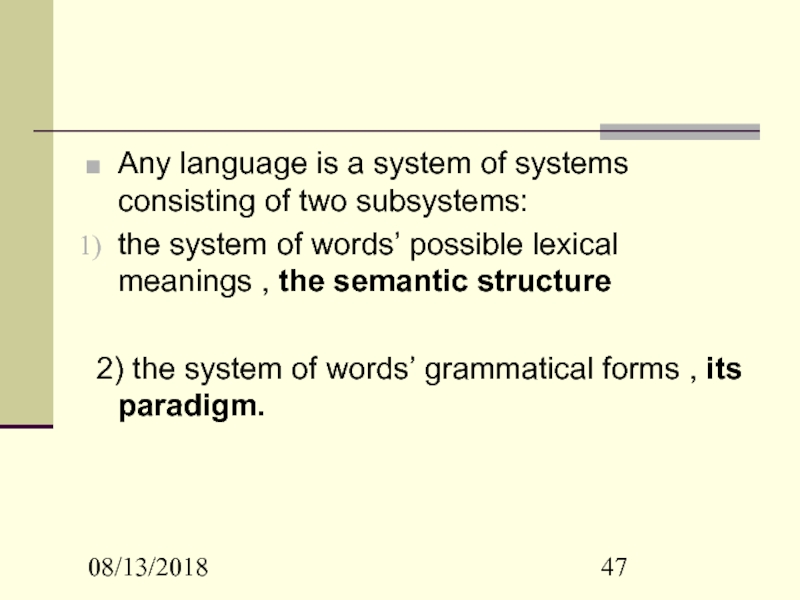
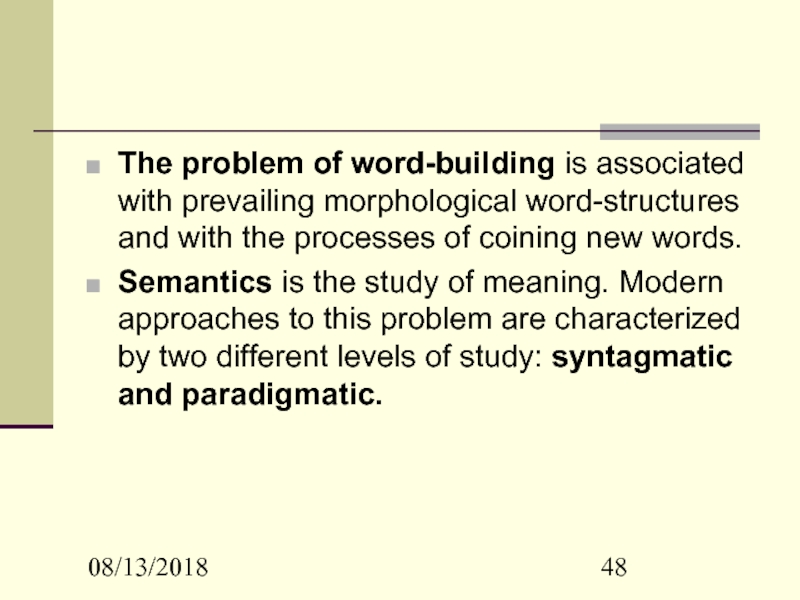
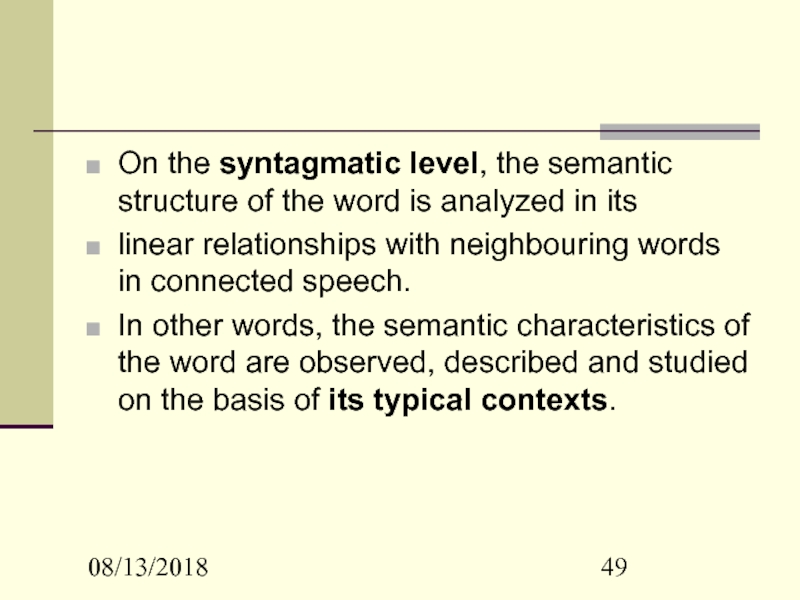
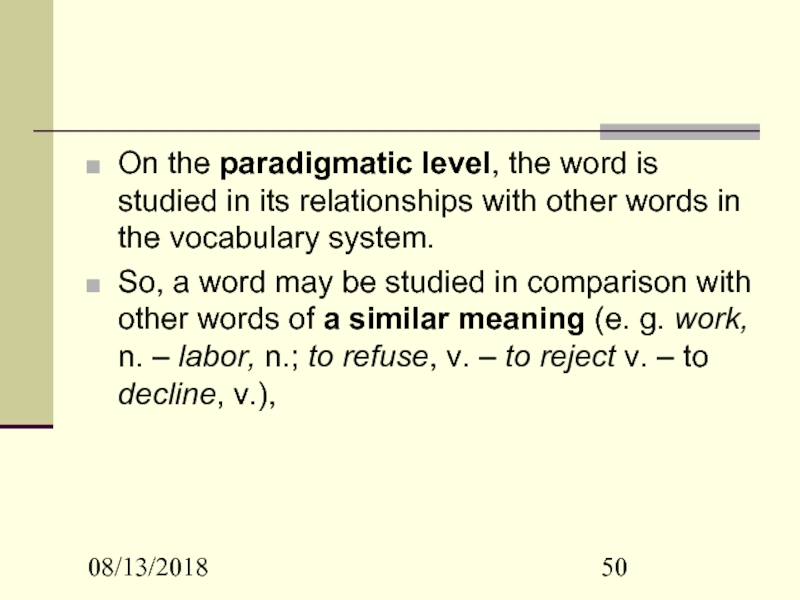
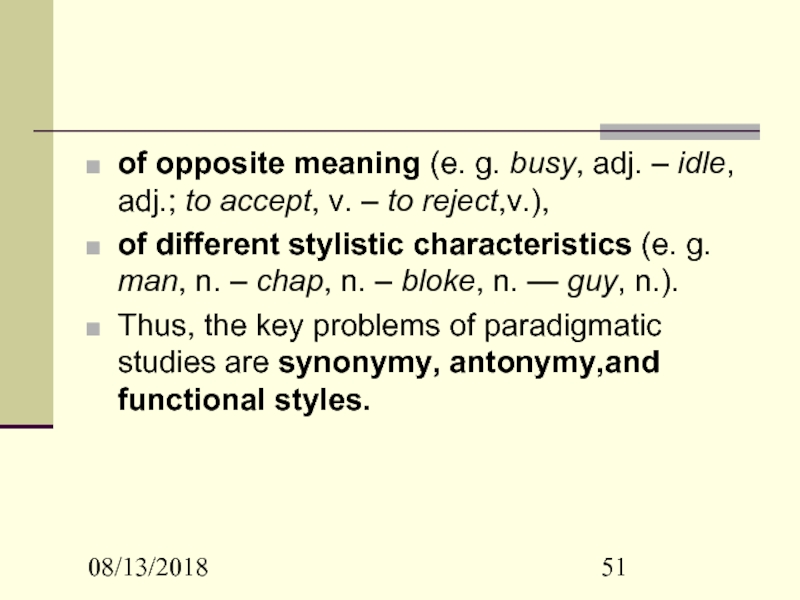
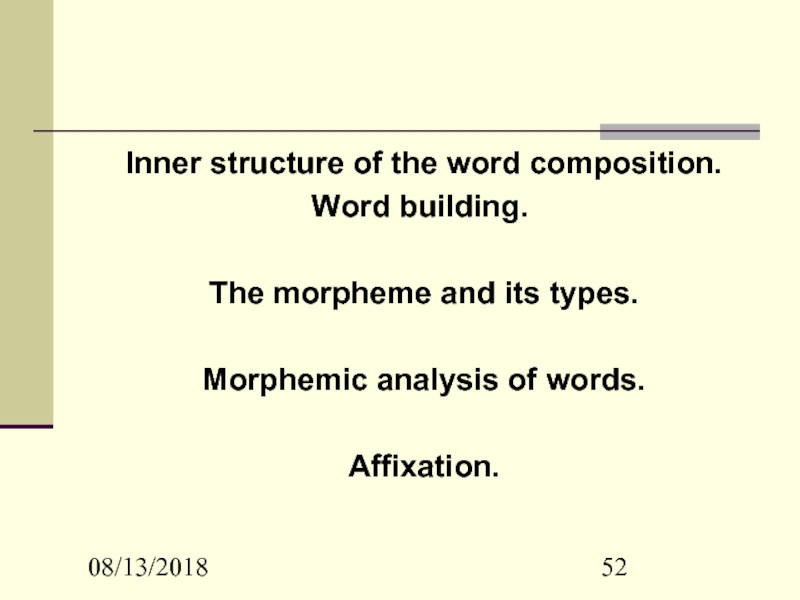
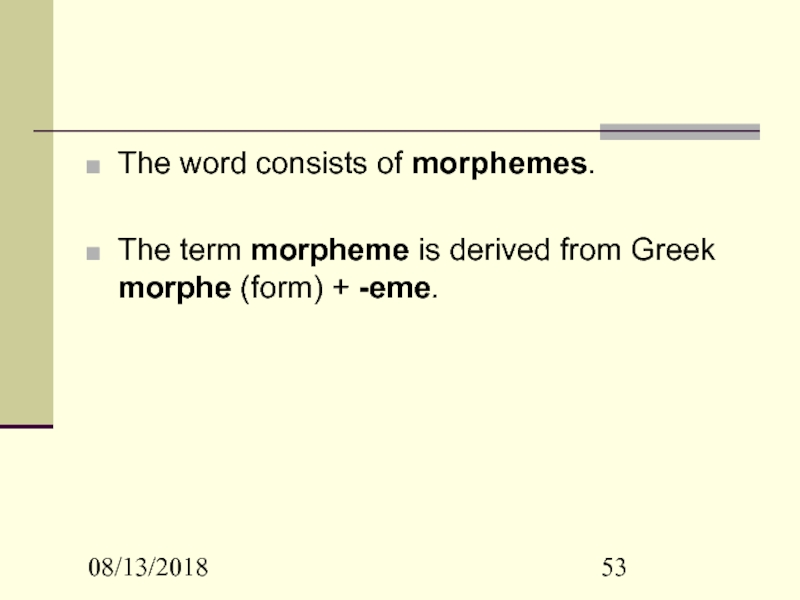
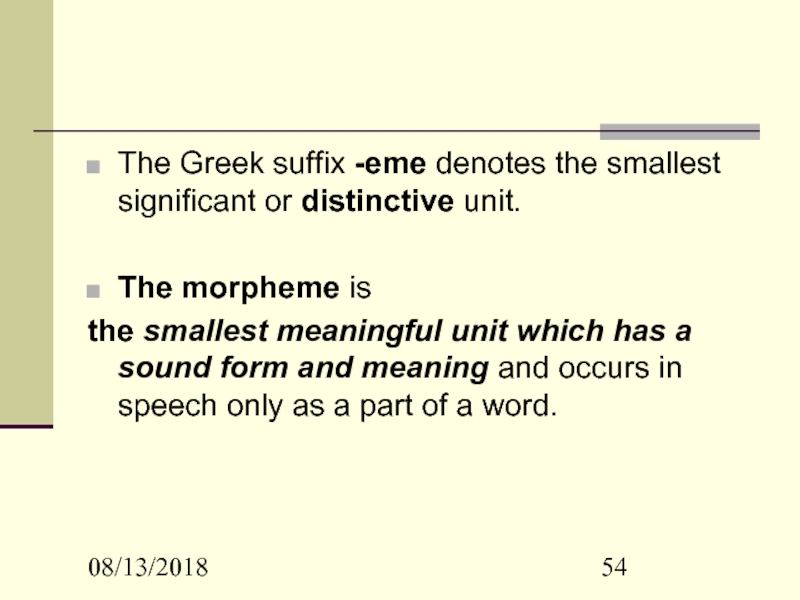
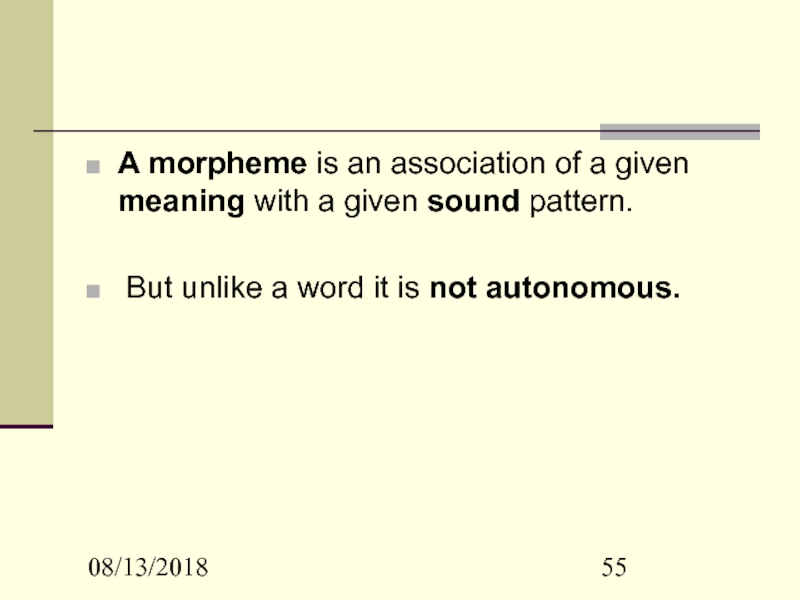
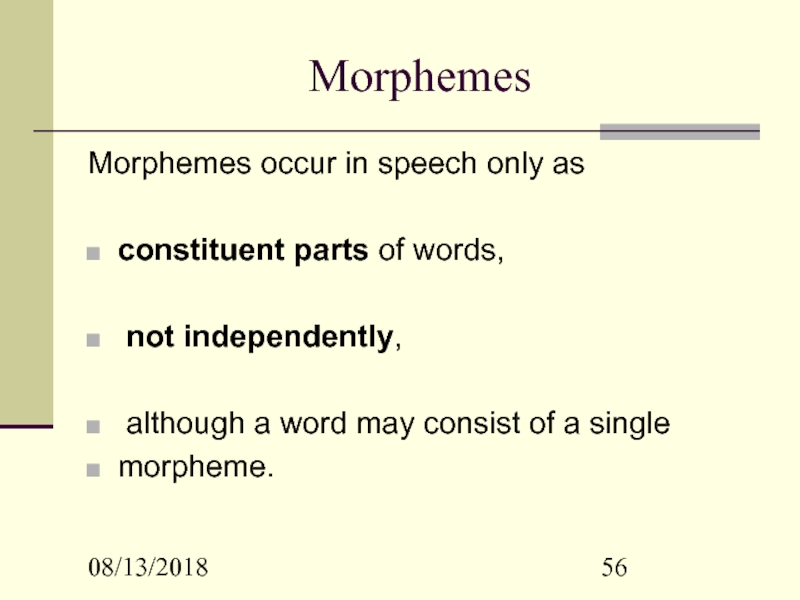
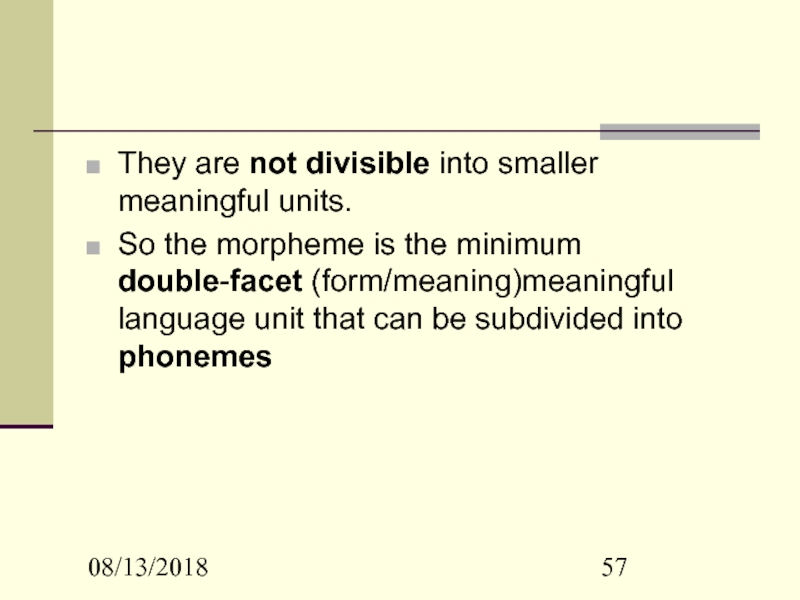
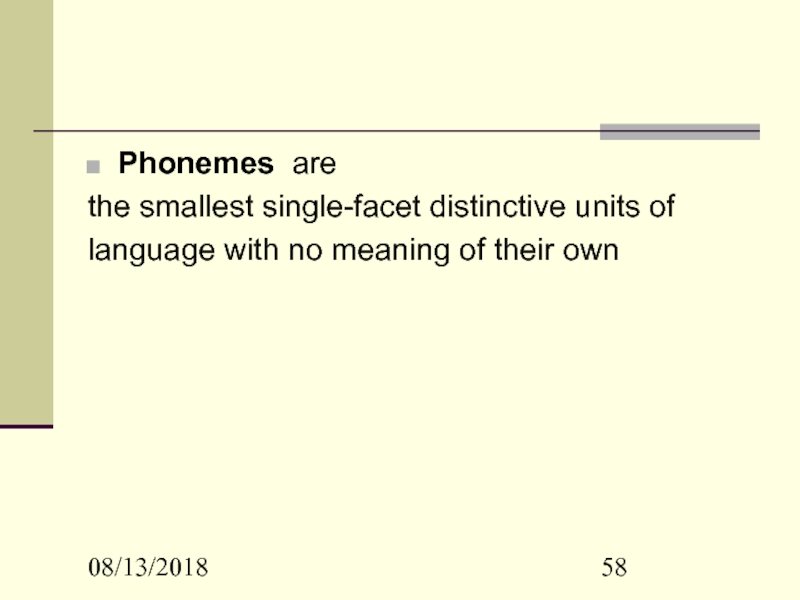
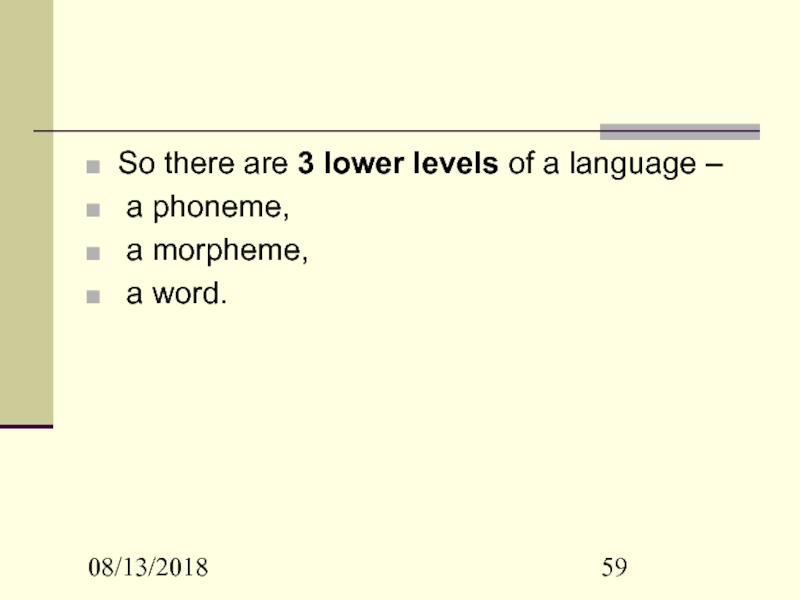
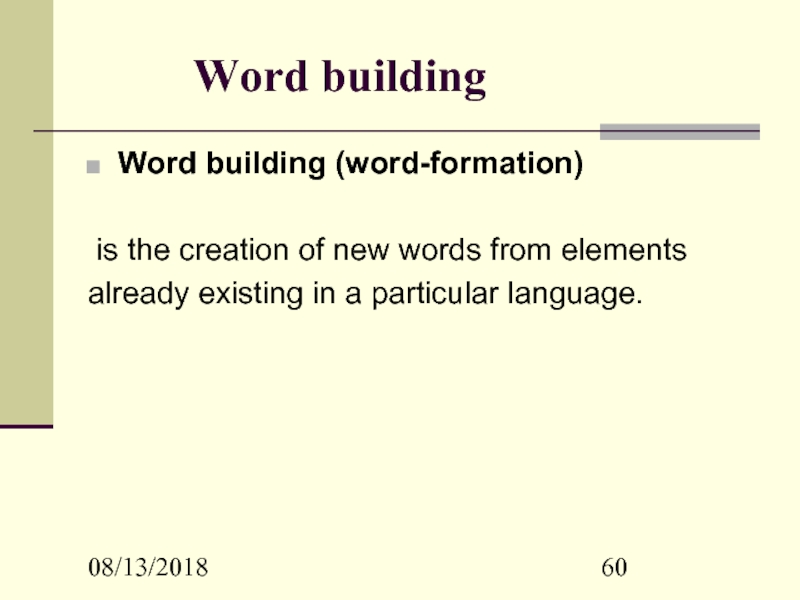
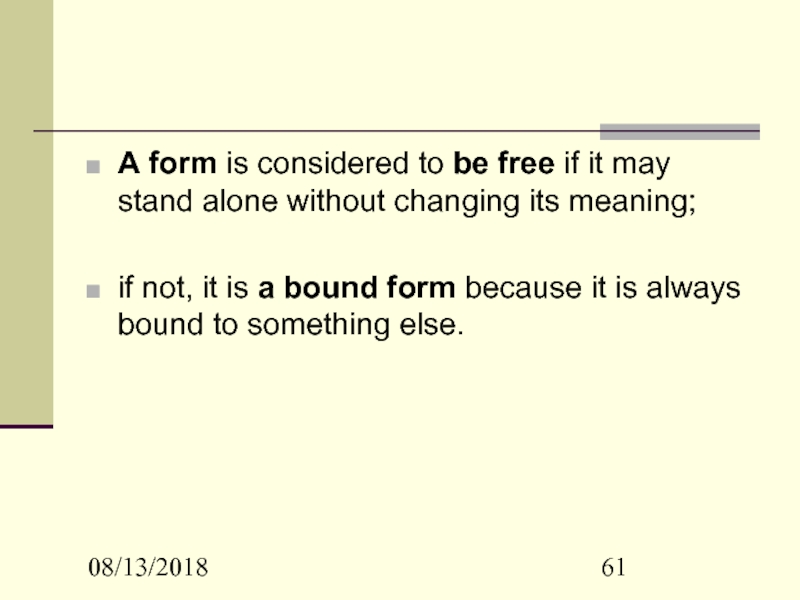
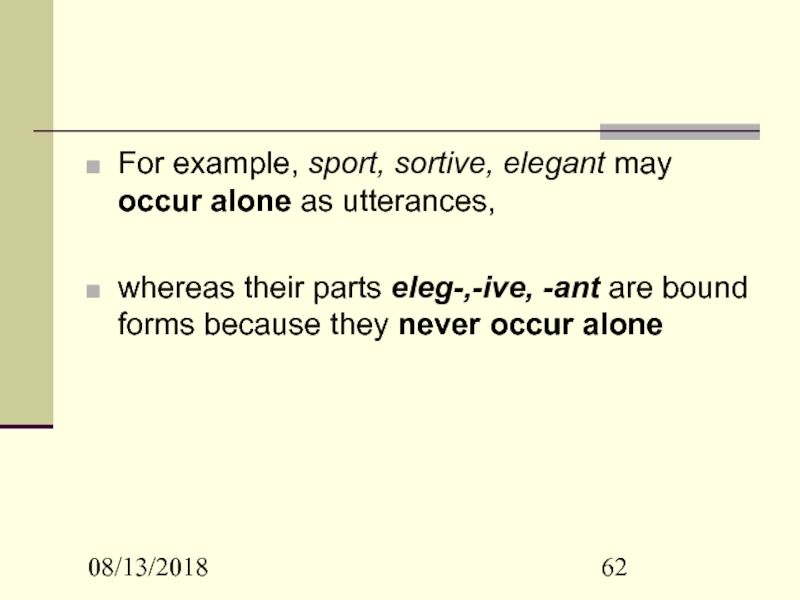
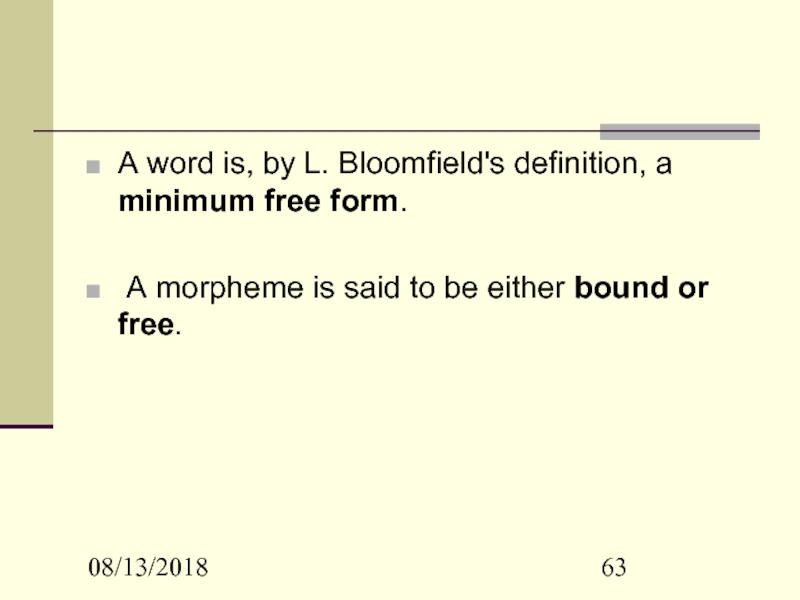
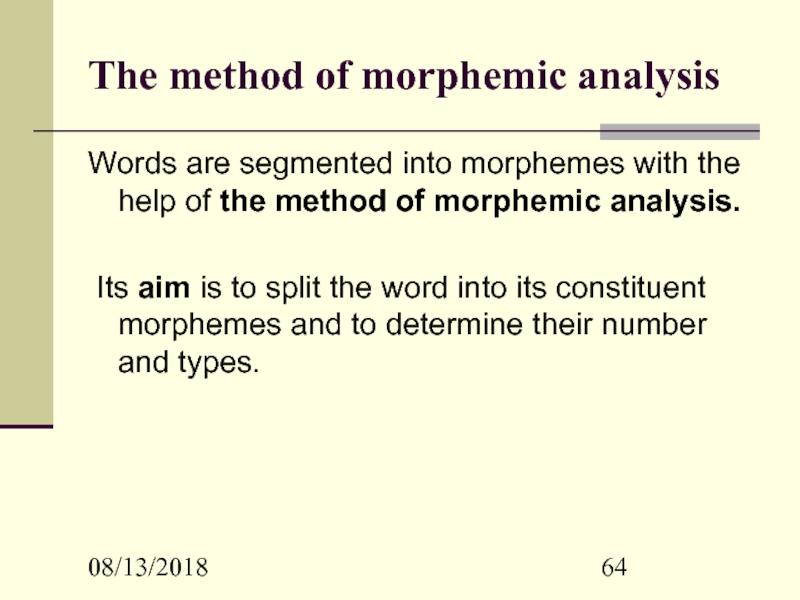
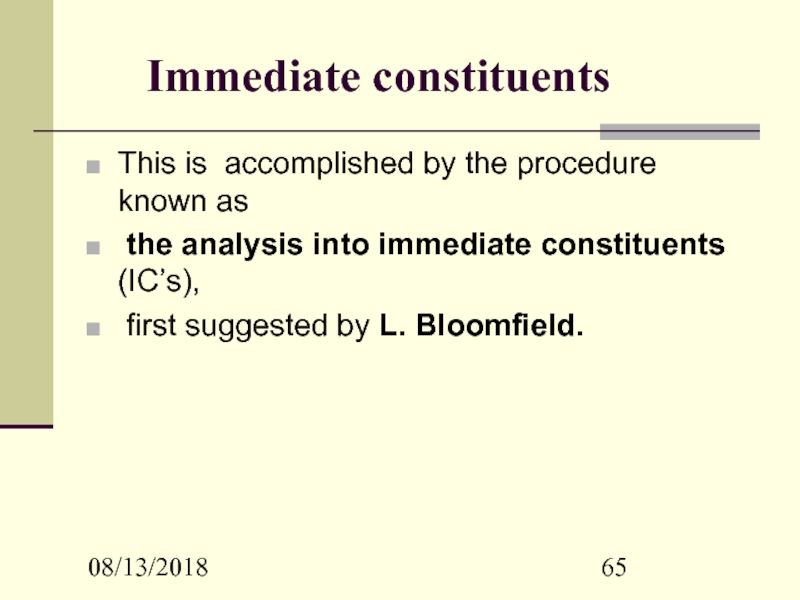
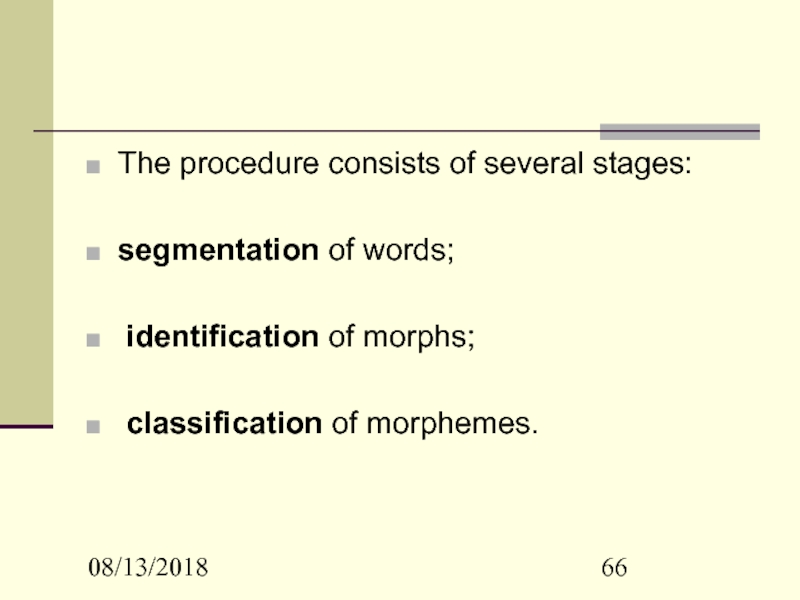
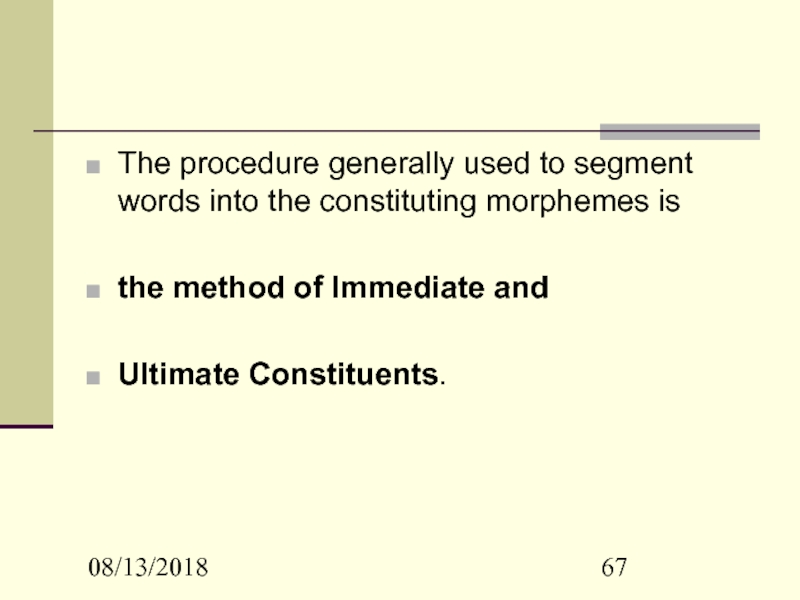
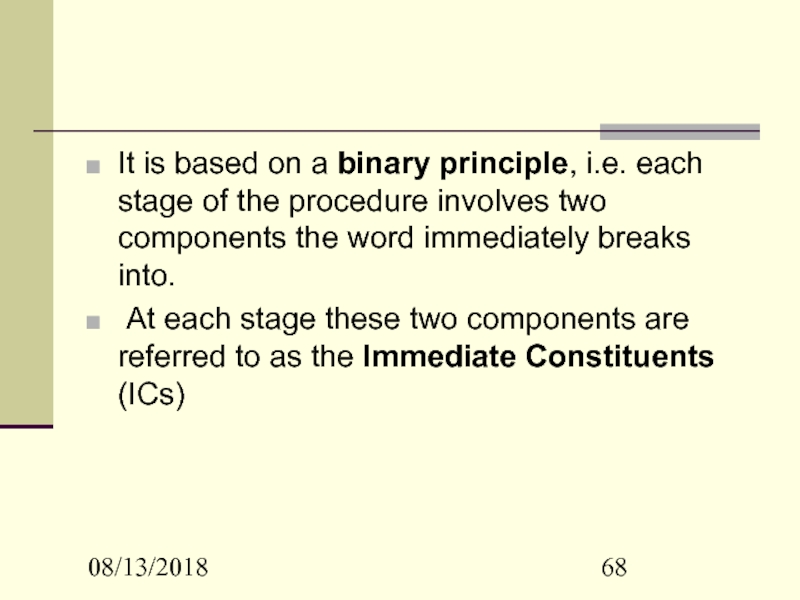
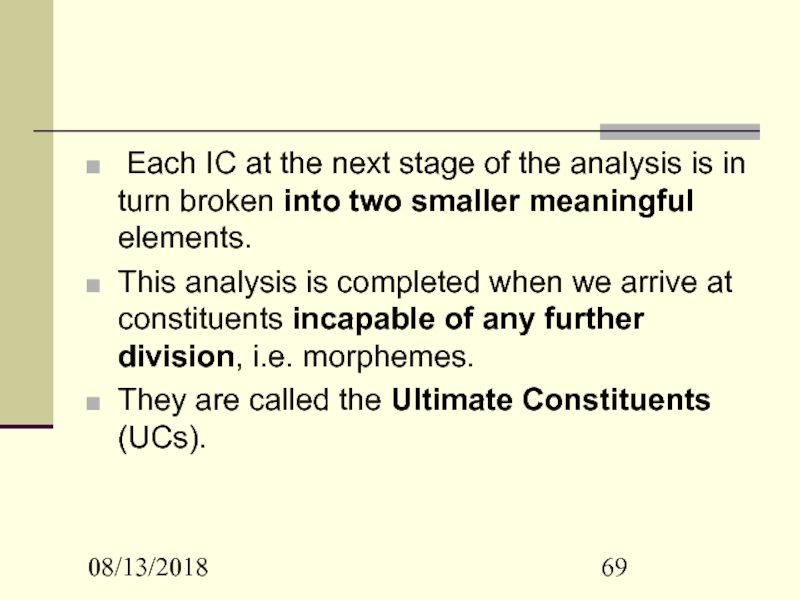
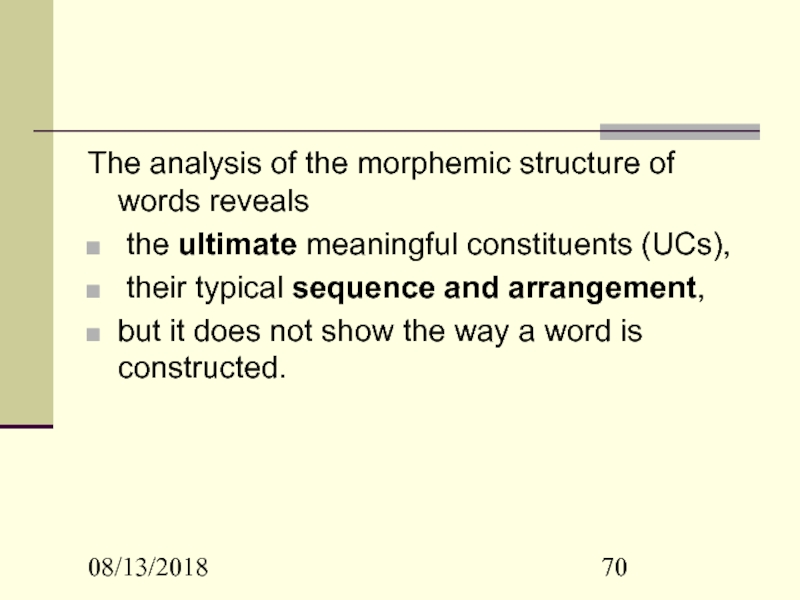
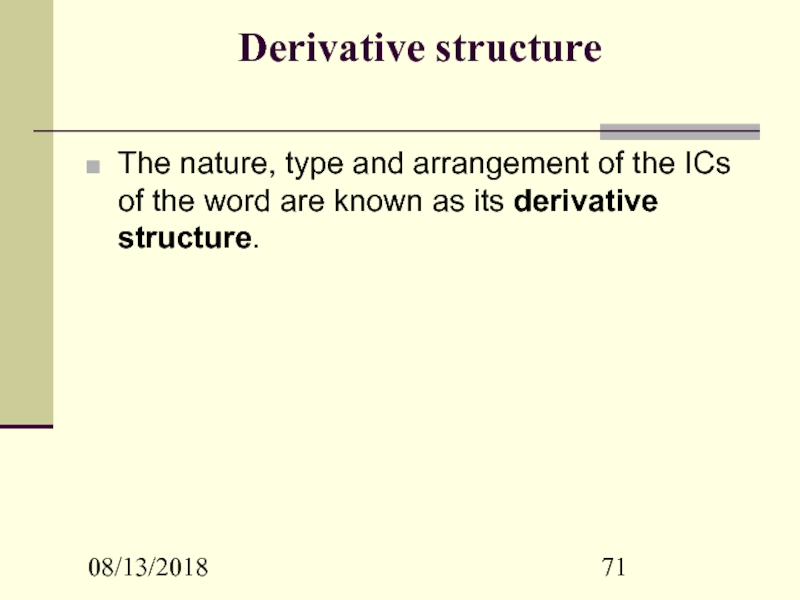
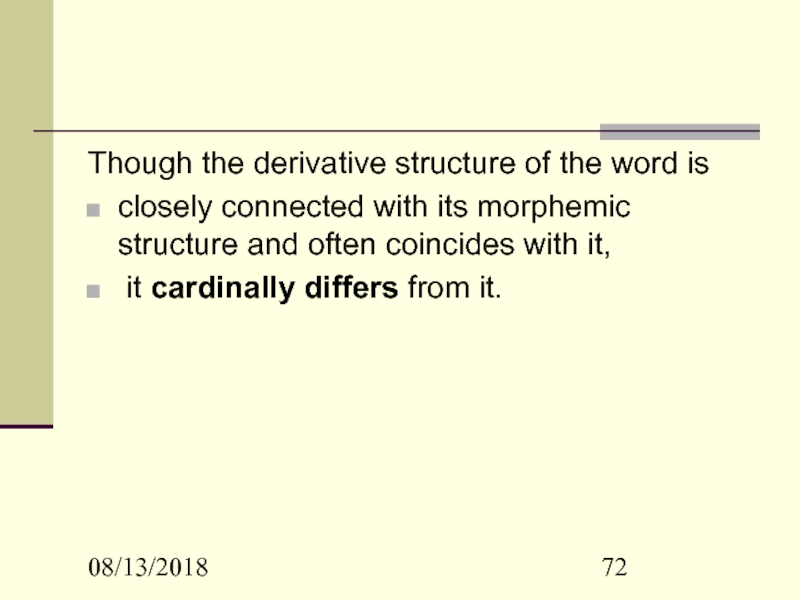
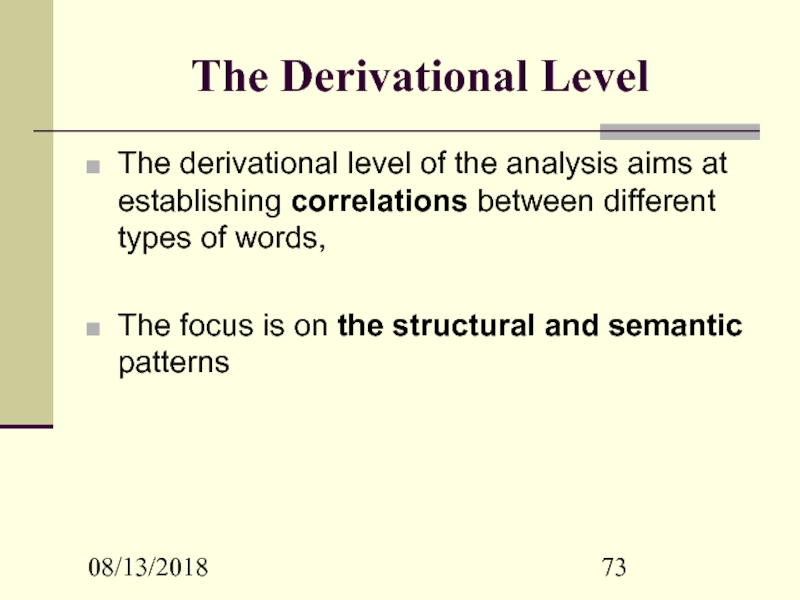
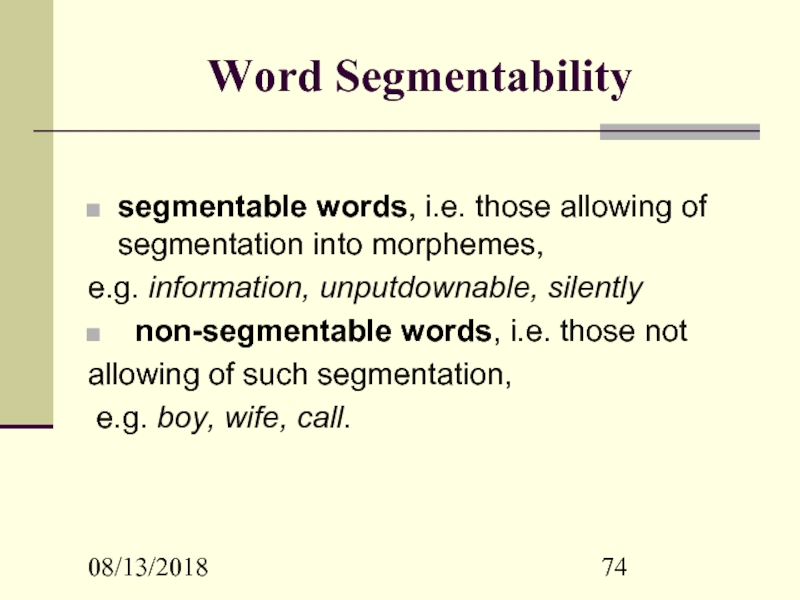
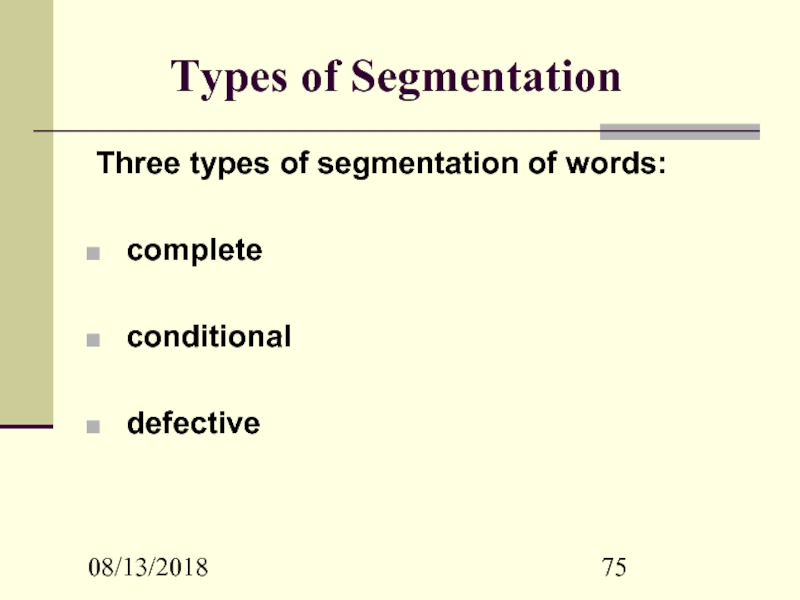
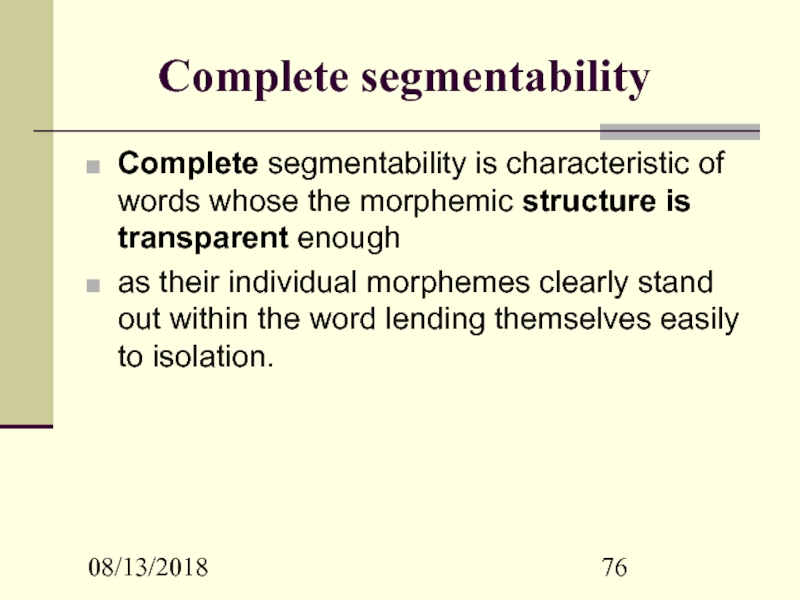
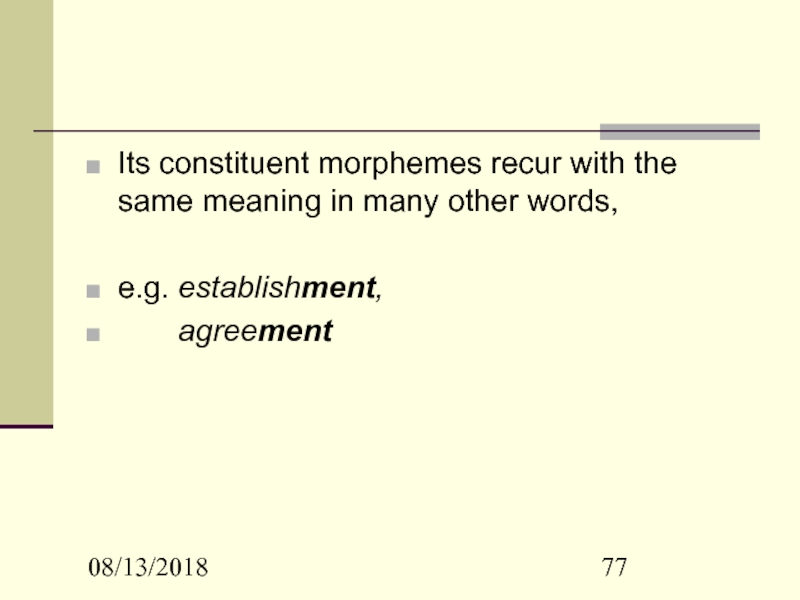
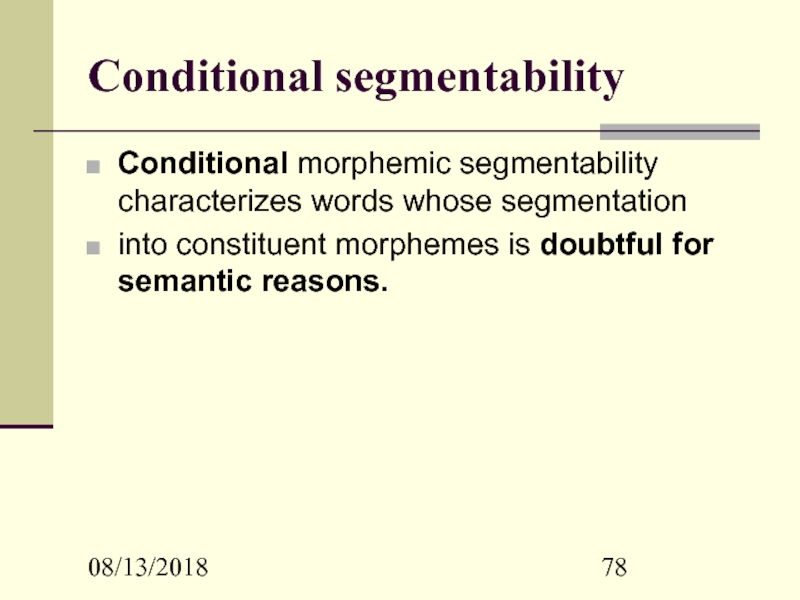
![08/13/2018E.g. retain, detain, or receive, deceive the sound-clusters [ri], [di], on the one hand, can](/img/tmb/2/181816/bad4e115f3b6a12b16b368f735d40c5a-800x.jpg)
![08/13/2018Neither the sound-clusters [ri], [di] nor the sound-clusters [-tein], [si:v] have any lexical or functional](/img/tmb/2/181816/4dac7b1e951825ba889aacc1f438d665-800x.jpg)
